Ademco 8DLLYNXREN-6 Wireless Controll Communicator User Manual PREK14114 8 ii
Honeywell International Inc. Wireless Controll Communicator PREK14114 8 ii
Ademco >
Users Manual
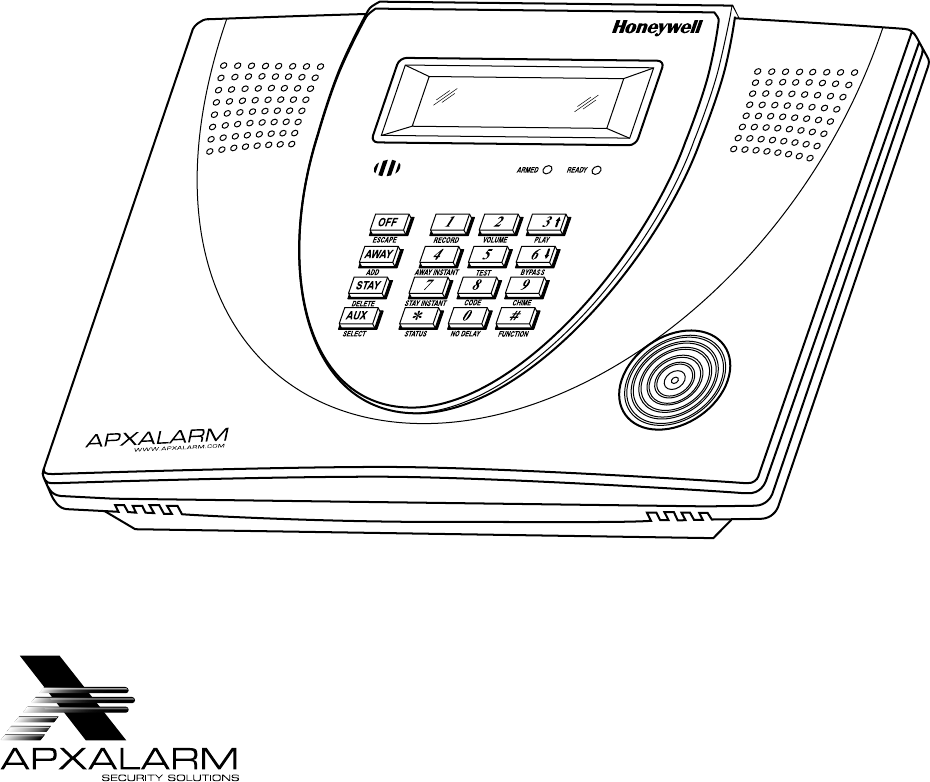
APX32EN
Security Systems
Installation and Setup Guide
PREK14114-8 11/07 Rev. A
PLEASE GO TO PAGE 68 FOR THE FCC / IC
INFORMATION / STATMENTS
OR USE THE BOOKMARK
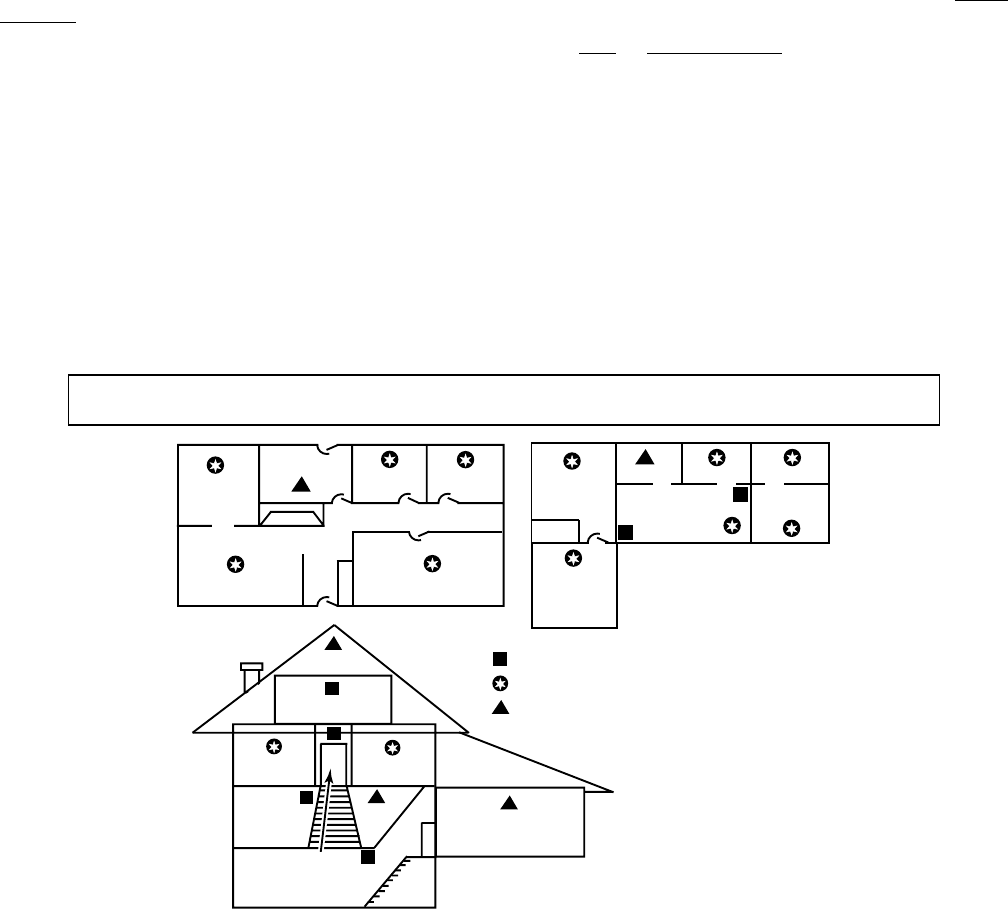
- 2 -
RECOMMENDATIONS FOR PROPER PROTECTION
The Following Recommendations for the Location of Fire and Burglary Detection Devices Help Provide Proper
Coverage for the Protected Premises.
Recommendations for Smoke and Heat Detectors
With regard to the number and placement of smoke/heat detectors, we subscribe to the recommendations contained in
the National Fire Protection Association's (NFPA) Standard #72 noted below.
• Early warning fire detection is best achieved by the installation of fire detection equipment in all rooms and areas of
the household as follows: For minimum protection a smoke detector should be installed outside of each separate sleeping
area, and on each additional floor of a multi-floor family living unit, including basements. The installation of smoke
detectors in kitchens, attics (finished or unfinished), or in garages is not normally recommended.
• For additional protection the NFPA recommends that you install heat or smoke detectors in the living room, dining
room, bedroom(s), kitchen, hallway(s), attic, furnace room, utility and storage rooms, basements and attached garages.
In addition, we recommend the following:
• Install a smoke detector inside every bedroom where a smoker sleeps.
• Install a smoke detector inside every bedroom where someone sleeps with the door partly or completely closed. Smoke
could be blocked by the closed door. Also, an alarm in the hallway outside may not wake up the sleeper if the door is
closed.
• Install a smoke detector inside bedrooms where electrical appliances (such as portable heaters, air conditioners or
humidifiers) are used.
• Install a smoke detector at both ends of a hallway if the hallway is more than 40 feet (12 meters) long.
• Install smoke detectors in any room where an alarm control is located, or in any room where alarm control connections
to an AC source or phone lines are made. If detectors are not so located, a fire within the room could prevent the control
from reporting a fire or an intrusion.
THIS CONTROL COMPLIES WITH NFPA REQUIREMENTS FOR TEMPORAL PULSE SOUNDING OF FIRE
NOTIFICATION APPLIANCES.
DINING KITCHEN
BEDROOM
BEDROOM
.
Smoke Detectors for Minimum Protection
Smoke Detectors for Additional Protection
Heat-Activated Detectors
BEDROOMBEDROOM
BEDROOM
BEDROOM
LIVING
ROOM
TV ROOM
DINING
LIVING ROOM
LIVING ROOM
BASEMENT
BEDROOMBEDROOM
BEDROOM
CLOSED
DOOR
GARAGE
KTCHN
KITCHEN
TO
BEDROOM
01000-002-V0
Recommendations For Proper Intrusion Protection
• For proper intrusion coverage, sensors should be located at every possible point of entry to a home or premises. This
would include any skylights that may be present, and the upper windows in a multi-level building.
• In addition, we recommend that radio backup be used in a security system. This will ensure that alarm signals can be
sent to the alarm monitoring station in the event that the telephone lines are out of order (alarm signals are normally
sent over the phone lines, if connected to an alarm monitoring station).
- 3 -
Table of Contents
SYSTEM FEATURES ..................................................................................................................................5
MOUNTING THE CONTROL.....................................................................................................................6
WIRING CONNECTIONS...........................................................................................................................7
CONNECTING/CONFIGURINGCOMMUNICATIONS DEVICES .........................................................9
AC POWER AND BACKUP BATTERY....................................................................................................12
INSTALLING WIRELESS ZONES...........................................................................................................14
MECHANICS OF PROGRAMMING ........................................................................................................17
ZONE RESPONSE TYPE DEFINITIONS ...............................................................................................19
DATA FIELD DESCRIPTIONS ................................................................................................................21
✻56 ENHANCED ZONE PROGRAMMING MODE ................................................................................31
✻80 DEVICE PROGRAMMING MENU MODE ......................................................................................36
✻81 ZONE LIST MENU MODE................................................................................................................39
✻83 ENHANCED SEQUENTIAL MODE ................................................................................................41
✻84 ASSIGN ZONE VOICE DESCRIPTORS ..........................................................................................44
✻85 RECORD CUSTOM VOICE DESCRIPTORS...................................................................................45
VOICE PROMPT PROGRAMMING.........................................................................................................48
REMOTE PROGRAMMING/CONTROL (DOWNLOADING) ................................................................52
SYSTEM OPERATION..............................................................................................................................54
TESTING THE SYSTEM ..........................................................................................................................60
SYSTEM COMMUNICATION ..................................................................................................................61
TROUBLESHOOTING GUIDE ................................................................................................................63
PROGRAMMING DEFAULT TABLES....................................................................................................67
REGULATORY AGENCY STATEMENTS ..............................................................................................69
SPECIFICATIONS.....................................................................................................................................70
CONTACTING TECHNICAL SUPPORT.................................................................................................71
INDEX.........................................................................................................................................................73
LIMITATIONS OF THIS SYSTEM STATEMENT..................................................................................77
UL NOTICES..............................................................................................................................................78
SUMMARY OF CONNECTIONS DIAGRAM ..........................................................................................79
WARRANTY ............................................................................................................................... Back Cover
- 4 -
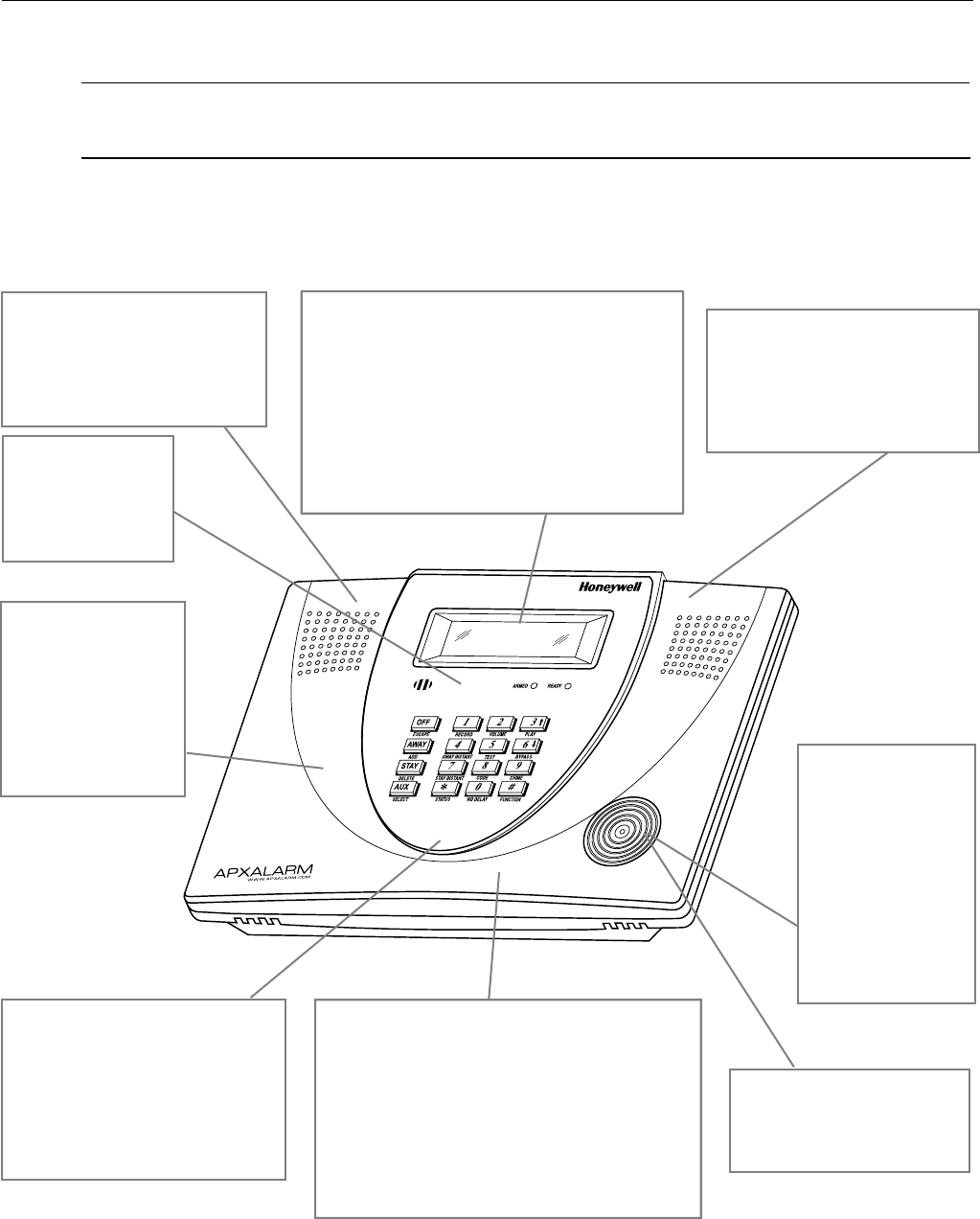
APX32EN Installation and Setup Guide
- 5 -
System Features
U
UU
UL
LL
L
APX32EN is not intended for UL985 Household Fire applications unless a 24-hour backup battery (P/N
LYNXRCHKIT-HC or LYNXRCHKIT-SHA) is installed.
Powerline Carrier Devices have not been evaluated by UL.
The APX32EN control is a self-contained, rechargeable wireless control/communicators that feature easy
installation and usage. A built-in speaker provides voice annunciation of system status along with voice
descriptors of each zone. An internal module (if provided) allows the APX32EN to communicate with the
Central Station via the Internet. The following illustration highlights the main features of this system.
ZONES and DEVICES
• Up to 24 wireless zones
(5800 Series Transmitters)
• Up to 16 wireless button zones
• Up to 8 Powerline Carrier Devices
• Supports wireless keypads
8 USER CODES
• Installer code
• Master code
• 5 Secondary codes
• Duress code
• 3 Panic functions
ALARM OUTPUT
• Built-in sounder
• Piezo output
(30mA max.)
• Bell output
(120mA max.)
• Steady output for
burglary/panic
• Temporal pulse
output for fire alarms
• Long Range
Radio/Audio alarm
verification
PROGRAMMING
• Options stored in EEROM
• Can be uploaded, downloaded or
controlled via IBM-compatible
computer using Compass
downloader software and specified
HAYES modem or via capable GSM
or IP communications modules
• Voice Prompt programming mode
COMMUNICATION
• Ademco Low Speed
• Sescoa/Radionics
• Ademco Express
• Ademco Contact ID
• Paging feature
• Internet Central
Station Communication
• GSM Cellular Central
Station Communication
SYSTEM POWER
• Primary Power: Ademco K10145X10
Plug-in Transformer, 110VAC to
9VAC, 25VA output
• Backup battery: Rechargeable
nickel-metal hydride battery pack
rated at 7.7Vdc.
FEATURES
• Real-time Clock display and Fixed-Word display
• Message Center (for user recorded messages)
• Voice announcement of system and zone status
• Voice chime
• Alarm Clock
• Reminder
• Latch Key Reports
• Automatic Stay Arming
• Remote Phone Control
• “Follow Me” Reminder and System Announcements
OTHER FEATURES
• Exit error feature (detects difference between an
actual alarm and exit alarm caused by leaving a
door open after the exit delay expires)
• Event log stores up to 84 events
• Macro/ 1-button paging
• RF Jam Detection
• Remote Phone Control
• Compatible with Encrypted (High-Security) Devices
• Two-way voice communication
• Speaker phone operation
REMOTE SERVICES
• Remote access feature
• Multi-mode (e-mail notification)
• SMS (short message service)
feature
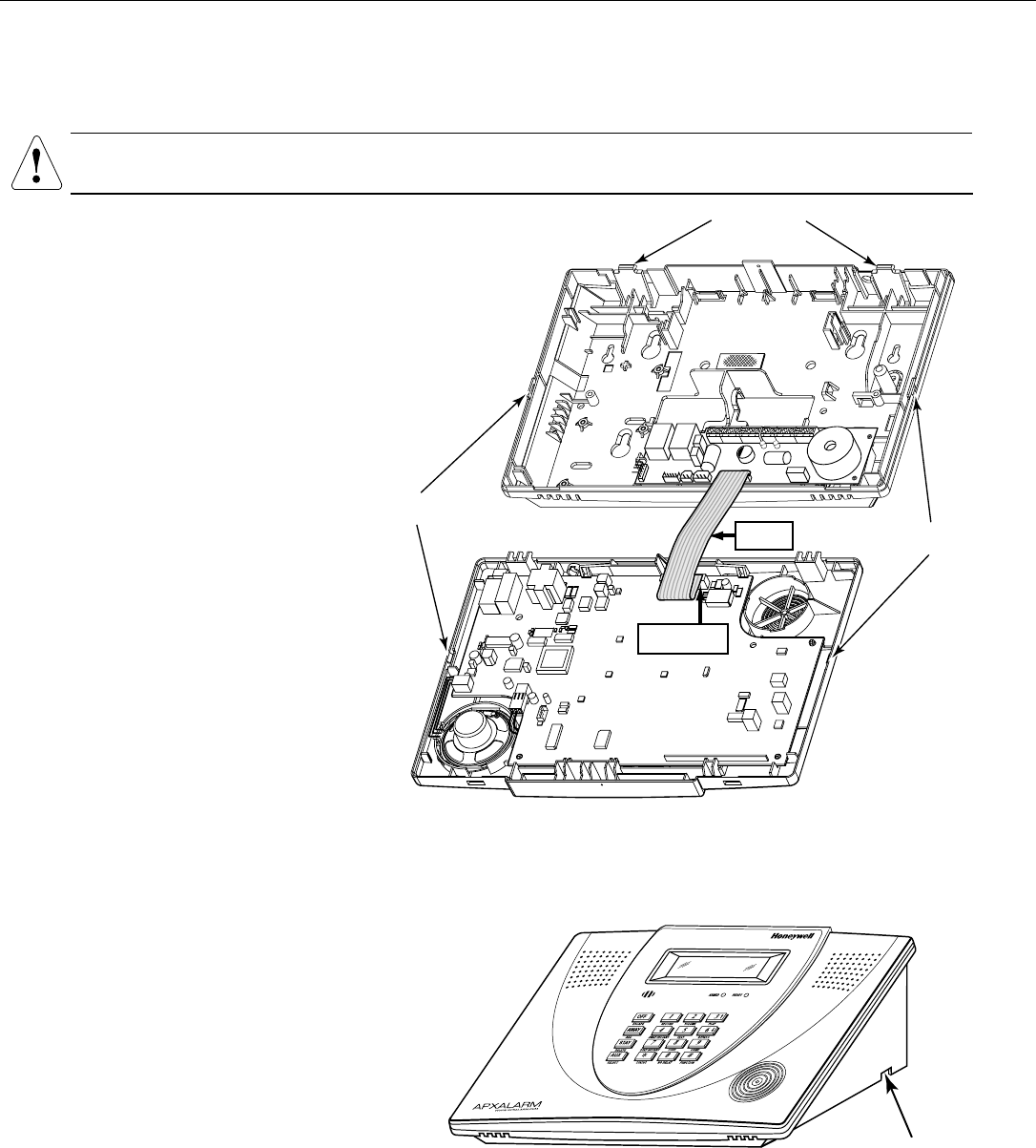
APX32EN Installation and Setup Guide
- 6 -
Mounting the Control
Wall Mounting
The illustration below shows the front assembly separated from the back plate.
DO NOT disconnect the ribbon cable from the terminal strip board. Disconnect the cable only from the
front assembly board.
1. Release the front assembly from the back
plate by depressing the two locking tabs
at the top of the unit with the blade of a
medium size screwdriver.
2. Once these tabs have been released,
insert the screwdriver in the side of the
case and release the side locking tabs by
gently twisting.
3. Carefully disconnect the ribbon cable from
the front assembly, leaving the ribbon
cable connected to the terminal block
PC board. The back plate contains the
terminal block for making wiring
connections.
4. Mount the back plate to a sturdy wall,
feeding the field wiring through the
appropriate openings in the back plate.
5. After wiring connections are made,
carefully reconnect the ribbon cable to
the front assembly PC board connector
(properly aligning the red wire).
6. Snap the front assembly to the back plate
so it is secured by the locking tabs.
LOCKING TABS
RED WIRE
MARKING
DISCONNECT
THIS END ONLY!
09012-002-V0
LOCKING
TABS
LOCKING
TABS
Desktop Mounting
For desktop use the optional mounting base (model LYNX-DM, purchased separately) must be used.
1. Slide the control panel onto the mounting
base locking tabs.
2. Bring all wiring through the bottom of the
mounting base, using one of the three
wire entry locations, before making
connections to the control panel.
3. Use tie-wraps to secure the wiring to the
built-in wire loops as needed. Use the two
supplied screws to secure the control
panel to the mounting base.
09012-011-V0
WIRE ENTRY
KNOCKOUT
(1 of 3)
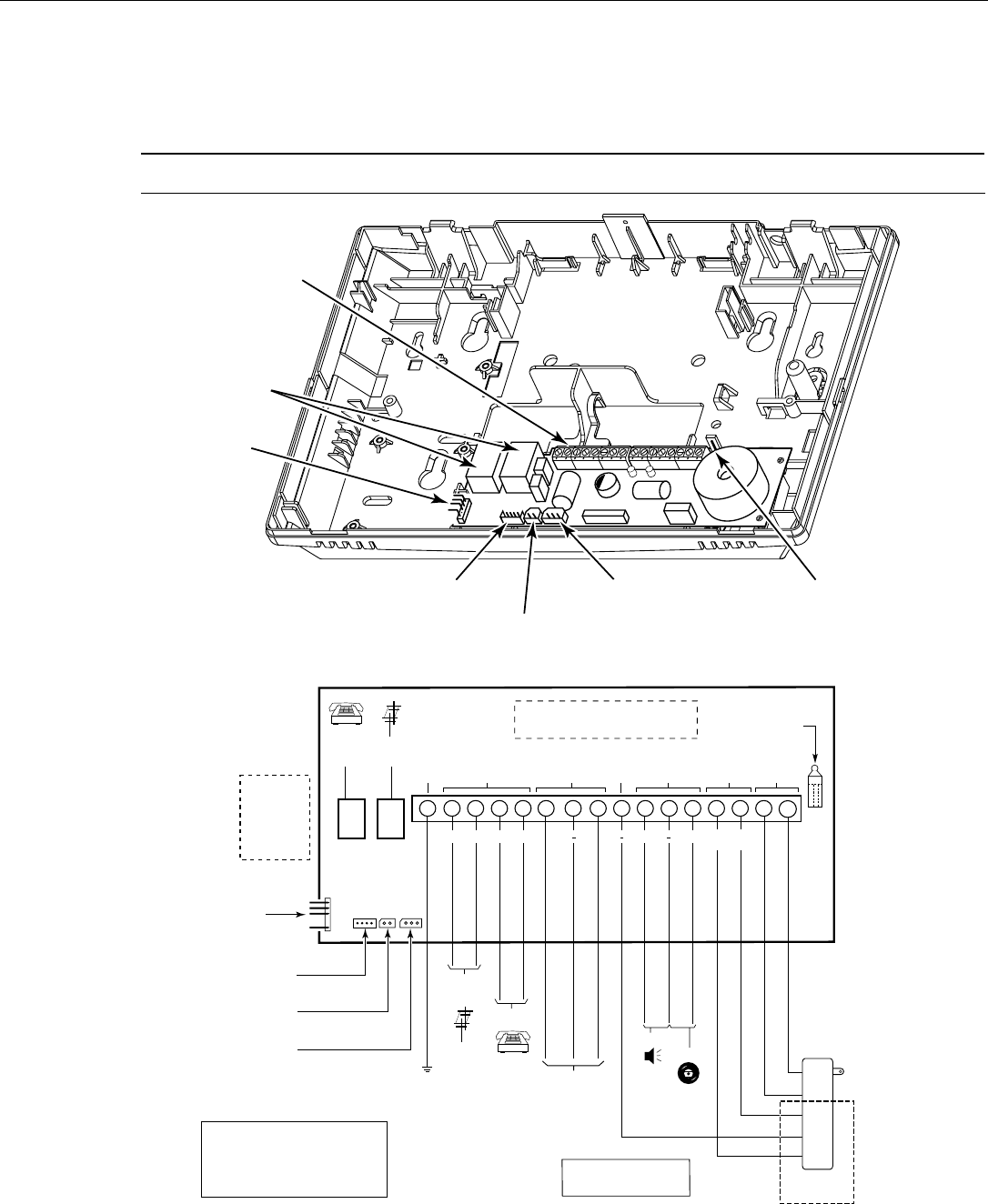
APX32EN Installation and Setup Guide
- 7 -
Wiring Connections
Wiring Overview
The following summarizes the connections required. Refer to the Wiring Connections paragraph and the
Summary of Connections diagram on the inside back cover when making connections.
U
UU
UL
LL
L
External sounders have not been evaluated by UL.
09012-009-V0
SUPER HIGH-CAPACITY
BATTERY CONNECTOR
TERMINAL
STRIP
TELEPHONE
CONNECTIONS
7845i-L
CONNECTIONS
PORT
GSMVL
COMMUNICATIONS
PORT
LOCAL
SOUNDER
DISABLE
STANDARD
HIGH-CAPACITY
BATTERY CONNECTOR
INCOMING
PHONE
LINE
TO
HANDSET
PHONE
LINE
WARNING:
TO PREVENT
RISK OF SHOCK
DISCONNECT
TELEPHONE LINE
AT TELECOM
JACK BEFORE
SERVICING
THIS UNIT.
WEEKLY TESTING IS
REQUIRED TO ENSURE
PROPER OPERATION
OF THIS SYSTEM
ALL OUTPUT CIRCUITS ARE POWER LIMITED.
PREMISES
TELEPHONE
1234865 11
710 12 15 16
13 14
PHONE
FUTURE
USE
FUTURE
USE SOUNDERS PLCD AC
EARTH
GROUND
EARTH
GROUND
INCOMING
TELEPHONE
LINE
RING
TIP
RING
TIP ( ) ( ) (+)
(+)( )
PIEZO
6-14VDC
120mA max.
(e.g. WAVE2EX)
6-14VDC
30mA max.
DATA
OUT
SYNC
IN
POWERLINE
CARRIER DEVICES
RJ11
8
POS
JACK
AC
AC
SYNC
COM
DATA
9
BELL
09012-010-V0
NOTE
USE ONLY THE K10145X10
TRANSFORMER PROVIDED
K10145X10
PLUG-IN
TRANSFORMER
9VAC, 25VA
X10
ONLY
CONNECTIONS
GND
DATA IN
GND
DATA OUT
LOCAL SOUNDER
DISABLE SHUNT
REMOVE TO DISABLE
THE APX32EN CONTROL IS COMPATIBLE WITH
THE FOLLOWING INTEGRAL RECHARGEABLE
BATTERY PACKS:
REPLACE EVERY FOUR YEARS
P/N LYNXRCHKIT-SC
P/N LYNXRCHKIT-HC
P/N LYNXRCHKIT-SHA
* WHEN AVAILBLE
UL NOTE
THE MINIMUM WIRE SIZE USED FOR TELEPHONE
INSTALLATIONS MUST BE #26 GAUGE
SUPER HIGH-CAPACITY
BATTERY CONNECTOR
7845i-L
CONNECTIONS
PORT
GSMVL
COMMUNICATIONS
PORT
STANDARD
HIGH-CAPACITY
BATTERY CONNECTOR
APX32EN Wiring Connections
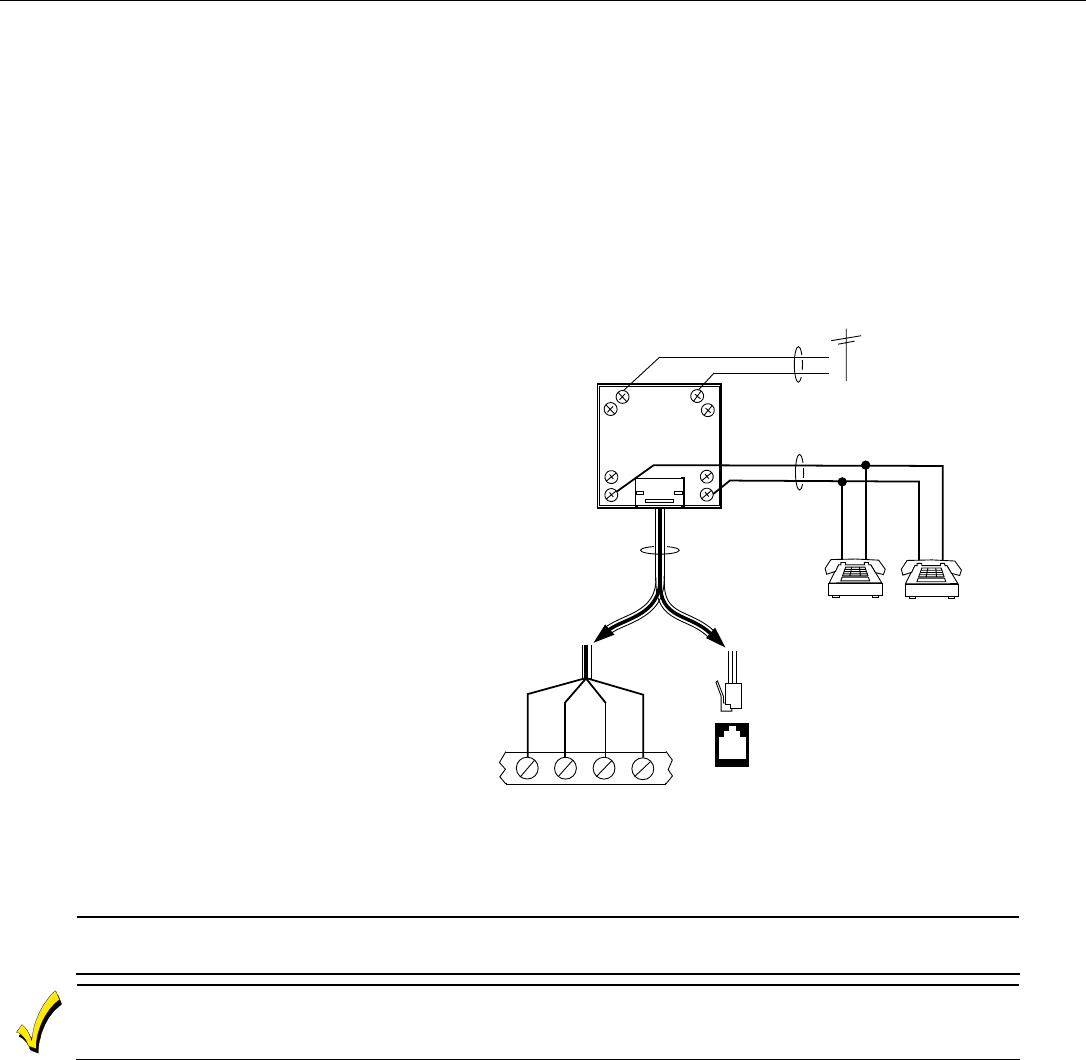
APX32EN Installation and Setup Guide
- 8 -
Wiring Connections
1. Make Earth Ground Connection - The designated earth ground terminal (1) must be terminated in a good earth ground
for the lightning transient protective devices in this product to be effective. The following are examples of good earth
grounds available at most installations:
Metal Cold Water Pipe - Secure a non-corrosive metal strap (copper is recommended) to the pipe that is electrically
connected and secured to which the ground lead is electrically connected and secured.
AC Power Outlet Ground - Available from 3-prong, 120VAC power outlets only. To test the integrity of the ground
terminal, use a three-wire circuit tester with neon lamp indicators, such as the UL Listed Ideal Model 61–035, or
equivalent, available at most electrical supply stores.
a. Connect terminal 1 to a good earth ground.
2. Make Phone Line Connections - For local or full line seizure proceed to the appropriate steps below.
Local Seizure
a. Connect the incoming phone line to either the
8-position jack or terminals 2 (TIP) and 3
(RING) on the Lynx.
b. Connect the handset phone lines to either the
RJ11 jack or terminals 4 (TIP) and 5 (RING).
Full Line Seizure: The control must be
placed in series with the incoming phone
line. Plugging the Direct Connect Cord
directly into the RJ31X jack, allows the control
to seize the phone line when an alarm occurs
and normal phone line usage by the premises
phones if the plug needs to be removed.
c. Cut the incoming RING and TIP phone lines
(typically red and green, respectively) and
connect them to RJ31X terminals 4 (red) and
5 (green).
d. Connect the premises end of the cut RING
and TIP wires to RJ31X terminals 1 (grey) and
8 (brown) respectively.
e. Wire the flying leads of a Direct Connect Cord
to the control’s phone terminals as shown in
the diagram or plug into the 8-position jack.
f. Plug the Direct Connect Cord into the RJ31X
jack.
RJ31X
1
2
3
45
6
7
8
RING
TIP
INCOMING
PHONE LINE
TO
PREMISES PHONES
TIP RING TIP RING
BROWN
GREY
RED
GREEN
INCOMING
PHONE LINE
TO
PREMISES
PHONES
}
}
GREENRED
GREY BROWN
RING
TIP
DIRECT
CONNECT
CORD
OR
OR
8-POSITION
JACK
01000-008-V0
Full Line Seizure Connections
U
UU
UL
LL
L
Do not remove the local sounder shorting jumper (shunt).
External sounders and powerline carrier devices have not been evaluated by UL
LOCAL SOUNDER DISABLE: The Master Keypad’s built-in piezo sounder can be disabled by removing the
shorting jumper (shunt) on the terminal board. If disabled, however, no sounding will occur upon AC loss,
since the external sounder does not operate when AC power is lost.
3. Make External Sounder Connections - The control panel supports either a 6-14VDC piezo sounder (30mA max.) or
6-14VDC bell (120mA max.; e.g. ADEMCO WAVE2EX).
a. Connect a piezo sounder to terminals 10 (+) and 11 (–); OR a bell to terminals 11 (–) and 12 (+).
4. Disable Local Sounder Option - If required the Master Keypad’s built-in piezo sounder can be disabled.
a. Remove the shorting jumper (shunt) on the terminal board.
5. Make Powerline Carrier Device Connections - The control panel supports up to 8 Powerline Carrier Devices. If using
these devices, they must be connected to the K10145X10 transformer, as shown in the SUMMARY OF
CONNECTIONS diagram.
a. Connect the com/data/sync/ lines from the transformer to terminals 9, 13, and 14, respectively.
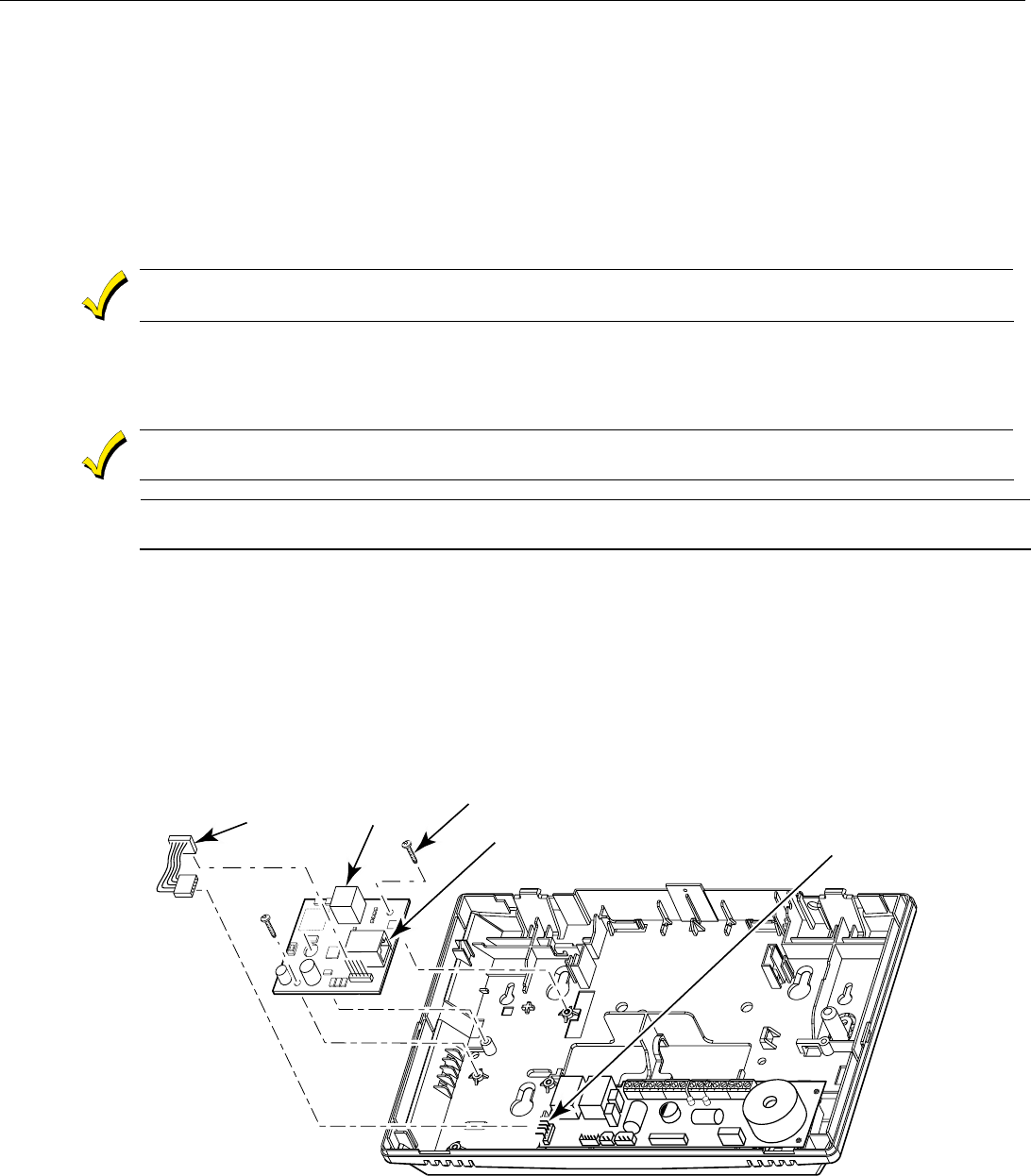
APX32EN Installation and Setup Guide
- 9 -
Connecting/Configuring Communication Modules
General
This APX32EN supports central station reporting via the internet using wireless (GSM) and hardwire (IP)
communications modules. It also supports upload/download programming capability via the Internet or a
Private local area network (Intranet). This allows site maintenance independent of central station
monitoring, and modification to sites globally via the Internet or through a private LAN. Refer to the
instructions provided with the LRR/IP Communications Device being installed for additional information
regarding its installation, programming, and registration. Zone 103 is the supervisory zone for the
Communications Device.
APX32EN does not support the 7845i-ENT remote access feature.
Connecting Long Range Radio and Internet Communication Devices
Connect and configure the communications device as follows (refer to the Installation Instructions for device
that you are installing for additional information):
The wire run between the APX32EN and the Communications Device must not exceed ten (10) feet.
U
UU
UL
LL
L
The 7845I-ENT has been evaluated by UL for Household Burglary installations. The communications
modules have not been evaluated for Household Fire installations.
AlarmNet 7847i-L* Communications Device
1. Install the module into the APX32EN back plate and secure it with the two provided screws. Refer to the diagrams below.
2. Connect the provided ribbon cable between the module and the PC board. This cable provides DC power and ground for
the module and data in/data out connections.
3. Connect the device to the Internet via a cable/DSL modem and router or to an Intranet (LAN) via the appropriate Ethernet
connection.
* When available. The 7847i-L module has not been evaluated by UL.
SCREW (2)
09012-008-V0
CABLE
7720P
PROGRAMER
CONNECTION
RJ45
(FOR INTERNET CONNECTION)
COMMUNICATION PORT
FOR INTERNAL 7845i-L
MODULE ONLY
Installing the 7847i-L Communications Module
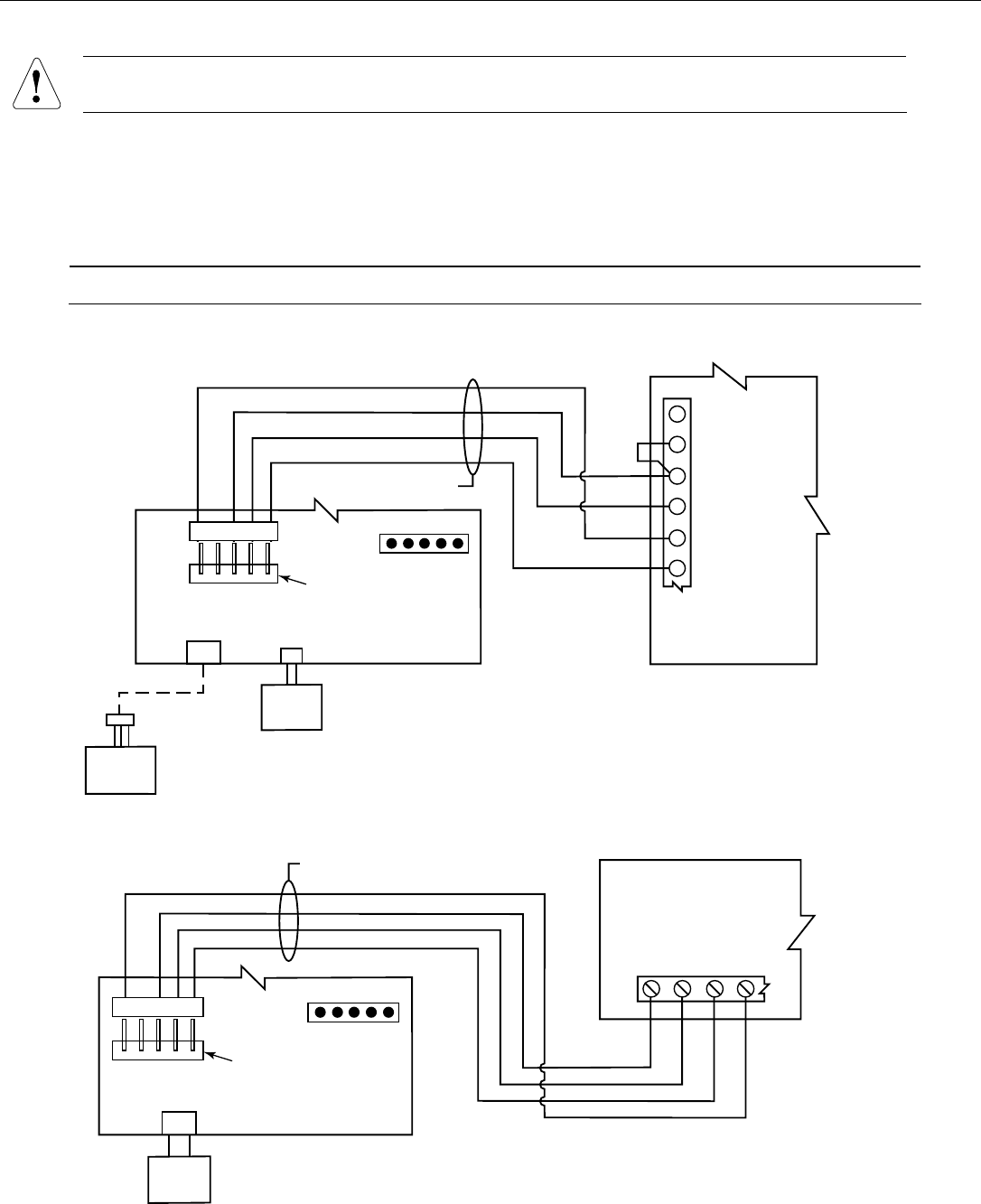
APX32EN Installation and Setup Guide
- 10 -
AlarmNet 7845GSM, 7845i-GSM, 7845i-ENT, 7847i-E* or 7845i, Communications Device
The 7845i-ENT/7845i and 7845CV2 can not be used for installations requiring 24-hour standby.
1. Connect the 4-wire communications cable to the LRR/IP Communications port on the APX32EN.
2. Connect the four wires to the specific Communications device as shown in the accompanying figures.
3. If you are installing a 7845GSM or 7845i-GSM you must also install a jumper between terminals 2 and 3 on the
communications device.
4. Connect the device to the Internet via a cable/DSL modem and router or to an Intranet (LAN) via the appropriate Ethernet
connection, if applicable.
U
UU
UL
LL
L
The AlarmNet 7845GSM and 7845i-GSM have been evaluated by UL.
7845GSM / 7845i-GSM
LYNX
SUPER HIGH
CAPACITY
BATTERY
(OPTIONAL)
REQUIRED FOR
24-HR BACKUP
7845i-GSM-010-V0
GND
Z3 OR DATA OUT
Z1/Z2 OR DATA IN
ECP (+) VOLTAGE INPUT
RED
BLK
GRN
YEL
RED
BLK
GRN
YEL
4
5
6
3
5
4
4-WIRE CABLE (N4632-4)
1
2
TB1
LRR/IP COMMUNICATIONS PORT
LYNXR-I CONTROL PANEL
NC
+12 VDC
GND
DATA I N
DATA OUT
LYNX
STANDARD
CAPACITY
BATTERY
Connecting AlarmNet 7845GSM / 7845i-GSM
7845i-ENT / 7845i
07000-013-V2
GND
DATA I N
DATA OUT
(+) VOLTAGE INPUT
RED BLK GRN YEL
RED
BLK
GRN
YEL
TB 1
LYNXR-I CONTROL PANEL
NC RED
BLK
GRN
YEL
+12 VDC
GND
DATA I N
DATA OUT
4-WIRE CABLE (N4632-4)
LYNX
STANDARD
CAPACITY
BATTERY
LRR/IP COMMUNICATIONS PORT
Connecting AlarmNet 7845i-ENT/7845i/7847i-E*
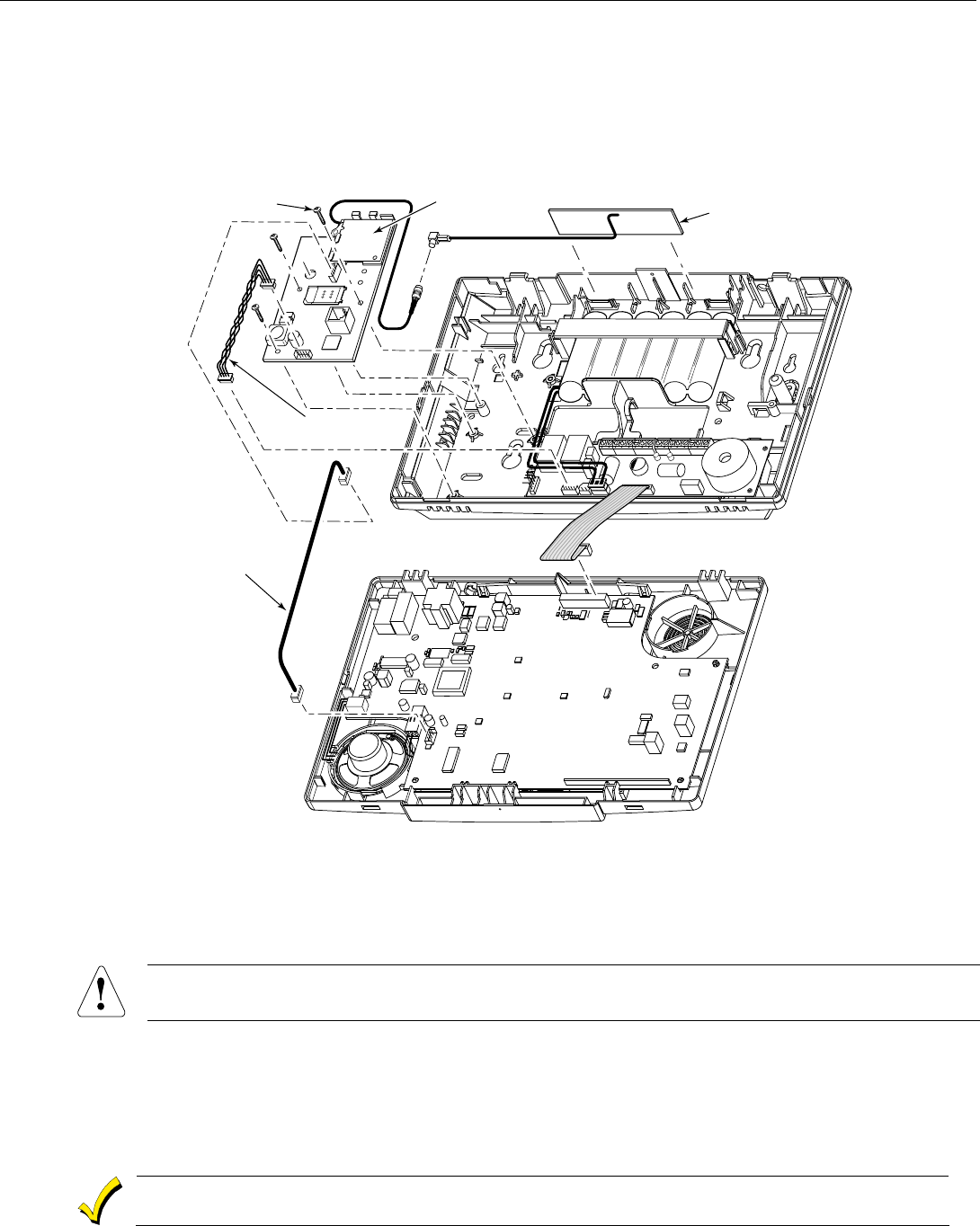
APX32EN Installation and Setup Guide
- 11 -
AlarmNet GSMVL Communications Device
1. Install the module into the APX32EN back plate and secure it with the three provided screws.
2. Insert the antenna into the retaining slots in the APX32EN back plate.
3. Use double-stick tape to secure antenna to the APX32EN back plate.
4. Connect the provided communications cable between the GSMVL module and the APX32EN PC board. This cable
provides DC power and ground for the module and data in/data out connections.
5. Connect the provided shielded audio cable between the GSMVL module and the APX32EN PC board.
COMMUNICATIONS
CABLE
GSMVL
ANTENNA
09012-017-V0
SCREW (3)
AUDIO
CABLE
Installing the GSMVL Communications Module
LRR/IP Communications Device 24-Hour Standby Power
If you are installing the AlarmNet 7845GSM/7845i-GSM or 7845i-L you must install the Super High
Capacity battery P/N WALYNX-RCHB-SHA in the APX32EN.
The 7845i-ENT/7845i cannot be used for installations requiring 24-hour standby.
Configuring Long Range Radio and Internet Communication Devices
1. Enable the communications device in programming field *55 and configure alarm reporting and module supervision in
programming field *77.
2. Program the device as required using the 7720P programmer (refer to the Installation Instruction for the device that you
are installing for additional information). Note that the device address must be set to 3.
The device must be registered before downloading or alarm reporting can take place.
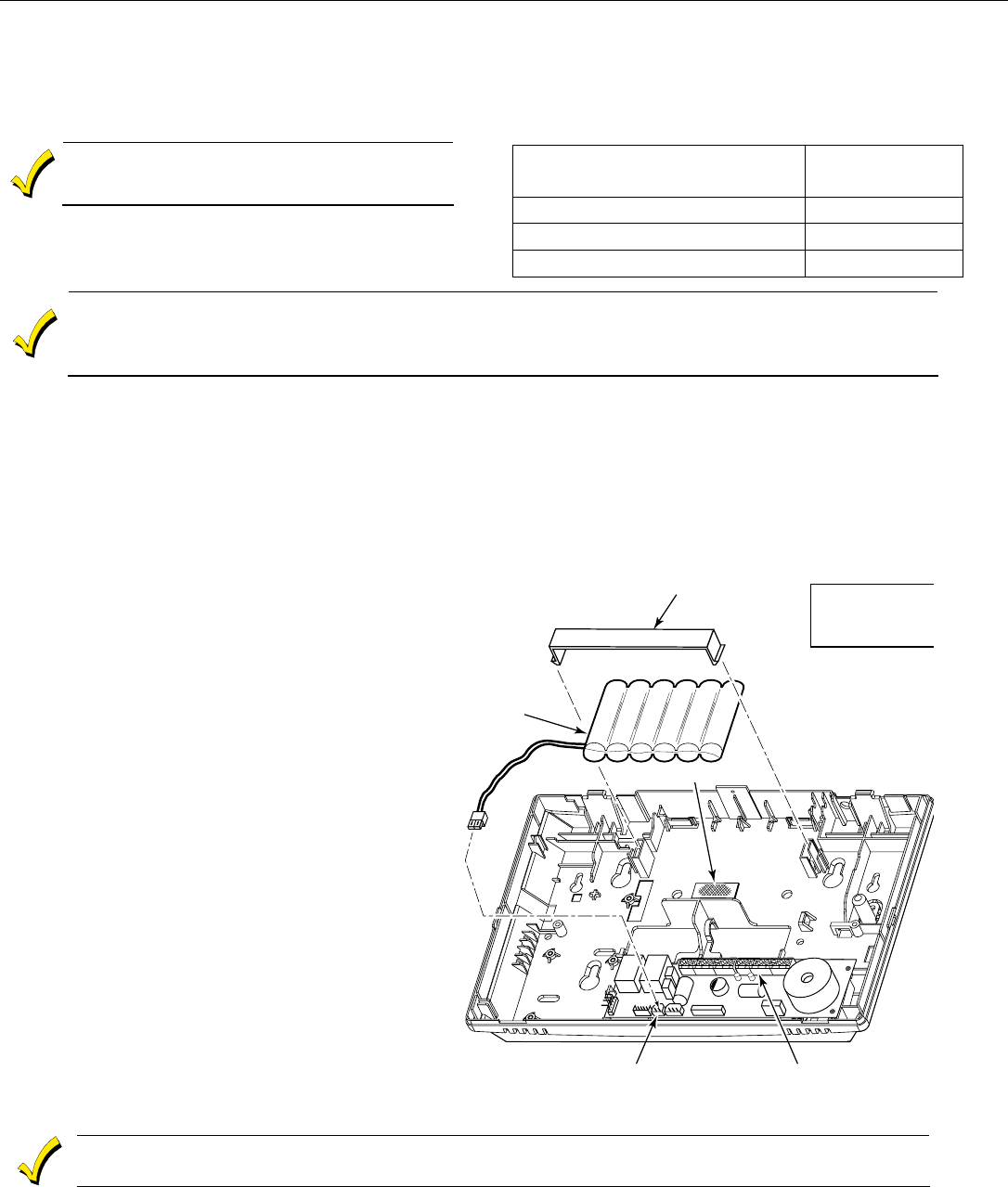
APX32EN Installation and Setup Guide
- 12 -
AC Power and Backup Battery
The system is powered by a 9VAC, 25VA Plug-in Transformer, ADEMCO K10145X10. Refer to the wiring
table below for wire gauge and length.
Use only the provided ADEMCO K10145X10
Transformer.
Distance from Transformer
to Control
Wire Gauge
Up to 75 feet #20
75 to 150 feet #18
150 to 300 feet #16
Wiring to the AC Transformer must not exceed 300 feet using 16-gauge wire. The voltage reading
between terminals 15 and 16 of the control must not fall below 9.00VAC.
Do not plug the transformer into the AC outlet until after all wiring connections have been made.
Backup battery
In the event of an AC power loss, the system is supported by a long life backup battery that is supervised for
connection and for low voltage conditions. If the battery is missing, or a low battery condition is detected, a
“low battery” message is displayed and a report is sent to the central station. In addition, the system will beep
once every 45 seconds to audibly indicate a low battery condition (press any key to stop the beeping).
AC Power and Rechargeable Backup Battery
Connecting AC Power and backup battery
1. Connect wires from the K10145X10 AC Transformer to
terminals 15 and 16 as shown in the wiring diagram.
2. Remove battery retainer.
3. Peel the backing from tape on the back plate.
4. Insert battery pack into back plate.
5. Install battery retainer.
6. Connect battery connector to receptacle on terminal
block PC board.
7. After all wiring connections have been made, snap the
front assembly to the back plate and plug the
transformer into a 24-hour, 110VAC unswitched outlet.
Note: Rechargeable batteries may take up to 48-hours to
fully charge. The “LOW BAT” message should clear
within four hours or by entering Test Mode.
09012-003-
V
BATTERY
RECEPTACLE
WIRING
TERMINALS
NOTE
LYNXRCHKIT-HC
BATTERY PACK SHOWN
TAPE
BATTERY
PACK
RETAINER
Ensure the cover is snapped closed prior to applying AC power.
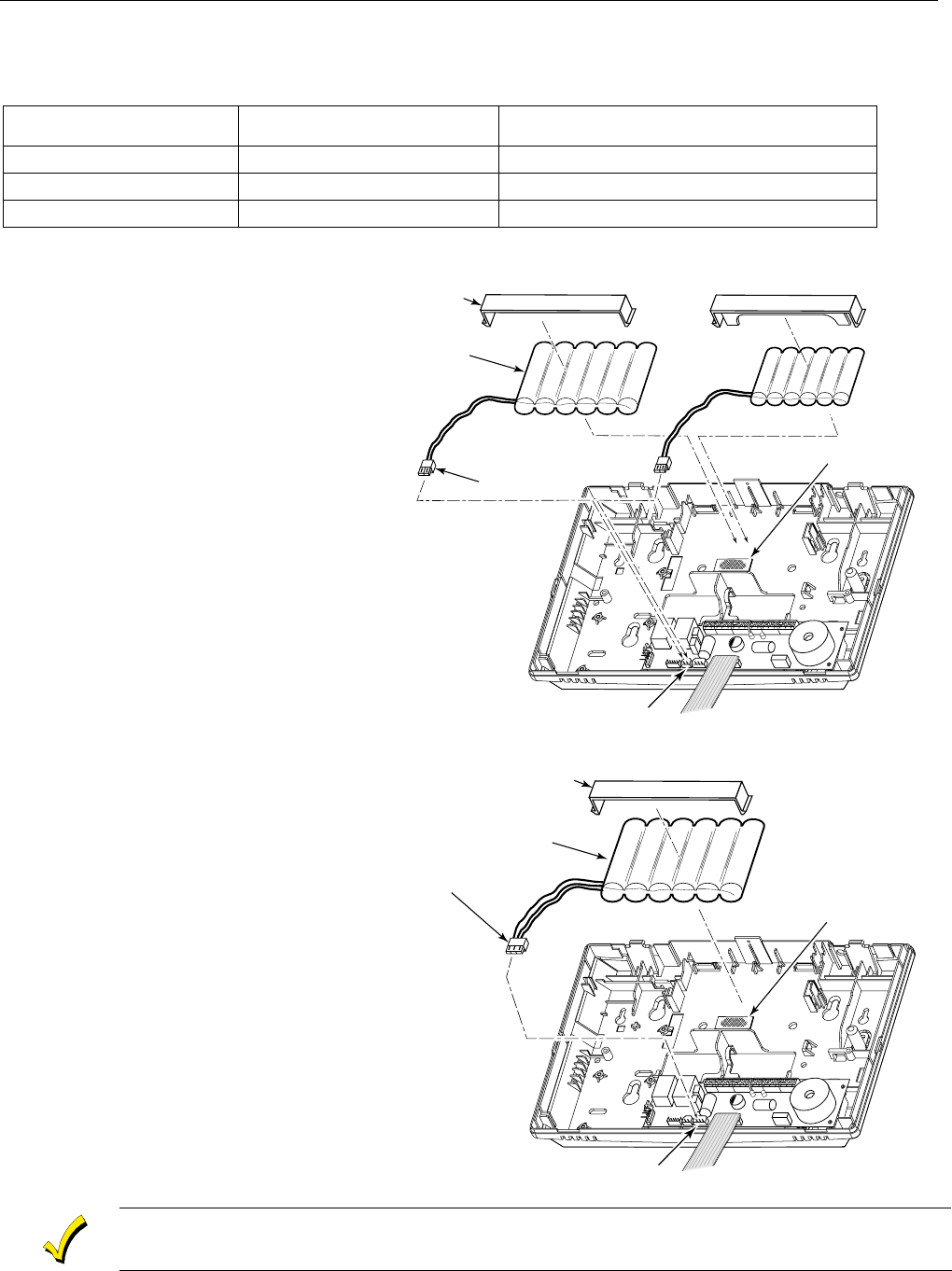
APX32EN Installation and Setup Guide
- 13 -
AC Power and Rechargeable Backup Battery
The APX32EN is equipped with an integral, replaceable, rechargeable battery pack rated at 7.7Vdc. Select
the appropriate battery pack, based on the installation’s requirement, and install the battery pack.
Model/Part Number Battery StandbyTime
Low Battery Notification
LYNXRCHKIT-SC 4-hours (minimum) Approximately 1-hour before battery depletion
LYNXRCHKIT-HC 24-hours (minimum) At least 1-hour before battery depletion
LYNXRCHKIT-SHA 24-hours (minimum) At least 1-hour before battery depletion
Replacing the Rechargeable Battery
1. When battery replacement is required,
unplug the transformer from the wall outlet,
and open the control panel cover.
2. Remove the battery retainer and disconnect
the battery pack connector from the
receptacle on the terminal block PC board.
3. Remove the battery pack from the back
plate.
4. If required, replace the tape that secures the
battery pack.
5. Install a replacement battery pack (P/N
LYNXRCHKIT-SC, LYNXRCHKIT-HC or
LYNXRCHKIT-SHA) into the back plate.
6. Install the battery retainer.
7. Connect the battery connector to the
receptacle on the terminal block PC board.
8. After the wiring connection has been made,
snap the front assembly to the back plate.
9. Plug the transformer into a 24-hour, 110VAC
unswitched outlet.
10. Rechargeable batteries may take up to 48-
hours to fully charge. The “LOW BAT”
message should clear within four hours or
by entering Test Mode.
09012-004-V0
LYNXRCHKIT-SHC
RETAINER
BATTERY
CONNECTOR
BATTERY
PACK
BATTERY
RECEPTACLE
BATTERY
RECEPTACLE
TAPE
LYNXRCHKIT-HC OR LYNXRCHKIT-SC
RETAINER
BATTERY
CONNECTOR
BATTERY
PACK
TAPE
Ensure the control panel assembly is snapped closed prior to applying AC power.
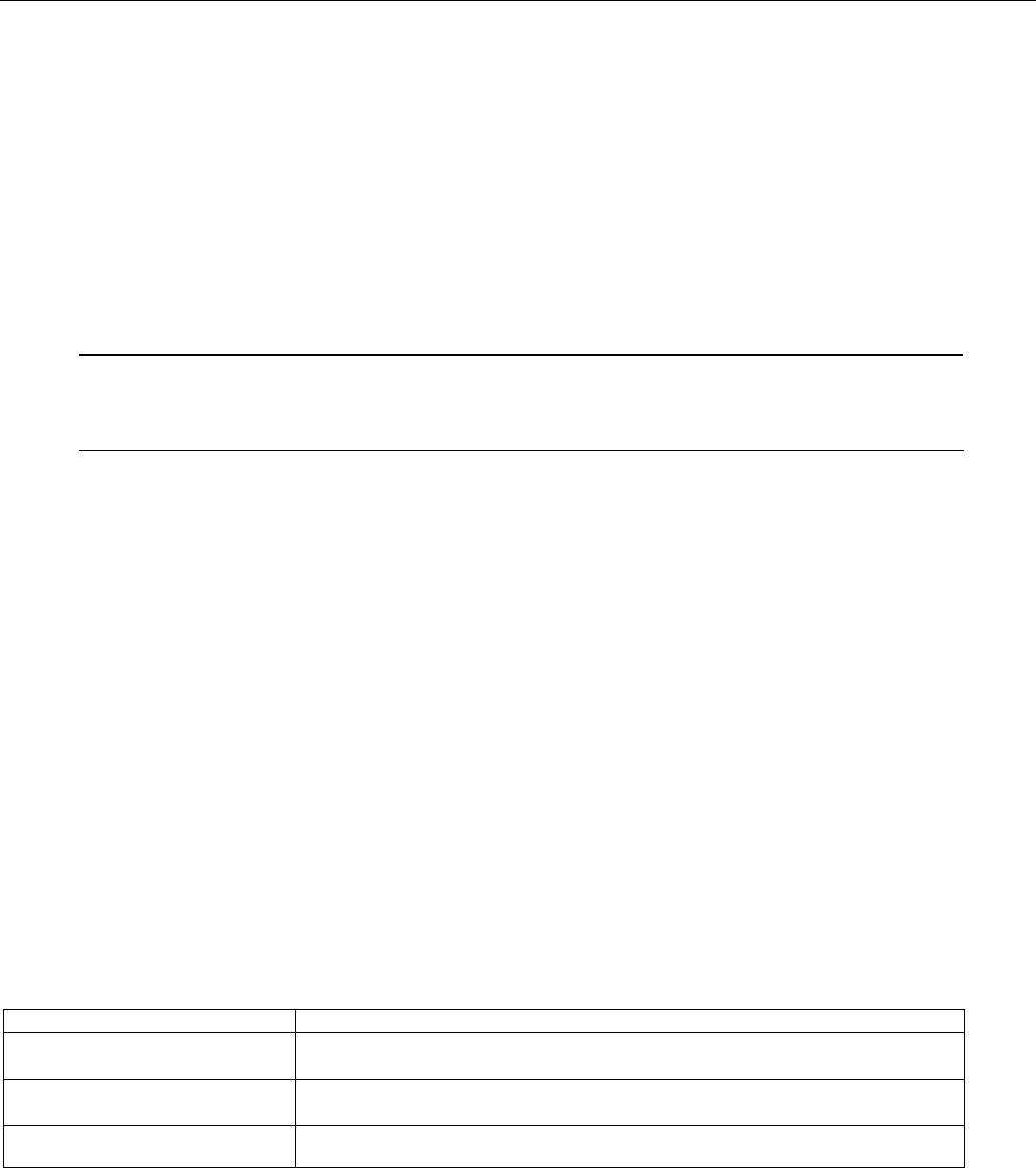
APX32EN Installation and Setup Guide
- 14 -
Installing Wireless Zones
General Information
Zones: The control supports up to 24 wireless zones using 5800 Series transmitters, and up to 16 wireless
buttons.
Range: The built-in RF receiver can detect signals from wireless transmitters within a nominal range of 200
feet.
Transmitters: 5800 Series transmitters have built-in serial numbers that must be entered into the system
using the ✻56 or ✻83 interactive mode, or input to the control via the downloader. 5800 Series transmitters
(except the 5800RL, which is described separately) do not have DIP switches. Each transmitter's zone
number is programmed into the system in ✻56 mode. Some transmitters, such as the 5816 and 5817, can
support more than one "zone" (referred to as loops or inputs). On the 5816, for example, the wire connection
terminal block is loop 1, the reed contact is loop 2. Each loop must be assigned a different zone number.
U
UU
UL
LL
L
The 5816 and 5817 Transmitters do not have EOL supervision of their loop wiring and the loop wiring must
not exceed 3 feet.
The 5800RL, 5802MN, 5802MN2, 5804, 5804BD, 5804BDV, 5804E, 5814, 5816TEMP, 5819, 5819S(WHS &
BRS), 5828/5828V and 5850(GBD) transmitters have not been evaluated by UL.
For button transmitters (RF "keys") such as the 5804 and 5801, you must assign a unique zone number to
each individual button used on the transmitter. Each button on the transmitter also has a pre-designated
loop or input number, which is automatically displayed.
House Identification
If you are using a 5804BD/5804BDV Wireless Keypad with the system, you must program a House ID Code
(01–31) in field ✻24 to establish proper communication, and the keypad must be set to the same ID. House
ID 00 disables all wireless keypads. An RF House ID is not necessary for other 5800 Series transmitters; the
entry should be left at “00” (default) in those cases.
Transmitter Supervision
Except for some transmitters/keypads that may be carried off-premises (5804, 5804BD, 5804BDV, and
5804E), each transmitter is supervised by a check-in signal that is sent to the receiver at 70–90 minute
intervals. If at least one check-in is not received from each supervised transmitter within a 12-hour period,
the "missing" transmitter number(s) and "OPEN" will be displayed. The supervision for a particular
transmitter in the system that may also be carried off the premises (5801, 5802MN) may be turned off by
entering it as a "UR" (unsupervised RF) type, as described in the ✻56 Enhanced Zone Programming Mode
section.
5800 Series transmitters have built-in tamper protection and will annunciate as a fault condition if covers
are removed.
Transmitter Input Types
Each of the following transmitters has one or more unique factory-assigned input (loop) ID codes. Each of the
inputs requires a programming zone (e.g., a 5804's four inputs require four button zones).
Transmitters can be entered as one of the following types (see transmitter’s instructions for appropriate
input type):
Type Description
"RF" (Supervised RF) Sends periodic check-in signals, as well as fault, restore, and low battery signals.
The transmitter must remain within the receiver's range.
"UR" (Unsupervised RF) Sends all the signals that the "RF" type does, but the control does not supervise the
check-in signals. The transmitter may therefore be carried off-premises.
"BR" (Unsupervised Button RF) These only send fault signals. They do not send low battery signals until they are
activated. The transmitter may be carried off-premises.
Transmitter Battery Life
• Batteries in the wireless transmitters may last from 4–7 years, depending on the environment, usage, and
the specific wireless device being used. Factors such as humidity, high or low temperatures, as well as
large swings in temperature may all reduce the actual battery life in a given installation. The wireless
system can identify a true low battery situation, thus allowing the dealer or user of the system time to
arrange a change of battery and maintain protection for that point within the system.
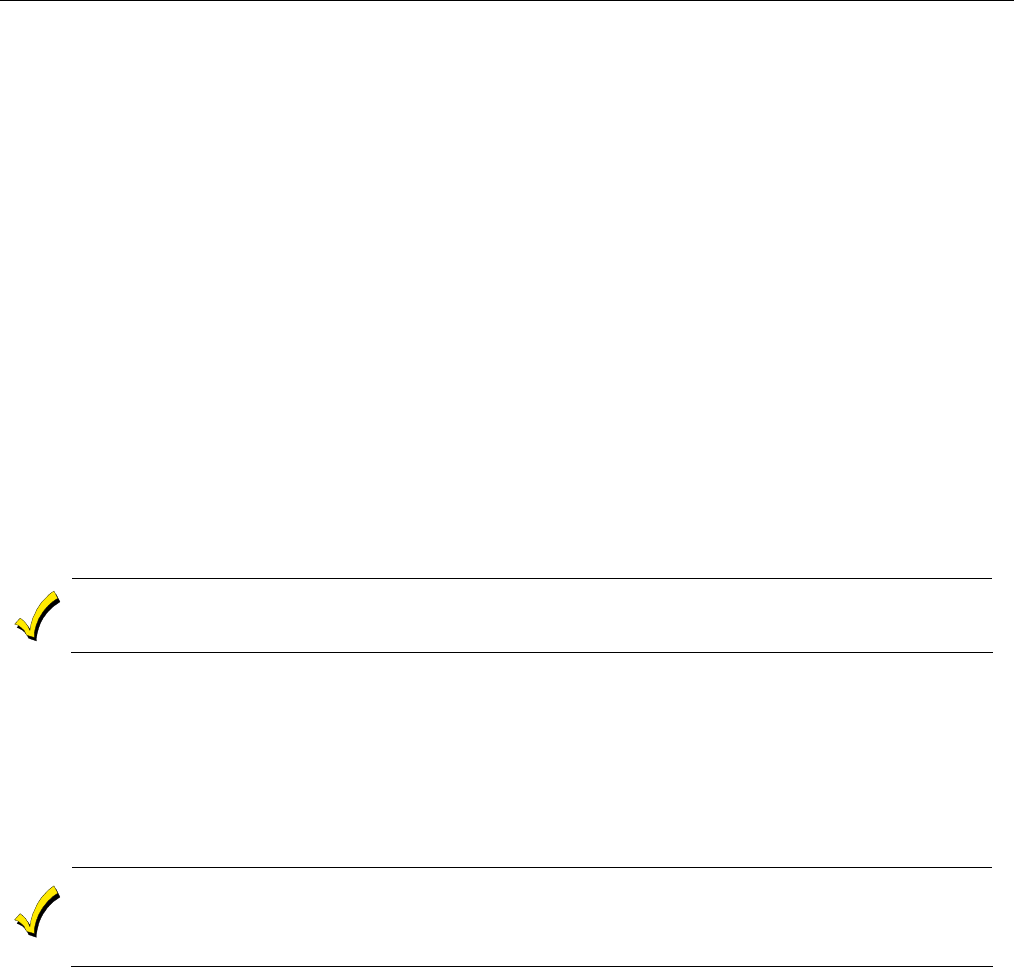
APX32EN Installation and Setup Guide
- 15 -
• Button-type transmitters should be periodically tested for battery life. The 5801, 5802MN, 5802MN2,
5804, 5804BD, 5804BDV, and 5804E button transmitters have replaceable batteries.
Using the Transmitter Sniffer Mode
Use this mode after all transmitters have been entered to check that all transmitters have been properly
programmed.
1. Enter Installer code (4112) + [#] + 3.
Note: If the communicator is in the process of sending a report to the central station, the system will not go into the Sniffer
mode. If so, wait a few minutes and try again.
2. The keypad will display all zone numbers, which have a non-zero Zone Type (even if serial numbers were
not learned yet). Fault each transmitter in turn, causing each one to send a signal. As the system
receives a signal from each of the transmitters, the zone number of that transmitter will disappear
from the display. The transmitters may be checked upon installation, or in an installed system.
3. When all transmitters have been checked, exit Sniffer mode. Enter Installer Code (4112) + OFF.
Notes: (1) Sniffer mode does not automatically expire. You must manually exit (Installer Code + OFF) Sniffer
mode to return to normal operation.
(2) All BR-type units must physically be activated to clear the display, since they do not automatically send check-in
signals.
(3) When one button of a transmitter (RF, UR, or BR) is activated, all zones assigned to other buttons on that
transmitter are cleared. This also applies to 5816 and 5817 transmitters that have multiple loops (zones).
(4) Any transmitter that is not “entered” will not turn off its zone number.
Go/No Go Test Mode
5804E encrypted (High-Security) devices must be activated while the system is in Go/No Go Test Mode.
Refer to the transmitter’s installation instructions for complete details. The system will confirm
enrollment of the encrypted device by beeping two times.
The Go/No Go tests will verify adequate RF signal strength from the proposed transmitter location, and
allow you to reorient or relocate transmitters if necessary, before mounting the transmitters permanently.
This mode is similar to the transmitter Test mode, except that the wireless receiver gain is reduced. This
will enable you to make sure that the RF signal from each transmitter is received with sufficient signal
amplitude when the system is in the normal operating mode.
1. Enter Installer Code (4112) + [#] + 8.
2. Once you have placed transmitters in their desired locations and the approximate length of wire to be
run to sensors is connected to the transmitter's screw terminals (if used), fault each transmitter.
Conducting this test with your hand wrapped around the transmitter will cause inaccurate results.
On button type transmitters that have been programmed to set ARM AWAY, ARM STAY, or DISARM,
pressing a button will take the system out of the Go/No Go Test mode and cause the programmed action
to occur.
Note: On button type transmitters that have been programmed to set ARM AWAY, ARM STAY, or DISARM, pressing a button
will take the system out of the Go/No Go Test mode and cause the programmed action to occur.
a. The keypad will beep three times indicating signal reception and will display the appropriate zone
number.
b. If the keypad does not beep, reorient or move the transmitter to another location. Usually a few
inches in either direction is all that is required.
3. If each transmitter produces the proper keypad response when it is faulted, you can then permanently
mount each of the transmitters according to the instructions provided with them.
4. Exit the Go/No Go Test mode by entering: Installer Code (4112) + OFF.
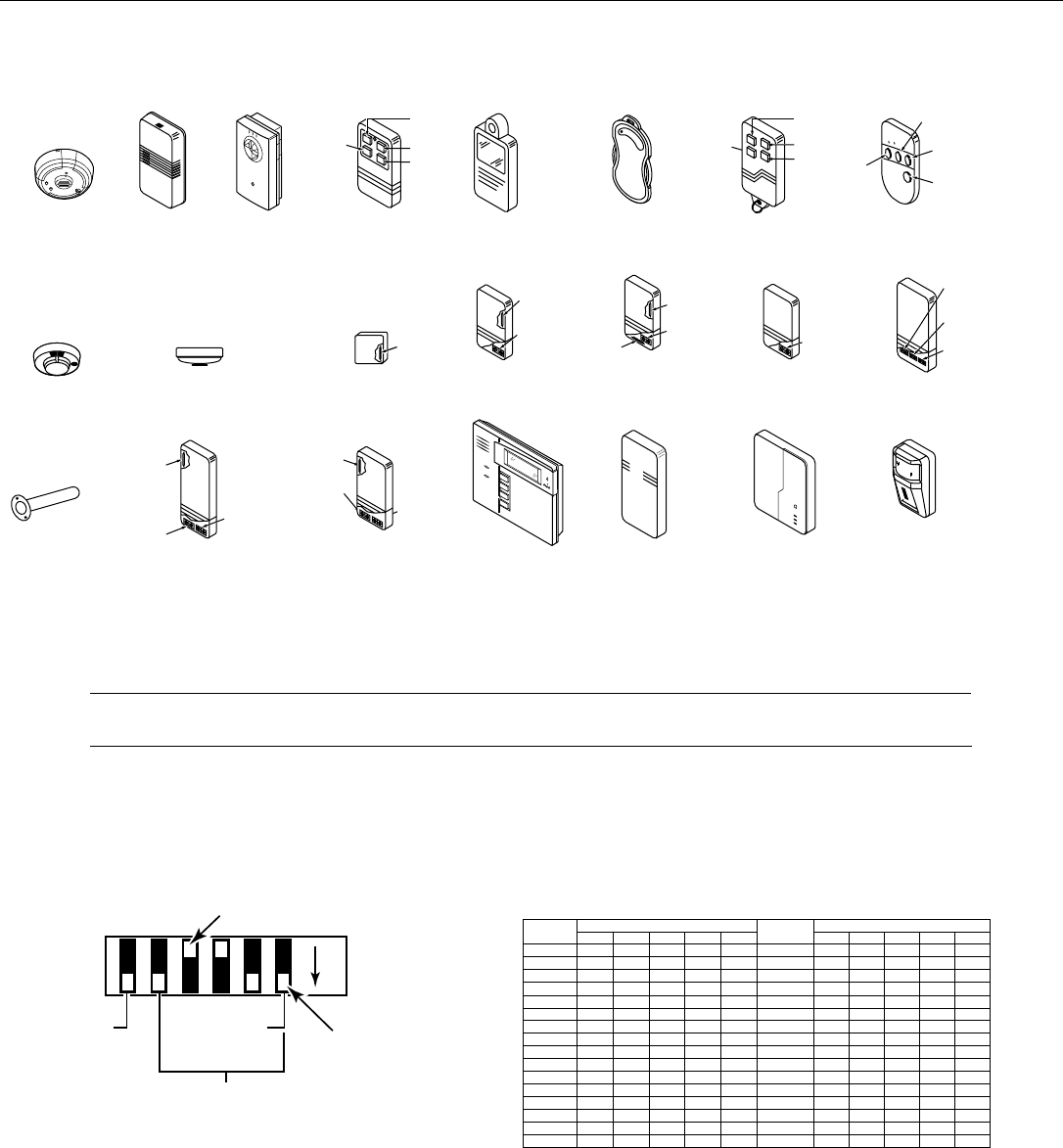
APX32EN Installation and Setup Guide
- 16 -
5800 Series Transmitter Loop Numbers (Refer to this information when programming transmitters)
The following illustration shows the compatible transmitters, their associated input types and loop
designations.
LOOP 1
5806/5807/5808/5808LST
ENROLL AS
"RF"
LOOP 1
5809
ENROLL AS
"RF"
5818
ENROLL AS
"RF"
LOOP 1
LOOP 1
5814
ENROLL AS
"RF"
09012-013-V0
5828/5828V
PROGRAM
HOUSE ID
LOOP 1
(MOTION)
5890/5890PI
ENROLL AS
"RF"
LOOP
1
5802 MN
ENROLL AS
"UR" OR "RF"
5804BD/5804BDV
ENROLL AS
"BR"
PROGRAM HOUSE ID
LOOP 4
YOU MUST
ENROLL
THIS BUTTON
LOOP 3
LOOP 1
LOOP 2
•
•
••
•
•
•
•
•
•
•
•
•
•
•
•
•••
5804/5804E
ENROLL AS "BR"
LOOP 1
LOOP 2
LOOP 4
YOU MUST
ENROLL
THIS
BUTTON
OFF
LOOP 3
ON
5816TEMP
ENROLL AS
"RF"
LOOP 1
(TEMP
SENSOR)
5817
ENROLL AS
"RF"
LOOP 2
(AUX.
CENTER)
LOOP 1
(PRIMARY)
LOOP 3
(AUX.
RIGHT)
5816
ENROLL AS
"RF"
LOOP 1
(TERMINALS)
LOOP 2
(REED)
5816MN
ENROLL AS
"RF"
LOOP 1
(TERMINALS)
ALTERNATE
POSITION
FOR LOOP 2
LOOP 2
(REED)
LOOP 3
(TERMINALS)
5819S (WHS & BRS)
ENROLL AS
"RF"
LOOP 1
(INTERNAL
SHOCK
SENSOR
LOOP 2
(REED)
5819
ENROLL AS
"RF"
LOOP 2
(REED)
LOOP 3
(TERMINALS)
LOOP 1
(TERMINALS)
5800WAVE
PROGRAM
HOUSE ID
5800CO
ENROLL AS "RF"
5800RL
SET
HOUSE ID
5801
ENROLL AS
"UR" OR "RF"
LOOP 3
LOOP 1
LOOP 2
LOOP 4
YOU MUST
ENROLL
THIS
BUTTON
5849
ENROLL AS
"RF"
LOOP 1
(SOUND)
5802 MN2
ENROLL AS
"UR" OR "RF"
LOOP
1
LOOP
1
5850 (GBD)
ENROLL AS
"RF"
(Green)
(Red)
(Yellow)
ARMED
READY
Notes: (1) Loop 4 must be enrolled on the 5801, 5804, 5804BD, 5804BDV and 5804E transmitters, whether or not the loop is used.
(2) 5804E encrypted (High-Security) devices must be activated while the system is in Go/No Go Test Mode. Refer to the
transmitter’s installation instructions for complete details. The system will confirm enrollment of the encrypted device by
beeping two times.
UL The 5800CO, 5800RL, 5802MN, 5802MN2, 5804, 5804BD, 5804BDV, 5804E, 5814, 5816TEMP, 5819, 5819S(WHS &
BRS), 5828/5828V and 5850(GBD) wireless transmitters have not been evaluated by UL.
Setting DIP Switches on the 5800RL Transmitter
Set the 5800RL Transmitters to the programmed House ID, by using the DIP switches.
(OFF position is indicated by ---)
Note: The 5800RL cannot be used in conjunction with the Auto Arm (scheduled arming) feature.
01000-014-V1
234561
SW-6 SETS
MODE
2-6 SETS HOUSE ID
SW-1 ACTIVATES
MODE SETTING SWITCH DOWN
FOR "OFF"
SHOWN SET FOR HOUSE ID# 12
SWITCH UP FOR "ON"
5800RL DIP SWITCH TABLE
DIP SWITCH POSITIONS DIP SWITCH POSITIONS House
ID 2 3 4 5 6
House
ID 2 3 4 5 6
0 --- --- --- --- --- 16 ON --- --- --- ---
1 --- --- --- --- ON 17 ON --- --- --- ON
2 --- --- --- ON --- 18 ON --- --- ON ---
3 --- --- --- ON ON 19 ON --- --- ON ON
4 --- --- ON --- --- 20 ON --- ON --- ---
5 --- --- ON --- ON 21 ON --- ON --- ON
6 --- --- ON ON --- 22 ON --- ON ON ---
7 --- --- ON ON ON 23 ON --- ON ON ON
8 --- ON --- --- --- 24 ON ON --- --- ---
9 --- ON --- --- ON 25 ON ON --- --- ON
10 --- ON --- ON --- 26 ON ON --- ON ---
11 --- ON --- ON ON 27 ON ON --- ON ON
12 --- ON ON --- --- 28 ON ON ON --- ---
13 --- ON ON --- ON 29 ON ON ON --- ON
14 --- ON ON ON --- 30 ON ON ON ON ---
15 --- ON ON ON ON 31 ON ON ON ON ON
Setting 5800RL DIP Switches

APX32EN Installation and Setup Guide
- 17 -
Mechanics of Programming
General Programming Information
Programming options are stored in non-removable, electrically erasable, nonvolatile EEROM memory. The
system can be programmed at any time, even at the installer's premises prior to the actual installation.
Simply apply power temporarily to the Control and then program the unit as desired. There are four
programming modes:
• Data field programming (used for setting various system options).
• Interactive menu mode programming (used for programming zone information, programming
Powerline Carrier Devices, and for entering transmitter serial numbers).
• Voice Prompt programming (used for setting various system options).
• Pass-Thru programming (used for programming connected LRR/IP Communications Device).
The system can also be programmed remotely, using an IBM Personal Computer and Compass
Downloader and modem or via capable GSM or IP communications modules. See the Remote
Programming/Control (Downloading) section.
Note: You may find it convenient to adjust the volume setting before entering the Program Mode. This will allow you to
clearly hear the feedback announcements or system beeps in the Programming Mode, of the system’s built-in
speaker. To adjust the volume, press FUNCTION + VOLUME+ [3] or [6]. Upon exiting the Program Mode, the
system will reset the volume to the default value (mid level).
Entering Program Mode
Use one of the following methods to enter Programming Mode:
1. Press both the [✻] and [#] keys at the same time, within 50 seconds after power is applied to the
Control or from exiting Programming mode, OR
2. After power-up, enter the Installer Code (4112) + 800 to enter Expert Programming mode (This
method disabled if Program mode is exited using ✻98). OR enter Installer Code (4112) + 888 to enter
Voice Prompt Programming mode.
If a different Installer Code has been programmed, use that code to enter the Programming mode.
3. Upon entering programming mode, the control will display “--” for up to two seconds indicating it is
communicating with the LRR/IP devices.
4. Once you have entered the Program mode, data field “20” (the first data field in the system) will be
displayed and both keypad LEDs will flash. If you have entered the Voice Prompt Programming mode.
“Pro” will be displayed.
Programming a Data Field
1. Press [✻] + Field No. (for example, ✻21), followed by the required entry.
2. When you have completely programmed a data field, the keypad will “beep” three times and then
automatically display the next data field in sequence. To go to a different field, press [✻] plus the
desired field number.
3. If the number of digits that will be entered in a data field is less than the maximum number of digits
available (e.g. phone number field), enter the desired data, then press [✻] to advance to the next data
field.
4. If a nonexistent field has been entered, the keypad will display “EE”. Simply re-enter [✻] plus a valid
field number.
To view a data field without making changes: Enter [#] + Field No. Data will be displayed for that field.
To delete an entry in a field: Enter [✻] + Field No. + [✻]. (Applies only to fields ✻40–✻44, ✻88 and ✻94).
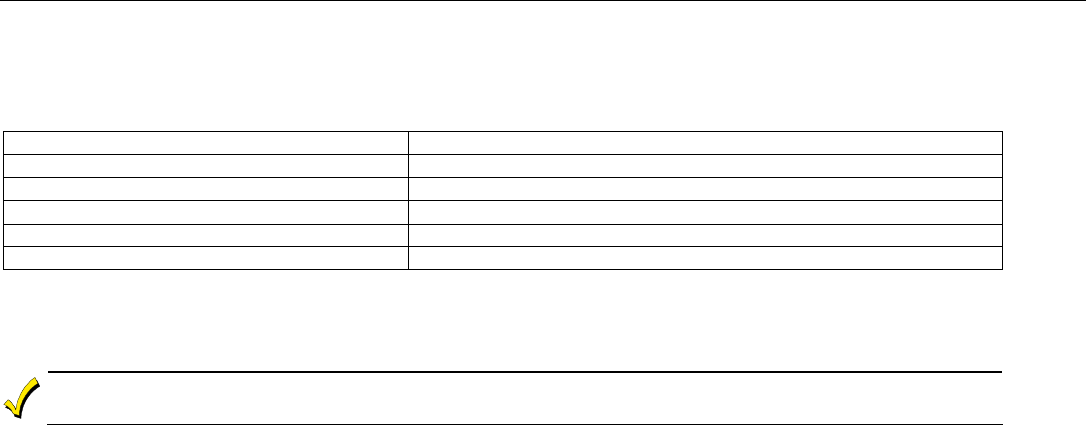
APX32EN Installation and Setup Guide
- 18 -
Interactive Menu Mode Programming (✻56, ✻80, ✻81, ✻83, ✻84, ✻85)
Press [✻] + interactive mode No. (i.e., ✻56). The keypad will display the first of a series of prompts. A detailed
procedure (with displays of prompts) is provided in later sections of this manual.
Interactive Mode Used to Program
✻56 Enhanced Zone Programming Mode Zone characteristics, report codes, and serial numbers
✻80 Device Programming Menu Mode Powerline Carrier Devices
✻81 Zone List Menu Mode Zone Lists for powerline carrier activation
✻83 Enhanced Sequential Mode 5800 Series transmitter serial numbers
✻84 Assign Zone Voice Descriptors Voice descriptors for each zone
✻85 Record Custom Voice Descriptors Up to 5 custom voice descriptors for zones
Loading Factory Defaults
To load the factory defaults, enter the Programming mode, press ✻97, then press number 1, 2, 3, or 4 to
select from default tables 1-4 at the back of this manual, or press “0” if you are not selecting a default table.
If a default table is loaded, any data that has already been programmed into the system will be changed according to the
default table selected!
✻96 resets all subscriber account numbers and CSID in preparation for an initial download.
Exiting Program Mode
✻98 inhibits re-entry into the Expert or Voice Prompt Programming modes using the Installer Code.
✻99 allows re-entry into the Expert Program mode using Installer Code (4112) + 800 or into the
Voice Prompt Programming mode using Installer Code (4112) + 888.
Note: After exiting program mode (or upon power-up), the system takes up to a minute to reset. To bypass the reset
delay, press [#] + [0].
Pass-Thru Programming
This mode allows the Installer to use the APX32EN keypad and display to program the communications
device that is connected to the APX32EN. Refer to the communications device’s installation instruction to
determine whether this feature is supported.
Entering Pass-Thru Programming mode
1. After power-up, enter the Installer Code (4112) + 899.
2. Once you have entered Pass-Thru Programming mode “PtP” will be displayed on the keypad.
3. Refer to the Installation Instructions for the LRR/IP Communications Device being installed for
additional programming information.
APX32EN will abort this mode:
• When it receives an abort command from the new communications device.
• If it fails to communicate with a communications device after 20 attempts.
• 30 minutes after the last key has been pressed.

APX32EN Installation and Setup Guide
- 19 -
Zone Response Type Definitions
General Information
During programming, you must assign a zone type to each zone, which defines the way in which the system
responds to faults in that zone. Zone types are defined below.
Type 00
Zone Not Used
Zone type 00 is used to program a zone that is not used.
Type 01
Entry/Exit
Burglary #1
Zone type 01 is usually assigned to sensors or contacts on primary entry and exit doors.
Zone Characteristics:
• Entry delay #1 is programmable from 0-99 seconds (field ✻35).
• Exit delay is independently programmable from 0-99 seconds (field ✻34).
• Exit and entry delays when armed in AWAY or STAY mode.
• No entry delay when armed in STAY NO DELAY or AWAY NO DELAY mode.
• Exit delay regardless of the arming mode selected.
Type 02
Entry/Exit
Burglary #2
Zone type 02 is usually assigned to sensors or contacts on which secondary entry and exit doors
that might be further from the keypad (typically used for a garage, loading dock, or basement
door).
Zone Characteristics:
• Entry delay #2 is programmable from 0-99 seconds (field ✻36).
• Exit delay is independently programmable from 0-99 seconds (field ✻34).
• Secondary entry delay, if armed in the AWAY or STAY mode.
• No entry delay when armed in the STAY NO DELAY or AWAY NO DELAY mode.
• Exit delay begins regardless of the arming mode selected.
Type 03
Perimeter
Burglary
Zone type 03 is usually assigned to all sensors or contacts on exterior doors and windows.
Zone Characteristics:
• Instant alarm, when armed in AWAY, STAY, STAY NO DELAY, or AWAY NO DELAY mode.
Type 04
Interior,
Follower
Zone type 04 is usually assigned to a zone covering an entry area (i.e.: foyer, lobby, or hallway)
that one must pass upon entry (after faulting the entry/exit zone) to reach the keypad. It
provides an instant alarm if the entry/exit zone is not violated first, and protects an area in the
event an intruder has hidden on the premises before the system is armed, or gains access to the
premises through an unprotected area.
Zone Characteristics:
• Delayed alarm (using the programmed entry/exit time) if entry/exit (types 01 or 02) or
interior-with-delay (type 10) zone is faulted first.
• Instant alarm in all other situations.
• Active when armed in AWAY or AWAY NO DELAY mode.
• Bypassed automatically when armed in STAY or STAY NO DELAY mode.
Type 05
Trouble by Day/
Alarm by Night
Zone type 05 is usually assigned to a zone that contains foil-protected doors or windows or covers
a sensitive area (i.e.: stock room, drug supply room, etc.) It can also be used on a sensor or
contact in an area where immediate notification of an entry is desired.
Zone Characteristics:
• Instant alarm, when armed in AWAY, STAY, STAY NO DELAY, or AWAY NO DELAY
(night) mode.
• Provides a latched trouble sounding from the keypad and, if desired, a central station report
during the disarmed state (day).
Type 06
24-hour
Silent Alarm
Zone type 06 is usually assigned to a zone containing an Emergency button (silent emergency).
Zone Characteristics:
• Sends a report to the central station but provides no keypad display or sounding.
Type 07
24-hour
Audible Alarm
Zone type 07 is usually assigned to a zone containing an Emergency button (audible emergency).
Zone Characteristics:
• Sends a report to the central station, and provides alarm sounds externally and at the
keypad.
Type 08
24-hour
Auxiliary Alarm
Zone type 08 is usually assigned to a zone containing a button for use in personal emergencies or
to a zone containing monitoring devices (i.e.: water or temperature sensors, etc.).
Zone Characteristics:
Sends a report to the central station and provides an alarm sound at the keypad. (No bell output
is provided and there is no keypad timeout.)

APX32EN Installation and Setup Guide
- 20 -
Zone Response Type Definitions
Type 09
Supervised Fire
Zone type 09 can be assigned to any wireless zone used as a fire zone. This zone type is always
active and cannot be bypassed.
Zone Characteristics:
• Bell output will pulse when this zone type is alarmed.
Type 10
Interior w/Delay
Zone type 10 is bypassed when the panel is armed in STAY or STAY NO DELAY mode.
Zone Characteristics:
• Entry delay #1 (with programmed entry time) when armed in the AWAY mode.
• Entry delay begins whenever sensors in this zone are violated, regardless of whether an
entry/exit delay zone was tripped first.
• No entry delay when armed in the AWAY NO DELAY mode.
• Exit delay regardless of the arming mode selected.
Type 14
24-hour Carbon
Monoxide
Monitor
Zone type 14 can be assigned to any wireless zone with a carbon monoxide detector. This zone type
is always active and cannot be bypassed.
Zone Characteristics:
Bell output will pulse when this zone type is alarmed.
Type 20
Arm–Stay
Zone type 20 is a special-purpose zone type used with 5800 Series wireless pushbutton units.
Zone Characteristics:
• Exit delay regardless of the arming mode selected.
• System is armed in the STAY mode when the zone is activated.
• Zone number is sent to the central station as a user number when arming or disarming.
Type 21
Arm–Away
Zone type 21 is a special-purpose zone type used with 5800 Series wireless pushbutton units.
Zone Characteristics:
• System is armed in the AWAY mode when the zone is activated.
• Zone number is sent to the central station as a user number when arming or disarming.
Type 22
Disarm
Zone type 22 is a special-purpose zone type used with 5800 series wireless pushbutton.
Zone Characteristics:
• Disarms the system when the zone is activated.
Type 23
No Alarm
Response
Zone type 23 can be used on a zone when a Powerline Carrier Device (e.g., X10) action is desired,
but with no accompanying alarm (e.g., front door light).
Type 24
Silent Burglary
Zone type 24 is usually assigned sensors or contacts on exterior doors and windows where bells
and/or sirens are NOT desired.
Zone Characteristics:
• Instant alarm, with NO audible indication when is armed in the AWAY, STAY, STAY NO
DELAY, or AWAY NO DELAY mode.
• Report sent to the central station.
Note: Keypad beeps if the zone is faulted when system is disarmed and Chime mode is on.

APX32EN Installation and Setup Guide
- 21 -
Data Field Descriptions
Defaults (where applicable) are Indicated in bold text.
The following pages list all data fields in this Control (in numerical order). Use the blank programming form
to record the data for this installation. Note that both keypad LEDs flash while in Programming mode.
Note: Entering a number other than the one specified will give unpredictable results.
✻20 Installer Code
Enter 4 digits, 0-9
The Installer Code is used to enter the 4-digit Master Security
Code. See "Master Code" in the System Operation section for
procedure.
✻21 Quick Arm Enable
0 = do not allow quick arm
1 = allow quick arm
If enabled, security code is not required to arm the system. The
user simply presses and holds down the AWAY or STAY key to
arm.
✻22 Keypad Backlight Timeout
0 = no timeout; always backlight keys
1 = turn backlighting off after inactivity
This option allows the choice of either always backlighting the
keypad or turning the backlighting off after 10 seconds of
keypad inactivity.
✻23 Forced Bypass
0 = no forced bypass
1 = provide automatic bypass of all open (faulted) zones
All zones bypassed by this function will be displayed after the
bypass is initiated.
UL installations: must be 0 (no forced bypass)
✻24 RF House ID Code
00 = disable all wireless keypad usage
01-31 = House ID
The House ID identifies receivers and wireless keypads.
If a 5804BD/5804BDV Transmitter is to be used, a House ID
Code MUST be entered, and the keypad should be set to the
same ID.
✻25 Powerline Carrier Device (X10) House ID
0 = A 4 = E 8 = I # + 12 = M
1 = B 5 = F 9 = J # + 13 = N
2 = C 6 = G # + 10 = K # + 14 = O
3 = D 7 = H # + 11 = L # + 15 = P
Powerline Carrier Devices require a House ID. This field
identifies this House ID to the Control. The Powerline Carrier
Devices are programmed in field ✻80.
✻26 Chime by Zone
0 = no (chimes on fault of any entry/exit or perimeter
zone when Chime mode is activated)
1 = yes (chimes on fault of those zones assigned to
Zone List 3 when Chime mode on)
This option allows the installer to define the specific zones
intended to chime when faulted while the system is in Chime
mode. If enabled, these zones are defined in zone list 3 (see ✻81
Zone List Menu Mode).
✻27 Real Time Clock Display
0 = do not display the time
1 = display the time
Refer to the User’s Manual for setting the clock time and date.
✻29 Daylight Savings Time Start/End Month
0, 0 = no daylight saving time used
1-12 = start month and end month
Enter # + 10 for 10, # + 11 for 11, and # + 12 for 12.
✻30 Daylight Savings Time Start/End Week
0 = disable 4 = fourth weekend
1 = first weekend of month 5 = last weekend
2 = second weekend 6 = next to last
3 = third weekend 7 = 3rd from last
Enter the appropriate start and end weekend of the month.
✻31 Single Alarm Sounding Per Zone
(per armed period)
0 = Alarm Sounding Per Zone will be the same as the
Swinger Shutdown” set in field *92
1 = limit alarm sounding to once per arming period for
a given zone
UL installations: must be 0
This field applies only to burglary zones (zone response types 1-
5, 10), and affects long range radio reporting but does not affect
central station reporting.
Notes: 1. This field applies only to the bell and does not affect keypad
sounds.
2. If swinger shutdown occurs (see Swinger Shutdown in Field
✻92), the number of alarm soundings on a given zone will
be limited by the setting selected in Field ✻92.
✻32 Sounder Timeout
0 = yes, sounder timeout after time programmed in field
✻33
1 = no sounder timeout; continue sounding until
manually turned off
This Control complies with NFPA requirements for temporal
pulse sounding of fire and carbon monoxide (CO) notification
appliances.
Temporal pulse sounding for a fire alarm consists of the
following: 3 pulses – pause – 3 pulses – pause – 3 pulses. . .
Temporal pulse sounding for a CO alarm consists of the
following: 4 pulses – pause – 4 pulses – pause – 4 pulses –
pause. . .
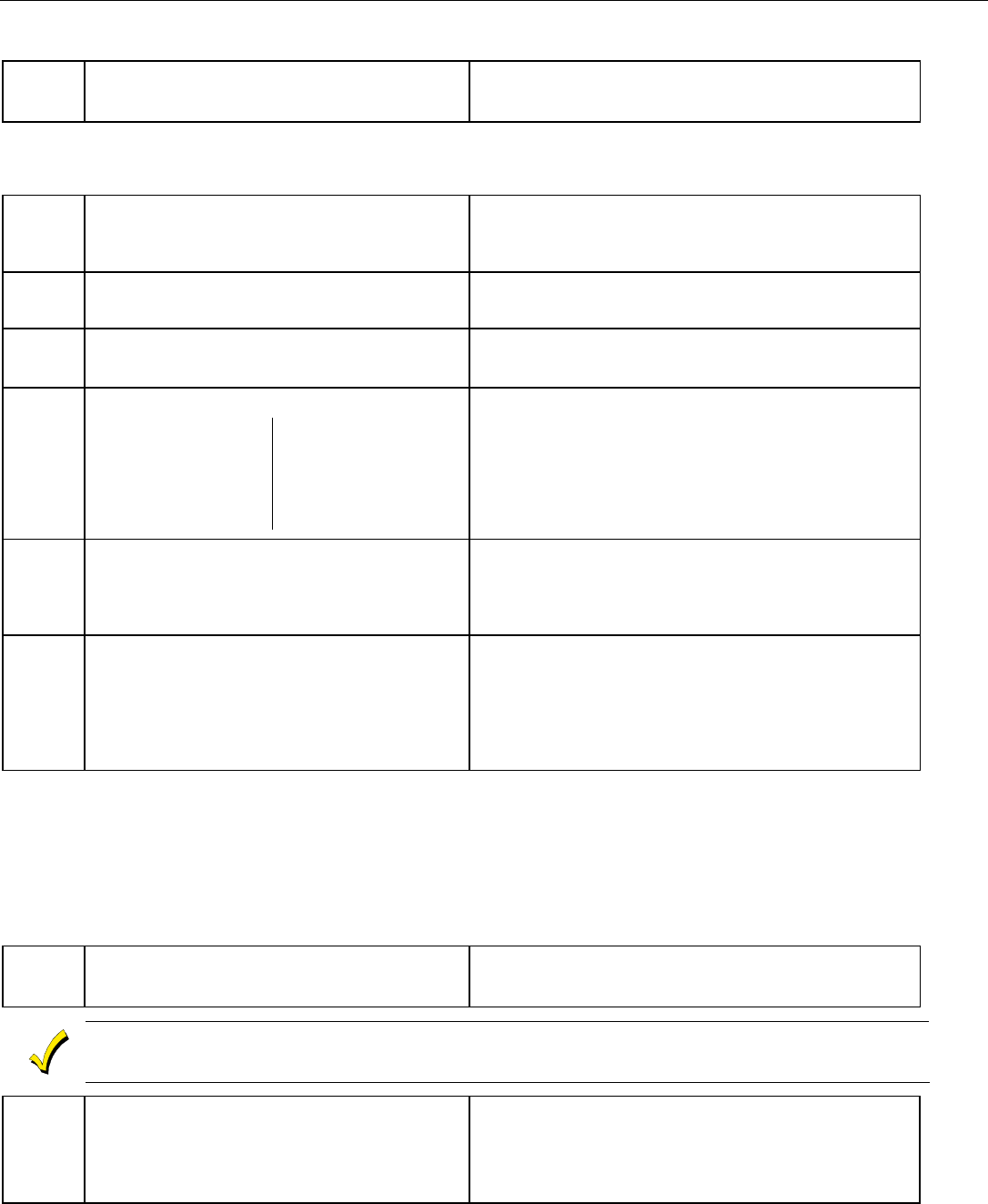
APX32EN Installation and Setup Guide
- 22 -
Data Field Descriptions
✻33 Alarm Bell Timeout
0 = No timeout 2 = 8 min 4 = 16 min
1 = 4 min 3 = 12 min
This field determines whether the external sounder will shut
off after time allowed, or continue until manually turned off.
UL installations: must be set for a minimum of 4 min (option 1)
DELAY PROGRAMMING (✻34–✻36)
NOTE: The control validates the data entered in these fields. If the selection is not valid the control will emit a single long beep indicating that
the selection has been rejected. The control replaces the selection with the default value which is displayed on the keypad.
✻34 Exit Delay
00-99 = exit delay time in seconds
The system will wait the time entered before sounding an
alarm if the exit door is left open after the system has been
armed.
UL installations: must be set for a maximum of 60 seconds
✻35 Entry Delay 01
00-99 = entry delay time in seconds.
The system will wait the time entered before sounding alarm upon
entering if system is not disarmed. UL installations: must be set for a
maximum of 45 seconds
✻36 Entry Delay 02
00-99 = entry delay time in seconds.
The system will wait the time entered before sounding alarm
upon entering.
UL installations: must be set for a maximum of 45 seconds
✻37 Audible Exit Warning/Quick Exit
Exit Warning Quick Exit
0 = no exit warning
sound
0 = no quick
exit
1 = provide exit
warning sound
when armed AWAY
1 = allow quick
exit
Exit Warning: Sound consists of slow continuous beeps until
last 5 seconds, when it changes to fast beeps. The warning
sound will end at the termination of exit delay.
Quick Exit: If enabled, user can restart the exit delay time after
arming in STAY mode by entering the user code and pressing
the STAY key, or by pressing the STAY key if Quick Arm is
enabled. This avoids having the user disarm then re-arm the
system after allowing someone to enter or exit
✻38 Confirmation of Arming Ding
0 = no ding
1 = confirmation ding after arming system
2 = confirmation ding after arming from RF button or RF
keypad only
Confirmation of arming is provided by a 1/2 second external
sounder “ding” that sounds when closing report is sent, or at
the end of exit delay.
If Option 2 is selected the external sounder “ding” occurs
immediately after the system receives the RF transmission.
✻39 Power Up In Previous State
0 = always power up in a disarmed state
1 = assume the system status prior to power-down
When the system powers up armed, an alarm will occur 1
minute after arming if a zone is faulted, and any bypassed
zones will be unbypassed.
Note: If the previous state was armed AWAY or STAY, the system
will not respond to sensor changes for 1 minute, which allows
time for sensors such as PIRs to stabilize.
UL installations: must be 1 (power up in previous state)
DIALER PROGRAMMING (✻40–✻50)
Fields ✻40, ✻41, ✻42: Enter up to the number of digits shown. Enter 0–9, # + 11 for ‘✻’; # + 12 for ‘#’; # + 13
for a pause (2 seconds)
NOTES: Whenever AAV is used, primary (field ✻41) and secondary (field ✻42) phone numbers should be preceded with the
call waiting disable command. Otherwise, there is the possibility of connection of the third party to APX32EN during
AAV mode. The PABX phone number entered in field ✻40 is not dialed on GSM/IP (Digital Communication with
AAV). However, it is used for dialing on Telco Line line.
✻40 PABX Access Code
Enter up to 6 digits if PABX is needed to access an
outside line.
If fewer than 6 digits need to be entered, exit by pressing [✻].
To clear entries from field, press ✻40✻.
If the GSM/IP (Digital Communication with AAV) feature is used (options 5 and 7 in *55), there may be restrictions
when dialing the numbers entered in *41, *42 and *46 (i.e.; #, ✻, pause may not be allowed, or phone number
extensions may not be dialed, etc) depending on the service provider.
✻41 Primary Phone No.
Enter up to 20 digits.
If fewer than 20 digits entered, exit by pressing [✻]. To clear
entries from field, press ✻41✻.
Note: Backup reporting (8 attempts are made to the secondary phone
number if no kissoff is received after 8 attempts to the primary
number) is automatic only if there is a secondary phone number
(field ✻42).
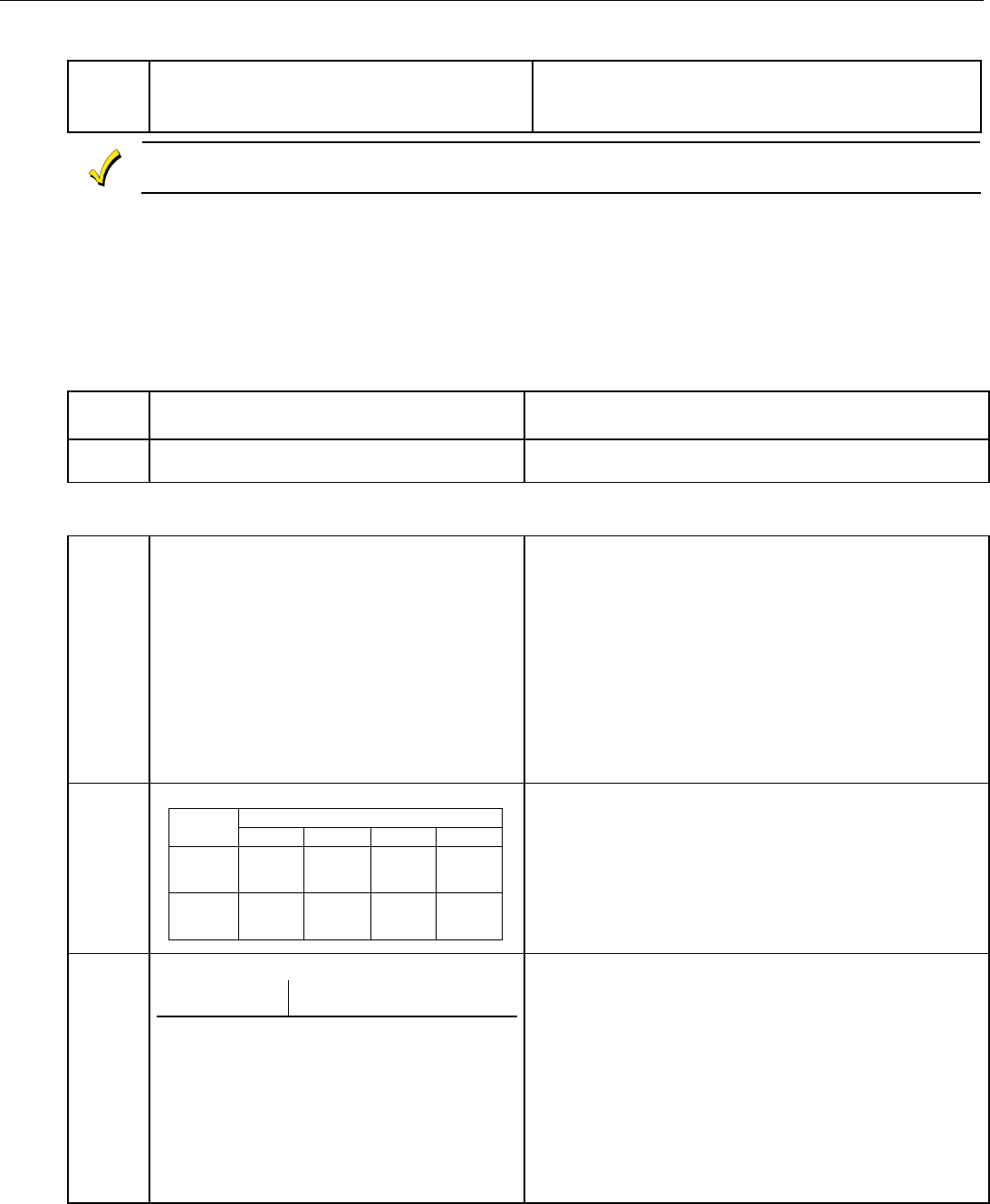
APX32EN Installation and Setup Guide
- 23 -
Data Field Descriptions
✻42 Secondary Phone No.
Enter up to 24 digits.
If fewer than 24 digits entered, exit by pressing [✻]. To clear
entries from field, press ✻42✻. See backup reporting note for
field ✻41. If using the paging feature, enter the pager phone
number here.
All four digits of the Subscriber Account number must be entered in Fields ✻43 and ✻44. If ten-digit format is
selected in ✻48 (option 5), all ten digits of the Subscriber Account number must be entered.
Fields ✻43 and ✻44:
Enter [✻] as the fourth digit if a 3-digit account number (for 3+1 dialer reporting format) is used. Enter 0 as
the first digit of a 4-digit account number for Nos. 0000–0999. Enter [✻] as the fifth digit if a 4-digit account
number (for 4+1, 4+2 CID®) is used. Exit field by pressing [✻] if only 3 digits are used. To clear entries from
field, press ✻43✻ or ✻44✻. See blank Programming Form for examples of account number entries. If using
the paging feature, do not enter a leading 0 in the subscriber account number, and do not use digits A-F
anywhere in the number. Some paging systems provide voice mail capability, which is activated by a leading
0 in the message. Enter digits 0–9; # +11=B; # +12=C; # +13=D; # +14=E; or # +15=F.
✻43 Primary Subs Account No.
Enter a four or ten digit account number.
Enter the primary subscriber account number.
To clear entries from field, press ✻43✻.
✻44 Secondary Subs Account No.
Enter a four or ten digit account number.
Enter the secondary subscriber account number.
To clear entries from field, press ✻44✻.
Field 46: Enter up to 24 digits. Do not fill unused spaces. Enter 0-9, #+11 for ‘*’; #+12 for’#’; #+13 for a pause
(2 seconds).
✻46 “Follow Me Reminder” Phone Number
Enter up to 24 digits.
This option allows the user to schedule a time driven message.
When activated the system will dial the phone number
programmed and deliver a voice message (custom words 72, 73
and 74). This option is only supported when the pager or follow
me feature is enabled in field ✻49 (option 6-9 or 10-13).
If using the Follow Me Reminder feature, enter the phone number
here. If fewer than 24 digits are entered, exit by pressing [✻]. To
clear entries from the field press ✻46✻.
The telephone message can be terminated (acknowledged) by
pressing any key on the telephone keypad. Pressing any key on
the local APX32EN keypad will terminate (acknowledge) both the
follow me and the local reminder announcements.
Note: The follow me reminder announcement will be terminated if any
other event requires the system to dial out or if an audible alarm
has occurred.
✻47 Phone System Select
Central Dialing Mode
Station Pulse Tone Pulse Tone
No WATS 0 = No
Speaker
Phone
1 = No
Speaker
Phone
4 = With
Speaker
Phone
5 = With
Speaker
Phone
WATS 2 = No
Speaker
Phone
3 = No
Speaker
Phone
6 = With
Speaker
Phone
7 = With
Speaker
Phone
This option is used to enter the correct type of phone dialing
(pulse or tone), and to select the correct WATS line option for the
Central Station. This option is used to activate the Speaker Phone
option.
Note: If using pulse dialing, you must enter the numbers slowly in
order to allow the pulse dialer time to operate.
✻48 Report Format for Primary/Secondary
Primary Secondary
See choices below See choices below
0 = 3+1; 4+1 ADEMCO Low Speed Standard
1 = 3+1; 4+1 Radionics Standard
2 = 4+2 ADEMCO Low Speed Standard
3 = 4+2 Radionics Standard
5 = ADEMCO Contact ID® Reporting with 10-digit
subscriber account number
6 = 4+2 ADEMCO Express
7 = ADEMCO Contact ID® Reporting with 4-digit
subscriber account number
8 = 3+1; 4+1 ADEMCO Low Speed Expanded
9 = 3+1; 4+1 Radionics Expanded
Enter ✻ as the 4th digit of ✻43 through ✻44, if 3+1 dialer
reporting is to be used. (For an explanation of these formats, see
the System Communication section of this manual.)
Notes: (1) The maximum number of alarm and alarm restore reports
during one armed period is determined by field ✻92.
(2) If Option 5 is selected a 10-digit account number must be
entered in Fields ✻43 or ✻44.
(3) Option 5 or 7 (ADEMCO Contact ID® Reporting) must be
selected for AAV.
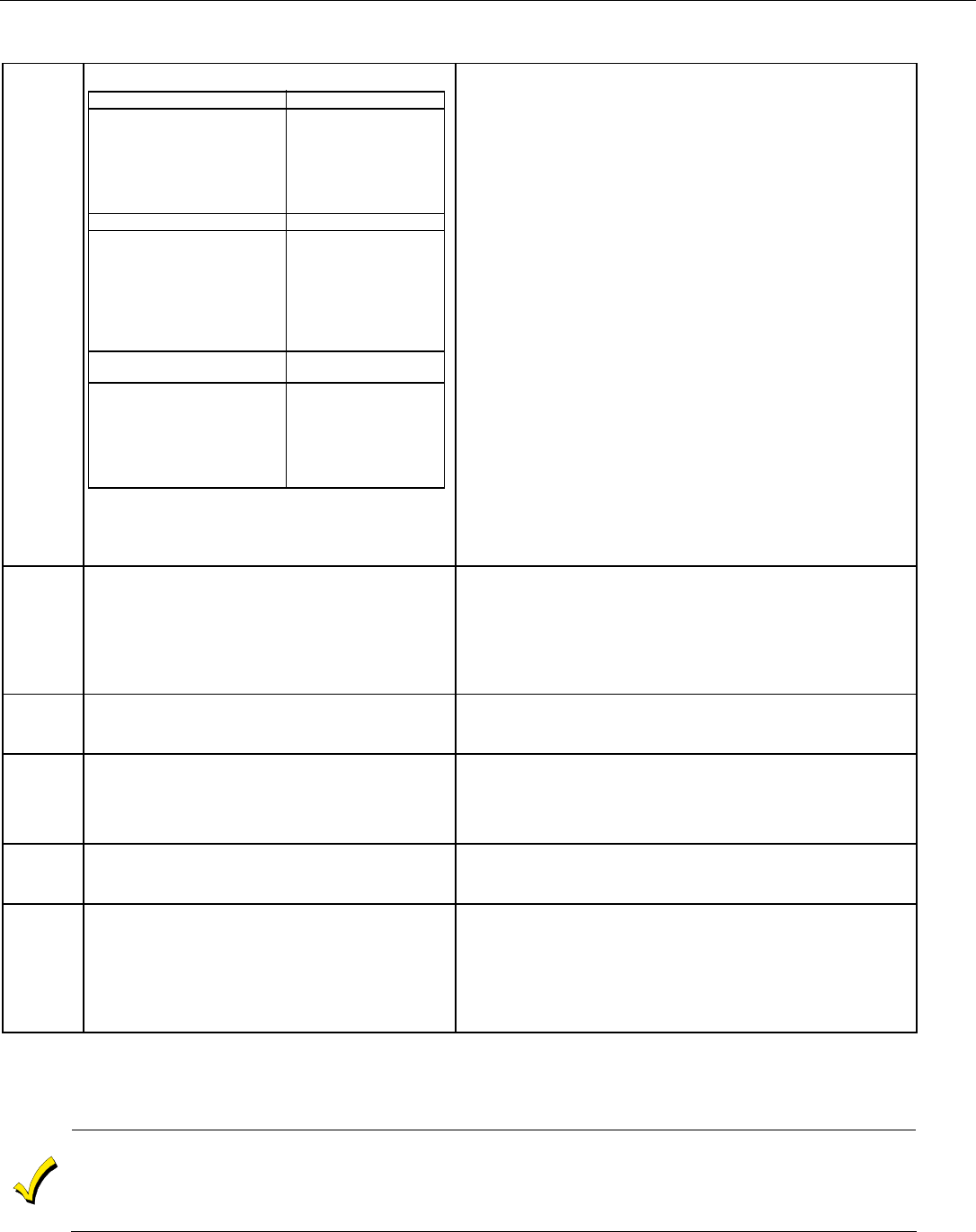
APX32EN Installation and Setup Guide
- 24 -
Data Field Descriptions
✻49 Split/Dual Reporting
To Primary To Secondary
0 = All reports None, unless primary
fails, then all
1 = Alarms, Restore, Cancel* Others
2 = All except Open/Close, Test Open/Close, Test
3 = Alarms, Restore, Cancel All
4 = All except Open/Close, Test All
5 = All reports All
To Primary To Paging Number
6 = All reports except Open/Close Alarms, Open/Close ‡,
Troubles
7 = All reports Alarms, Troubles
8 = All reports Alarms, Open/Close ‡,
Troubles
9 = All reports except Open/Close Open/Close ‡
To Primary To Follow Me System
Phone Number
10=All reports except Open/Close Alarms, Open/Close ‡,
Troubles
11 = All reports Alarms, Troubles
12=All reports Alarms, Open/Close ‡,
Troubles
13=All reports except Open/Close Open/Close ‡
*Recent close report is sent to primary number
‡ Will report Users 0, 5-8, and, if using wireless button-type
devices, will report the zone number of the arm or disarm
button 26-33. All other zones and users are not reported.
This field is used to select a reporting option as follows:
Enter: 0 - 5 when reporting to telephone receivers.
6 - 9 when reporting to a pager is desired.
10 - 13 when reporting to an auxiliary telephone receiver.
Pager Report Format
Options 6-9 send reports to the primary phone number, in a
format defined in Field ✻48, and send reports to a pager, which
has its phone number entered as the secondary phone number in
Field ✻42. The pager report is a 7-digit code, with optional 16-
digit prefix, in the following format:
AAAAAAAAAAAAAAAA-EEE–0NNN where:
AAA = Optional 16 digits for PIN number, etc. See Field ✻88 for full
description of these characters.
EEE = 3-digit Event Code as follows:
911 = Alarm (NN = zone number)
101 = Open, system disarmed (NN = user no.)
102 = Close, system armed (NN = user no.)
811 = Trouble (NN = zone no.)
0 = Always displayed before 3-digit user/zone no.
NNN = 3-digit user number or zone number, depending on the type of
event (EEE) that occurred.
Follow Me System Report Format
Options 10-13 send reports to the primary phone number, in a
format defined in Field ✻48, and sends voice message to the
secondary phone number entered in Field ✻42.
The message is a repeatable system status announcement. If the
manual paging option has been programmed in Field ✻87, the
message will repeat “system, system…..”.
The message can be terminated by pressing any key on the
telephone keypad.
✻50 15-Second Dialer Delay (Burglary)
0 = no dialer delay
1 = provide 15-second delay of burglary alarm report
when armed away
If enabled, provides delay of burglary report to the central station,
and allows time for the subscriber to avoid a false alarm
transmission. The delay applies only to zone type 3 and 5 alarms
and not to zone type 24 alarms (silent burglary) or to 24-hour zone
types 6, 7, and 8 (silent panic, audible alarm, auxiliary alarm),
which are always sent as soon as they occur.
UL installations: must be 0 (no delay)
✻51 Periodic Test Report
0 = no test report 2 = weekly
1 = once every 24 hrs 3 = once every 30 days
Test report code entered in field ✻64 is sent.
✻52 First test Report Offset
0 = 24 hrs after exit program mode or download
1 = 6 hours after exit program mode or download
2 = 12 hrs after exit program mode or download
3 = 18 hrs after exit program mode or download
Select the time for the first report following programming or
downloading.
✻53 Sescoa/Radionics Select
0 = Radionics (0–9, B–F reporting)
1 = SESCOA (0–9 only reporting)
If disabled, selects Radionics, which uses hexadecimal 0-9, B-F
reporting. If enabled, selects Sescoa, which uses only numeric
reporting (0-9). Select 0 for all other formats.
✻54 Lack of Usage Notification
0 = Disabled 4 = 90 days
1 = 1 day 5 = 180 days
2 = 7 days 6 = 365 days
3 = 27 days
Note: There is no local annunciation indicating that this
report has been sent to the Central Station.
If enabled, notifies the central station if an end user is not
operating their security system by sending a System Inactivity
report 654. The report will be sent only to the Primary phone
number and only if Contact ID® format was selected.
Note: The report will follow the ✻49 = 0 rules, no matter which selection
was made in ✻49.
Field ✻55:
If AAV is enabled in *91, depending on Communication Channels programmed in *55, only the Reporting
options from the table below are available. They should be programmed as described in Dynamic Signaling
(field *77). If AAV is disabled in field *91, only specific reporting options are available.
If Follow me System or Pager features are selected, AAV will not be available even if enabled in *91 UNLESS option 5 is selected
in *55 (Radio only). If option 5 is selected in *55, AAV will be established on the primary channel because Follow me System
and Pager are not available on the radios audio channel.
The following tables show the only valid combinations of communication channels and reporting options. It is the responsibility
of the installer to ensure that a valid combination is programmed.
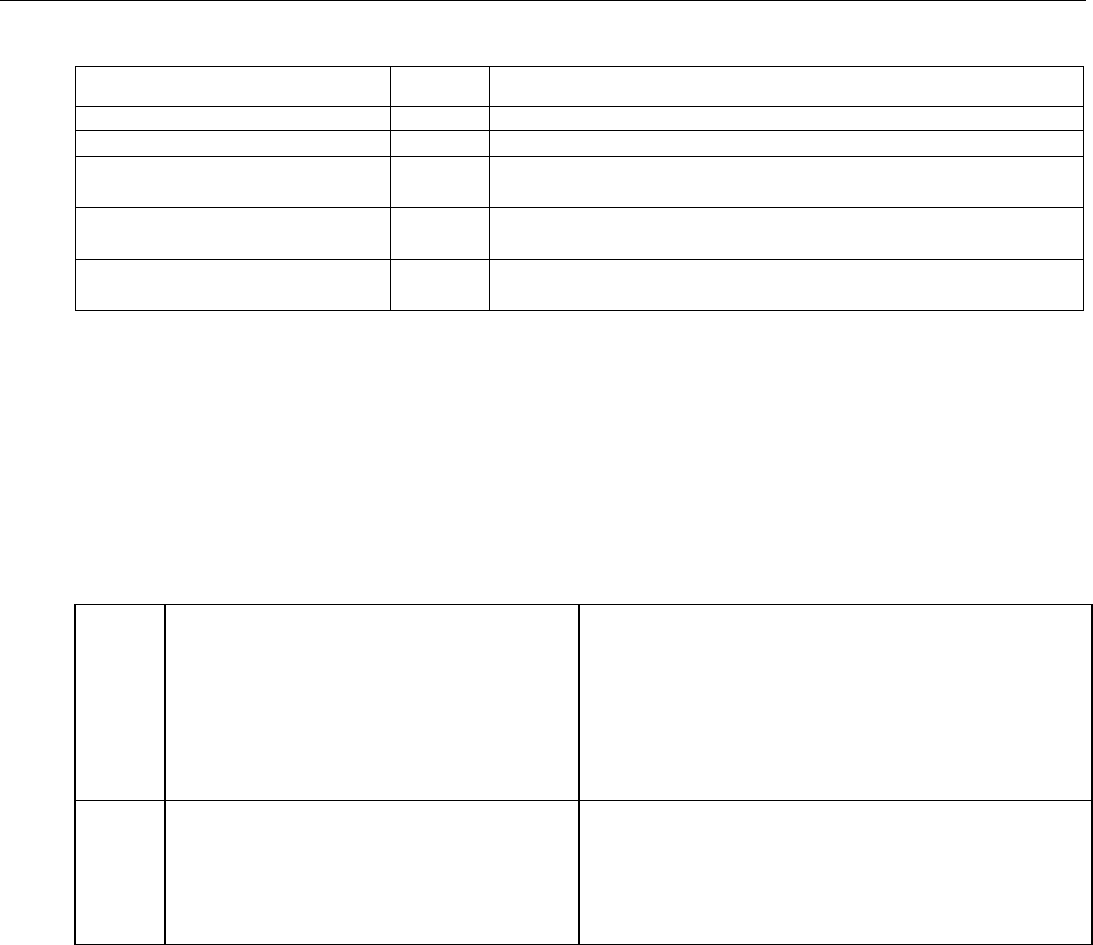
APX32EN Installation and Setup Guide
- 25 -
Data Field Descriptions
Reporting Option
AAV
Enabled? *55 Communication Channel
Primary Phone only Y/N 0 = Telco Line only (no radio) (see Note 1)
Redundant reports to both channels Y/N 1 = LRR/IP (Digital Communication only) and Telco Line (see Note 1)
Primary Phone is the preferred channel Y/N 1 = LRR/IP (Digital Communication only) and Telco Line (see Note 1)
Y 7 = LRR/IP (Digital Communication w/AAV) and Telco Line (see Notes 2 & 3)
LRR/IP is the preferred channel
Y/N 1 = LRR/IP (Digital Communication only) and Telco Line (see Note 1)
LRR/IP Only N 3 = LRR/IP (Digital Communication only) (no Telco Line) (see Notes 4 & 5)
Y 5 = KRR/IP (Digital Communication w/AAV) (no Telco Line) (see Notes 4, 5, 6)
NOTES
1. AAV mode can be established only on Telco Line.
2. AAV mode can be established either on Telco Line or LRR/IP (Digital Communication with Voice Capabilities)
3. Primary phone number programmed in *41 is shared between Telco Line and LRR/IP (Digital Communication with Voice Capabilities)
4. Follow me System, Follow me Reminder and Pager features are not supported. These features will not work if selected in *49.
5. Speaker Phone and Remote Phone Access are not available. These features should be disabled in *47 and *91. Download over the
Phone Line feature is also unavailable.
6. AAV mode can be established only on LRR/IP (Digital Communication with AAV Capabilities)
Legend
LRR/IP (Digital Communication only) = Digital GSM Communication Channel
LRR/IP (Digital Communication with AAV) = GSM Communication Channel with voice capabilities (a radio with voice capabilities is not
required to use the voice capabilities)
Telco Line = Land Phone Line
✻55 Reporting Channels
0 = Telco Line (no Radio)
1 = LRR/IP(Digital Communication only) and Telco
Line
3 = LRR/IP (Digital Communication only) (no Telco
Line)
5 = LRR/IP (Digital Communication with AAV) (no
Telco Line)
7 = LRR/IP (Digital Communication with AAV) and
Telco Line
This option is used to enable/disable Central Station reporting via
the LRR/IP Communications Device (See Field *77). Upload/
download via the Internet IP module is not affected by this entry.
The option specifies the channel that the control will use when
sending reports to the Central Station (Follow Me phone, and
Pager). Select some or all channels as required.
IMPORTANT NOTE: Make sure that selected channels are physically
available and functional.
Notes: Zone 103 can not be bypassed.
✻58 RF Jam Detection
0 = no jam detection
1 = RF jam detection with event logging, but no
central station report
2 = RF jam detection with event logging and with
central station report (if trouble/restore report is
enabled in fields ✻60, ✻71)
For Event Logging, Option 2 must be selected.
If the control detects an RF Jam condition, an “OPEN” message
appears for zone 90. The Contact ID® code for RF Jam is 344.
SYSTEM STATUS AND RESTORE REPORT CODES PROGRAMMING (✻59 – ✻76, & ✻89)
Program Report Codes using the interactive ✻56 Enhanced Zone Programming Mode, or codes can be entered in data
fields ✻59-✻76, ✻89. The following is a set of guidelines when programming report codes. The actual report code digits
that you enter depend upon the particular installation, and should be in agreement with you and the central station
office receiving the signals.
With a 3+1 or 4+1 Standard Format: Enter a code in the first box: 1–9, A, B, C, D, E, or F. Enter "#+10" for A
(reports a “0” on some receivers), "#+11" for B, "#+12" for C, "#+13" for D, "#+14" for E, "#+15" for F. Entering "0" in the
first box will disable a report. Entering "0" in the second box results in automatic advance to the next field.
With an Expanded or 4+2 Format: Enter codes in both boxes (1st and 2nd digits) for 1–9, or A–F, as described above.
Entering "0" in the first box will disable a report. Entering "0" in the second box will eliminate the expanded message for
that report.
With ADEMCO Contact ID® Reporting: Enter a digit in the first box to enable the zone to report. Use a different
digit for each zone until you have used up available digits. If the number of zones exceeds the number of available
digits, begin with digit 1 again. This is an "enabling" code only and is not the actual code sent to the central station
office. Entries in the second boxes will be ignored. For system status (non-alarm) codes, enter a “1” in the first box for all
the system conditions you want to send to the central station. A "0" in the first box disables the report.

APX32EN Installation and Setup Guide
- 26 -
Data Field Descriptions
✻59 Exit Error Report Code
(See notes above)
If the system is armed and an entry/exit or interior zone is still
open after the exit delay time has expired, an alarm will sound at
the keypad and external sounder. If the system is disarmed before
the end of the entry delay that immediately follows, the alarm
sounding will stop and no message will be sent to the central
station. The keypad will display “CA (CANCELED ALARM).”
If the system is not disarmed before the end of the entry delay
mentioned above, and an entry/exit or interior zone is still open,
an “exit alarm” message will be sent to the central station if an
Exit Error report code is selected in this field. The keypad will
display “EA (EXIT ALARM),” and the alarm sounding will
continue until the system is disarmed (or timeout occurs).
An Exit Alarm condition will also result if a fault occurs in an exit
or interior zone within 2 minutes following the end of the exit
delay, and an “Exit Alarm” message will be sent to the central
station.
If Contact ID® format has been programmed, the message will
contain the zone number and error code 374 (Trouble–Exit
Error). If 4+2 format is used, the digit entered in this field will be
sent followed by the second digit of the programmed alarm code
for that zone. If 3+1 or 4+1 format is used, only the digit entered
in this field will be sent. This message will go to the primary
phone no. Under any of these conditions, no restore message will
be sent.
If “0” is entered in this field, no special message will be sent, only
the regular alarm and alarm restore code for the zone.
✻60 Trouble Report Code
(See notes above)
This will be sent if a zone goes into trouble.
✻61
Bypass Report Code
(See notes above)
This will be sent when a zone is manually bypassed.
✻62
AC Loss Report Code
(See notes above)
Timing of this report is random with up to a 4-hour delay. If AC
restores before the report goes out, there is no AC restore report.
✻63 Low Battery Report Code
(See notes above)
This will be sent when a low battery condition exists in the
system’s standby battery.
✻64 Test Report Code
(See notes above)
This is sent periodically to test that the communicator and phone
lines are operational (frequency of report is selected in field ✻51).
✻65 Open Report Code
(See notes above)
This is sent upon disarming of the system. 2nd digit = user
number, if expanded or 4+2 reporting is selected.
✻66 Arm AWAY/STAY Report Code
(See notes above)
This option allows for independent programming of AWAY and
STAY reports. 2nd digit of report is user number if expanded or
4+2 reporting is selected.
NOTE: OPEN reports are not sent if the associated closing report is not
enabled.
✻67 RF transmitter Low Battery Report Code
(See notes above)
This is sent in the event that a wireless transmitter low battery
condition exists.
✻68 Cancel Report Code
(See notes above)
This is sent upon disarming of the system after an alarm
condition was reported.
RESTORE REPORT CODES (✻70–✻76)
✻70 Alarm Restore Report Code, 1st Digit
(See notes above)
Sent when the zone that caused an alarm is restored to its non-
faulted condition. 2nd digit is automatically sent as the 2nd digit
of the zone alarm report code programmed in field ✻56, if
expanded or 4+2 reporting is selected.
✻71 Trouble Restore Report Code
(See notes above)
Sent when a trouble in a zone is restored.
✻72 Bypass Restore Report Code
(See notes above)
Sent when a zone that has been bypassed is unbypassed.
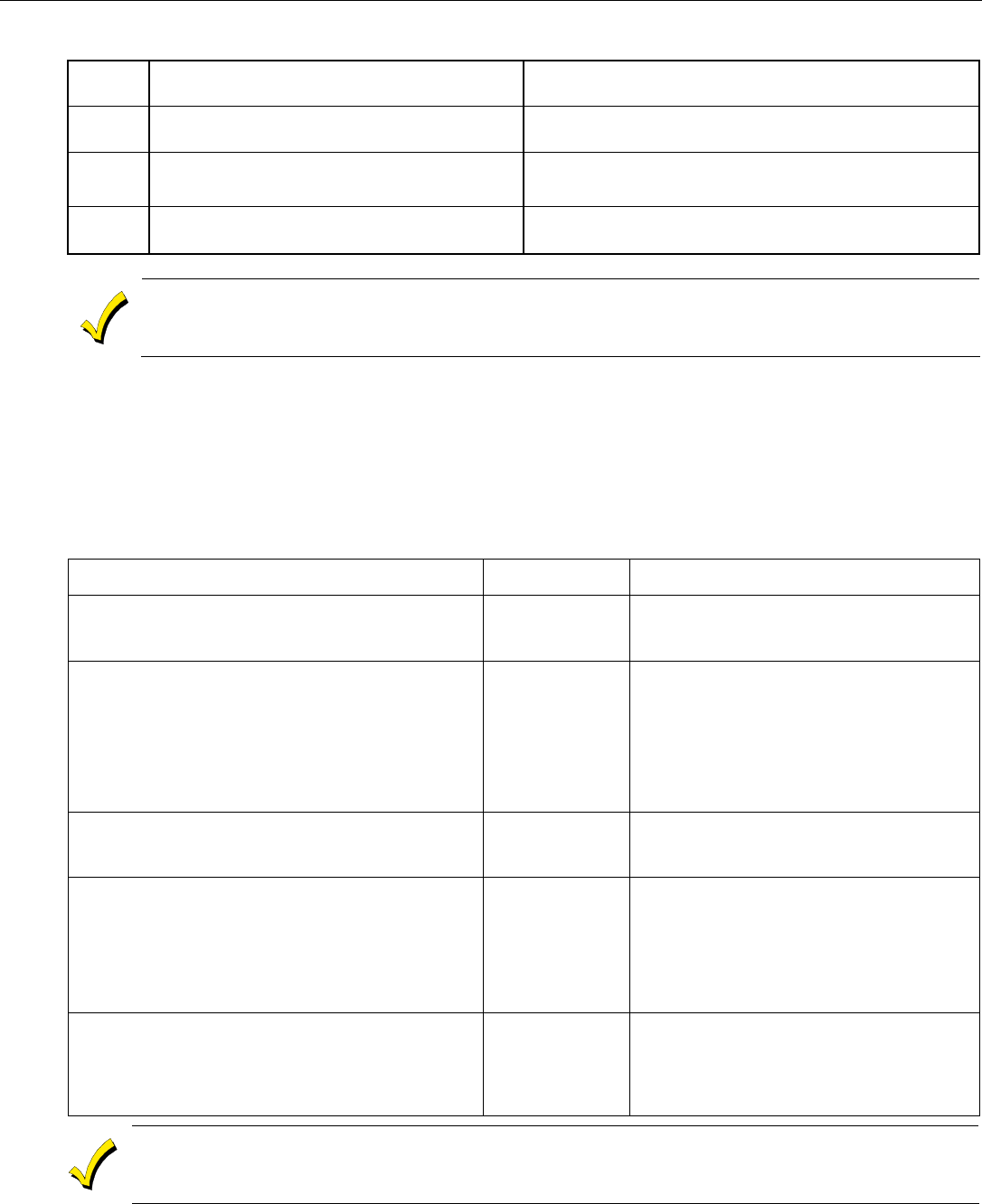
APX32EN Installation and Setup Guide
- 27 -
Data Field Descriptions
✻73 AC Restore Report Code
(See notes above)
Sent when AC power has been restored after an AC power
outage.
✻74 Low Battery Restore Report Code
(See notes above)
Sent when a system low battery condition is restored to normal.
✻75 RF Transmitter Low Battery Restore
Code (See notes above)
Sent when a transmitter that previously sent in a “low battery”
message has sent a message indicating it no longer has a low
battery condition.
✻76 Test Restore Report Code
(See notes above)
Sent when the test mode is exited. A restore code entered here
will cause a restore message to be sent when Test mode is exited.
To ensure that the APX32EN properly transmits its reports to the Central Station via the proper channel you must program
a Primary Phone Number in Field *41 and/or activate/deactivate the LRR/IP Communications Module in Field *55.
The 15-Second Dialer Delay (Burglary), programmed in Field in *50 is independent of the delay selected in Field *77 and
applies to both telephone and communications device.
DYNAMIC SIGNALING DELAY/DYNAMIC SIGNALING PRIORITY FIELD ✻77
Two report channels are used by the APX32EN to support the LRR/IP communications device and dynamic
signaling. For the primary channel the device can communicate via AlarmNet GSM/IP or Cellular
communications devices. Secondary phone is not affected by dynamic signaling scheme. Two programming
options are used to define dynamic signaling behavior. Field *55 is used to enable/disable the LRR/IP
communications device and allows it to supervise the communications module. The two-digit option
programmed in Field *77 defines how dynamic signaling will function. The Dynamic signaling options are
shown as follows:
Reporting Option Enable/Disable
Device (Field *55)
Dynamic Signaling Delay/Dynamic Signaling
(Field *77)
Primary Phone only
Report is sent to Primary phone with No Dynamic Signaling
Delay
0 = Telco Line only
(no Radio)
1st Entry
* = enter a delay for the first entry
2nd Entry
0 = Primary phone only
LRR/IP only
Report sent to communications device with No Delay
3 = LRR/IP (Digital
Communication
only) (no Telco
Line) OR
5 = LRR/IP (Digital
Communication
w/Voice
Capabilities) (no
Tel co Li ne)
1st Entry
* = enter any non zero digit as a first entry
2nd Entry
2 = LRR/IP reporting only
Redundant reports to both channels
Report independently goes to the Primary phone and LRR/IP
communications device with No Delay
1 = LRR/IP (Digital
Communication
only) and Telco
Line
1st Entry
0 = Redundant reporting on dialer and comm. device
2nd Entry
* = enter any number as a second entry
Primary Phone is the preferred channel
First report is sent to the primary phone. If primary phone fails to
deliver report within the delay window defined in *77 all following
reports go to both primary phone and communications device
with no delay. When report goes through the primary phone,
APX32EN stops reporting to communications device.
Note: The delay must be set to at least 30 seconds if Remote
Phone Control and/or AAV is enabled.
1 = LRR/IP (Digital
Communication
only) and Telco
Line OR
7 = LRR/IP (Digital
Communication
with AAV) and
Te l c o L i n e
1st Entry
* = enter a delay for the first entry
2nd Entry
0 = Primary Dialer is the preferred channel
LRR/IP is the preferred channel
First report is sent to the communications device. If device fails to
deliver report within to deliver report within the time window
defined in *77 all following reports go to both LRR/IP device and
primary phone with no delay. When report goes through the
LRR/IP device APX32EN stops reporting to primary phone.
1 = LRR/IP (Digital
Communication
only) and Telco
Line
1st Entry
* = Enter any delay for the first entry
2nd Entry
1 = LRR/IP is the preferred channel
1. If the LRR/IP communications device is selected as the preferred channel option and the APX32EN detects a communication
failure or supervision failure, reports will be sent to the Primary Phone without any delay.
2. If AAV is selected and LRR/IP communications device is enabled, you must enter "0" (primary dialer preferred channel) as
the second entry in Field *77.

APX32EN Installation and Setup Guide
- 28 -
Data Field Descriptions
✻77 Dynamic Signaling Delay/ Dynamic
Signaling Priority
1st Entry (delay before switching Central Station
reporting path)
0 = Redundant reporting
on dialer and LRR/IP
communications
device
7 = 105 seconds
8 = 120 seconds
9 = 135 seconds
#10 = 150 seconds
1 = 15 seconds #11 = 165 seconds
2 = 30 seconds #12 = 180 seconds
3 = 45 seconds #13 = 195 seconds
4 = 60 seconds #14 = 210 seconds
5 = 75 seconds #15 = 225 seconds
6 = 90 seconds
2nd Entry
0 = Primary Dialer Preferred Channel
1 = LRR/IP Preferred Channel
2 = LRR/IP reporting only
Intended for use with LRR/IP communication device reporting.
This field’s 1st Entry allows you select the time-out period the
panel will wait for acknowledgment from the first reporting
destination (preferred channel) before it attempts to send a
message to the second destination. This delay is per message.
The 2nd entry allows you to select the (Dynamic Signaling
Priority) preferred reporting channel.
Notes: (1) You must also enable/disable LRR/IP Device in field *55.
(2) If Remote Phone Access is enabled, and Primary Phone is
used as a Preferred Channel, Dynamic Signaling Delay
should be at least 30 sec in order to prevent duplicate
reports.
(3) For UL installations Dynamic Signaling Delay cannot exceed
15 sec. If Primary Phone is used as a Preferred Channel,
duplicate reports may sent.
1st Entry
Enables Dynamic Signaling Delay. The entry of digits 1-9 or #10-
#15. Delays can be selected from 0 to 225 seconds, in 15-second
increments. If 0 is entered, the control panel will send redundant
reports to both Primary Dialer and the LRR/IP communications
device.
2nd Entry
The second entry determines the alternate Central Station com-
munication path that will be initiated after the time-out period.
✻78 Programmable Tone Generation Time
0 = Disabled
1-9 = 100-900 ms
10-99 = 1.0 – 9.9 secs.
This field is used to set the time delay between when a
connection is established on a Radio (digital communication with
voice capabilities) session to when the 2100 Hz “training” tone is
terminated. Enter any digit between 0 and 99.
Note: This field only applies when a GSMV radio is installed in the
APX32EN. Otherwise, enter “0” to disable.
✻86 Multi-mode (E-mail notification)
0 = Disable multimode devices
1 = Enable multimode device address #6 only
2 = Enable multimode device address #7 only
3 = Enable multimode addresses #6 & #7
Enable if using AlarmNet Remote Services e-mail notification
(multi-mode) feature. The address(es) used must also be enabled
in the AlarmNet communication device. For more information
refer to the instructions provided with the Communications
Device being installed.
✻87 AUX Function/1-Button Paging
0 = Aux key performs defined function (macro)
1 = Aux key sends predefined message to pager or a
voice message to Follow Me system phone number
If “0” is entered, user can define a macro function for the AUX
key. See user manual for description of the use of this key.
If “1” is entered, you must also select an option in field ✻49. The
options are 6-9 for the pager or 10-13 for the follow me system
announcement. The actual pager message is 999-9999. Note that
the hyphen may not be displayed, depending on the pager
service. The manual follow me system announcement is a
repeatable “System, System…..”.
Note: A macro cannot be run from the Test mode.
✻88 Pager Characters
Enter up to 16 digits that will appear in front of the 7-
digit pager message.
Enter [#] + [11] for “*”
Enter [#] + [12] for “#”
Enter [#] + [13] for 2-second pause
Note: Verify that the pager supports [*] and [#]
characters before using them. Some pagers
require an additional delay [pause] in order to
receive the entire message.
If entered, these digits will appear in front of the 7-digit pager
message sent by the control (either upon a system event or upon
pressing the AUX key [if programmed for paging]), and during
latch key report (if enabled during scheduling). These digits can
consist of a PIN number, account number, pauses or special
digits needed by the pager (these types of characters are not
displayed), or any other characters the user chooses that will be
displayed (e.g., using a character code to distinguish between
control panel messages and other pager messages).
You do not need to fill all 16 digits. Press [✻] + next field number
to exit the field. To clear the field, press ✻88✻.
See field ✻87 to select the AUX key Paging feature. See field
✻49, which must have an option 6-9 selected to enable paging
messages, for description of the pager message.
✻89 Event Log 80% Full Report Code
(See notes above)
If an Event Logging selection is made in field ✻90, a message
can be sent to the central station receiver when the log is 80%
full. If the log becomes full, a new message will overwrite the
oldest message in the log.
Note: All control and readout from the log, aside from the selection
made by the installer in field ✻90, is accomplished via the
downloader.

APX32EN Installation and Setup Guide
- 29 -
Data Field Descriptions
✻90 Event Logging Options
0 = No event logging
1 = log Alarm/Alarm Restore
2 = log Trouble/Trouble Restore
4 = log Bypass/Bypass Restore
8 = log Open/Close
x = log combination of events (add value of entries)
Example: To select “Alarm/Alarm Restore” and “Open/Close,”
enter 9 (1 + 8); to select all events, enter #15.
Default “3” = alarm/alarm restore (1) plus trouble/trouble restore
(2).
The system has the ability to record various events in a history
log (84-event capacity). The types of events to be logged can be
selected as indicated. At any time, the downloader operator can
then upload the log and view or print out all or selected
categories of the log. The log can also be cleared by the download
operator.
The display/printout at the central station will show the date,
time, event, and description of the occurrences.
Note: System messages are logged when any non-zero selection is
made.
✻91 Audio Alarm Verification (AAV)/Remote
Phone Control
0 = none
1 = AAV and remote phone control
2 = remote phone control only
4 = AAV only
Notes:(1) For UL installations Audio Alarm Verification
cannot be used. Audio Alarm Verification will
only function when Contact ID® is selected.
(2) AAV and Remote Phone Control features can
only be used if the central station or remote
phone supports DTMF commands.
This option is used to enable the Audio Alarm Verification and/or
the Remote Phone Control features.
Notes: (1) In order to activate the Remote Phone Control feature and
defeat an answering machine, ensure that the correct ring
detection count (“15”) has been programmed in field ✻95.
(2) Remote phone session will be terminated if a report must be
sent.
(3) Alarm Audio Verification will only function when Contact ID®
is selected. AAV cannot be used for UL installations.
(4) If an alarm will be reported to primary and secondary phone
numbers, AAV can only function via the secondary number.
(5) If an alarm will be reported to a pager (6-8 in field ✻49), or
to follow me phone number (10-12 in field ✻49) AAV cannot
be used.
(6) If AAV is selected and LRR/IP communications device is
enabled, you must enter "0" (primary dialer preferred
channel) as the second entry in Field *77.
✻92 Number of Reports In Armed Period
0 = reports limited to a total of 10
1 = unlimited number of reports
This option can be used to limit the number of messages (alarm
& alarm restore reports) sent to the central station in an armed
period.
UL installations: must be 1 (unlimited reports)
✻93 Flexible Callback
0 = no flexible callback
1 = last digit flexible
2 = last 2 digits flexible
3 = last 3 digits flexible
Note: This feature only applies to telephone downloading
If enabled, the control will ignore the last 1, 2, or 3 digits of the
programmed callback number (field ✻94) during a single
download session. This allows the download operator to
temporarily change the callback phone number by the number of
digits selected, which allows the control to call back similar, but
different numbers during a single session. For example, if
downloading to a large number of controls, the operator can
command the controls to call back phone numbers 555-1111, 555-
1112, 555-1113, etc., thus spreading the communications among
several computers.
DOWNLOAD INFORMATION (✻94, ✻95)
✻94 Download Call Back Phone Number
Enter up to 20 digits as follows: 0–9, # +11 for “*”, #
+ 12 for “#”, # + 13 for a pause.
This is the phone number the control will use to call back the
downloading computer. Do not fill unused spaces. End field by
pressing ✻. To clear entries from field, press ✻94✻.
✻95 Ring Detection Count For Downloading/
Remote Phone Control
0 = disable station initiated download and remote
phone
1-14 = number of rings before control picks up phone
line
15 = defeat answering machine
Enter “15” to select defeat answering machine mode. If an
answering machine is on the premises, you need to dial the
premises and hang up on the first ring. Wait at least five (5)
seconds (but no more than 22 seconds) and dial the premises
phone number again. The control will pick up and announce
“SYSTEM ENTER CODE” every three seconds.
Note: To enter a number higher than 9 you must first press the [#] key.

APX32EN Installation and Setup Guide
- 30 -
Data Field Descriptions
OTHER PROGRAMMING COMMANDS
✻56 ENHANCED ZONE PROGRAMMING MODE
Interactive menu mode used for programming zone attributes and report codes. Refer to the ✻56
Enhanced Zone Programming Mode section for procedure.
✻80 DEVICE PROGRAMMING MENU MODE
Interactive menu mode for programming Powerline Carrier Devices. Refer to the ✻80 Device
Programming Menu Mode section for detailed procedure.
✻81 ZONE LISTS MENU MODE
Interactive menu mode for programming zone lists for Powerline Carrier Devices. Refer to the ✻81
Zone List Menu Mode section for detailed procedure.
✻83 ENHANCED SEQUENTIAL MODE
Interactive menu mode used to enter RF transmitter serial numbers. Refer to the ✻83 Enhanced
Sequential Mode section for detailed procedure.
✻84 ASSIGN ZONE VOICE DESCRIPTORS
Interactive menu mode used to assign descriptors to each zone. These descriptors will be announced
whenever the system announces an event involving a zone.
✻85 RECORD CUSTOM VOICE DESCRIPTORS
Interactive menu mode used to record custom descriptors for use with each zone.
✻96 INITIALIZE DOWNLOAD ID AND SUBSCRIBER ACCT. NO. FOR DOWNLOADING
Pressing
✻96 initializes the system for downloading.
✻97 SET ALL PROGRAM FIELDS TO 1 OF 4 SETS OF DEFAULT VALUES
See Default Tables at the end of this manual.
✻98 EXITS PROGRAMMING MODE
Prevents re-entry by: Installer Code + 8 + 0 + 0; allows re-entry only by Power-up, then [✻] and [#].
✻99 EXITS PROGRAMMING MODE
Allows re-entry to program mode by: Installer Code + 8 + 0 + 0; or by Power-up, then [✻] and [#].
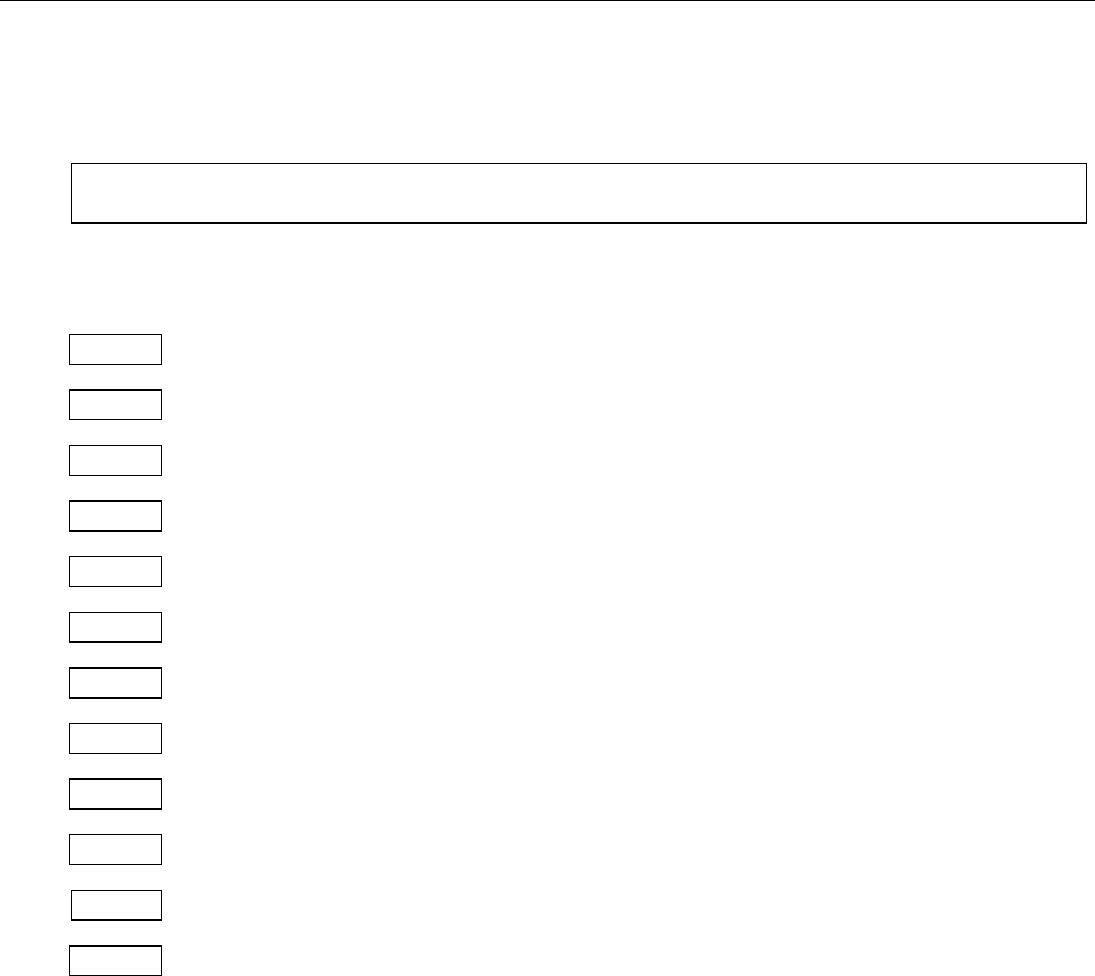
APX32EN Installation and Setup Guide
- 31 -
✻56 Enhanced Zone Programming Mode
This is an interactive menu mode that is used to program zone numbers, zone types, alarm and report codes,
and to identify the type of loop input device. This mode can also be used for entering 5800 Series transmitter
serial numbers.
Note: There are two methods for entering transmitter serial numbers. The first method is by using ✻56 Enhanced Zone Programming mode
(described below). The second method is by using ✻83 Enhanced Sequential Mode. Note that the ✻83 Enhanced Sequential Mode
requires that all zone information first be entered using ✻56 Enhanced Zone Programming mode.
You must refer to these instructions or to the Program Form while programming the system because the
keypad display does not show prompt titles. Instead, prompts are indicated by a number/letter combination.
The prompts for ✻56 are as follows:
A 02 Zone Number----------------------- for entering the zone number
b Zone Type ------------------------- for entering zone type
C Report Code------------------------- for entering the zone’s report code
d Input Type ------------------------- for entering the transmitter’s input type
E Loop Number----------------------- for entering the transmitter loop number
F Delete Serial Number? ---------- for deleting existing serial number
1A Enroll Mode? ----------------------- selects serial number enroll mode
1b Serial Number --------------------- for entering transmitter’s serial number
1C Voice Descriptor?------------------ selects voice descriptor mode
1d Descriptor 1------------------------- for entering first descriptor word
1E Descriptor 2------------------------- for entering second descriptor word
1F Descriptor 3------------------------- for entering third descriptor word
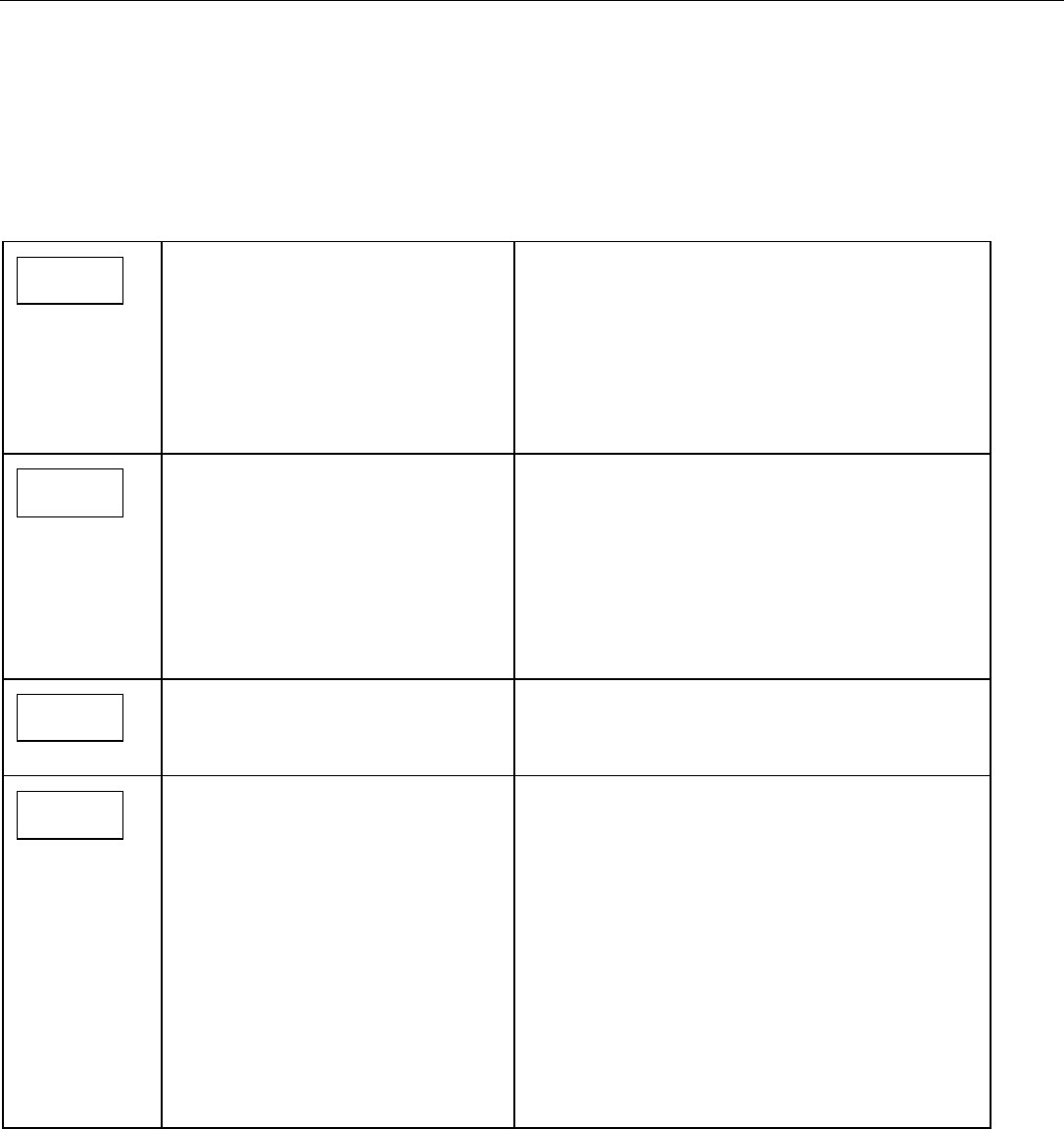
APX32EN Installation and Setup Guide
- 32 -
✻56 Enhanced Zone Programming Mode
While in Program mode, press ✻56 to enter Zone Programming Menu Mode.
Refer to the zone assignment table for ✻56 on the separate programming form.
The following explains the ✻56 prompts in detail. The left two columns identify the prompts and list the
available entries for each. The right-most column provides a further explanation of the entries.
Note: You may find it convenient to adjust the volume setting before entering the Programming Mode. This will allow you to
clearly hear feedback announcements or system beeps.
A 02
Zone number
02-41, 95, 96, 99 = Zone number
[✻] = continue
00 = exit Zone Programming mode
Enter the 2-digit zone number to be programmed and the Voice
Descriptor for the selected zone number will be announced, if it
is programmed. Press [✻] to advance.
• Zones 02-25 = RF zones (only)
• Zones 26-41 = Button zones (only)
• Zone 92 = Duress
• Zones 95, 96, 99 = Panic zones
Pressing 00 exits mode, upon which the prompt “56” blinks,
indicating the mode is inactive. Press [✻] + any field number
to go to that field.
b zt
Zone type
00-24 = zone type
[✻] = continue
[#] = return to previous prompt
Note: If 00 is accepted as a zone type, save the
00 zone type and advance to the confirm
delete prompt (F).
Each zone must be assigned to a zone type, which defines the
way in which the system responds to faults in that zone. Enter
the 2-digit zone type for this zone as follows:
00 = Not Used 09 = Fire without verification
01 = Entry/Exit #1 10 = Interior w/Delay
02 = Entry/Exit #2 14 = Carbon Monoxide
03 = Perimeter 20 = Arm–Stay
04 = Interior Follower 21 = Arm–Away
05 = Trouble Day/Alarm Night 22 = Disarm
06 = 24 Hr Silent 23 = No Alarm Response
07 = 24 Hr Audible 24 = Silent Burglary
08 = 24 Hr Aux
C rc
Report code
Enter the report code for this zone.
[✻] = continue
[#] = return to previous prompt
The report code consists of 2 hexadecimal digits, each in turn
consisting of 2 numerical digits. For example, for a report code
of "3C", enter [0][3] for "3" and [1][2] for "C".
If this is Zone 95, 96 or 99, the system skips to the VOICE
DESCRIPTOR prompt (1C).
d i
Input type
3 =RF (supervised RF) – sends periodic
check-in signals, faults, restore and low
battery signals
Note: RF type transmitters must remain within
range of the receiver, otherwise a
supervision failure signal will occur.
4 = UR (unsupervised RF) – sends same as
“RF” type, but control does not supervise
the check-in signals
5 = BR (button type) – sends only fault and low
battery signals; does not send restores or
check-in signals
Note UR and BR type transmitters may be
carried off premises (out of range without
causing a supervision failure.
[✻] = continue
[#] = return to previous prompt
Enter the input type for the transmitter assigned to this zone.
Refer to the transmitter’s instructions for input types of each
transmitter.
Note: Zones 2-25 should be assigned Input Type 3 or 4 . Zones 26-
41 should be assigned Input Type 5 only.
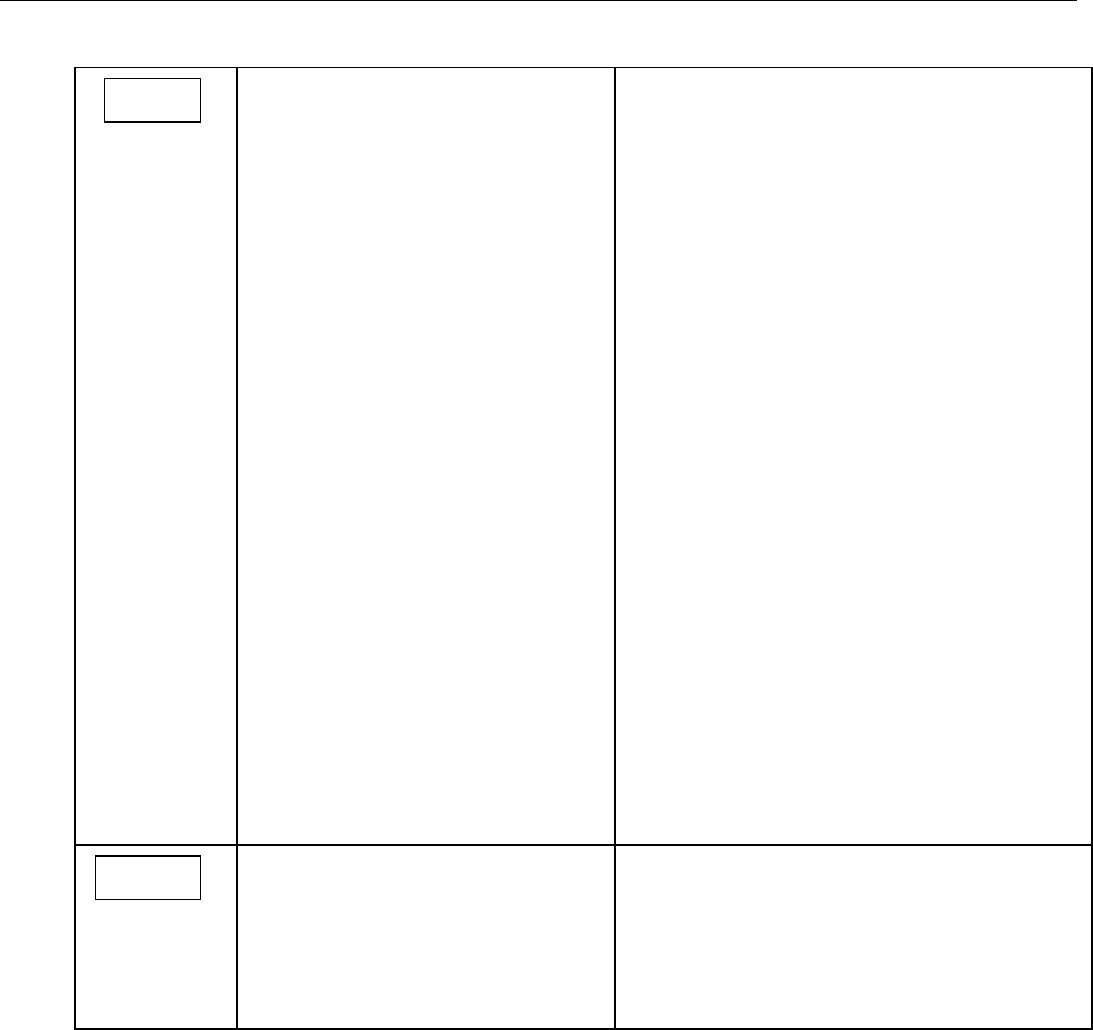
APX32EN Installation and Setup Guide
- 33 -
✻56 Enhanced Zone Programming Mode
E l
Loop number or Loop and Serial
number (if using RF Learning)
1-4 = loop number for the zone of the transmitter
being entered.
0 + [✻] = continue to DELETE ZONE
PARAMETERS CONFIRMATION prompt
(F)
[✻] = continue to the ENROLL MODE prompt
(1A) if not entered, or VOICE DESCRIPTOR
prompt if already entered
[#] = return to previous prompt
This prompt can be used to enroll loop number and serial
number via RF transmission or the loop number can be
enrolled manually. If using the RF Learning Mode, there is
no need to manually enter a loop number. Proceed directly to
RF Learning
Notes: (1) BR type devices cannot be enrolled by using UR or RF
type. Likewise, UR or RF type devices cannot be
enrolled by using a BR type device. There is a 52-
second time-out for RF enrolling. At the end of the time-
out, the system returns to the INPUT TYPE prompt (d). If
enrolled, loop number and “L” are displayed.
(2) Once encrypted (high-security) devices have been
enrolled they must be activated. Refer to the device’s
Installation Instructions to activate the High-Security
Mode. RF Learning - Two (2) transmissions (2 key
depressions) at least 5 seconds apart will be required
for BR type devices (device type 5). Two beeps will
sound after the second transmission, confirming that
the loop number and serial number have been learned.
For all other device types, four (4) transmissions are required
(fault, restore and fault, restore). A single beep will sound
after the second transmission confirming that the loop and
serial number have been captured. Following the fourth
transmission the system will confirm that the loop number
and serial number have been learned and announce the
Voice Descriptor for the zone, if it is programmed, followed
by two beeps.
Press [✻] to continue.
Manual Entry - Enter the desired loop number and press
[✻] to continue (see the transmitter’s Installation
Instructions for specific loop designations).
Note: The loop number can be changed even if the zone has
already been entered. Care should be taken when using this
feature as it has the capability to make zones inoperable by
creating a mismatch of a working serial number/loop number
combination. This should be re-confirmed if the loop number
is changed.
“L” indicates that the zone’s serial number has already been
enrolled.
F
Delete zone parameters confirmation
0 = discard the delete request
1 = confirm requested delete
Note: If 00 was entered as a zone type in prompt
(b), 00 will be retained and system will
advance to prompt (1C).
This function deletes either the serial number or all zone
information that is programmed for the zone.
If “00” was entered in the zone type, the confirmation of the
delete request will delete all information associated with the
zone currently being programmed.
If “0” was entered in the loop number, the confirmation of
the delete request will delete the serial number of to the zone
currently being programmed.
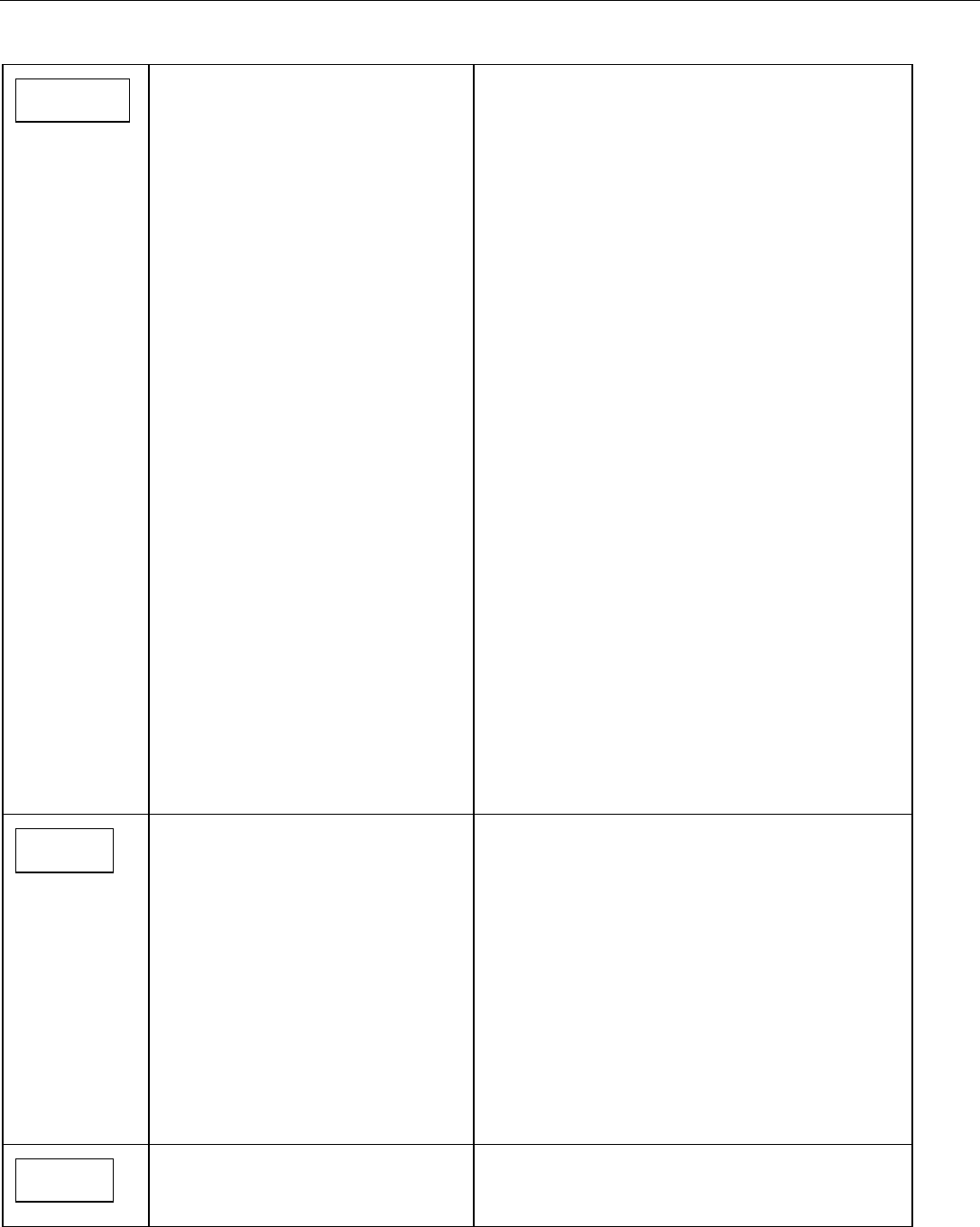
APX32EN Installation and Setup Guide
- 34 -
✻56 Enhanced Zone Programming Mode
IA LC
Enroll mode
0 = advance to the VOICE DESCRIPTOR
prompt (1C).
Note: This will save all zone parameters.
1 = enter now and proceed to SERIAL
NUMBER prompt (1b).
Note: Not applicable if the serial number is
already present.
2 = copy the last serial number entered into
local ram.
Note: If this is the 1st zone, none will be in the
buffer and the panel will emit a long tone.
Not valid if serial number is already
present.
3 = view existing serial number.
Note: Only if “L” is displayed. If “L” is not
displayed, panel will emit a long beep.
9 = advance to F; delete existing serial
number.
Note: Only if “L” is displayed. If “L” is not
displayed, panel will emit a long beep.
[✻] = advance to the VOICE DESCRIPTOR
prompt (1C). This will save all zone
parameters.
[#] = return to the LOOP NUMBER prompt (E).
Note: In order for all entered parameters to be
accepted, you must advance to the
VOICE DESCRIPTOR prompt (1C).
If “L” is displayed, the serial number for this transmitter has
already been entered. It may, however, still be viewed,
confirmed (only if in listen mode), or deleted.
View serial number
Enter “3”. Each digit will be redisplayed, and the keypad will
beep once for digits 1-6, and three times for the last digit.
Confirm serial number
The serial number/loop number combination can be confirmed
after one transmission from a BR type device or two
transmissions (fault and restore) from a UR or RF type device.
If a transmission is received that matches the serial number
and loop number entered, the system will confirm the
reception by announcing the Voice Descriptor for the zone, if it
is programmed, followed by three beeps, and a “C” will appear
on the display indicating the received serial number and loop
number have been confirmed. No further transmissions will be
received.
Delete serial number
The serial number can be deleted by entering “9”.
If “L” is not displayed, the serial number for this transmitter
has not been previously entered. You may enter the serial
number manually, copy the previous serial number, return to
Prompt (E) or enter the serial number later using the ✻83
Enhanced Sequential Mode.
Manual entry
Enter "1" to advance to Serial number prompt (1b).
Copy the previous serial number
Enter “2” to copy the previous serial number entered.
Return to Prompt (E)
Enter “#” to return to Loop Number prompt (E).
Enter transmitter later
Enter “0” or “✻” if you wish to enter the transmitter later,
using the ✻83 Enhanced Sequential Mode described later in
this manual.
Notes: (1) The panel will listen only when it is in the idle loop waiting
for key entry and a serial number has been entered. If a
key is entered, the function must be completed and the
panel will listen again.
(2)A long beep indicates illegal entry or duplicate serial
number/loop entry
Ib
Serial number
Enter the transmitter’s 7-digit serial number.
[#] = return to prompt 1A and reject any serial
numbers entries that have been made.
[✻] = return to prompt 1A, (if a valid serial
number has been entered, the "L" is
displayed and the serial number will be
copied into EEROM from the last serial
entered into the buffer.)
Note: This prompt can be used only to
manually enroll a serial number. RF
enrollment will be rejected and the
current zone descriptor will be
announced, followed by a single long
beep and the system will return to
prompt (1A).
In this mode, the transmitter serial numbers can only be
entered manually.
Enter the 7-digit serial number printed on the transmitter. If
an incorrect digit is entered, press the [#] key to backup to
prompt (1A) and start over. When all 7 digits are entered,
press the [✻] key.
If 52 seconds passes and no entry has been made, the system
returns to prompt (1A).
Notes: (1) If the serial and loop number combination is already
present the keypad will emit a single long beep and the
system will return to the (1A) prompt and “L” will be
displayed.
(2) If less than 7 digits have been entered, the keypad will
emit a single long beep and return to the (1A) prompt
without displaying the “L”.
(3) If more than 7 digits have been entered, the first 6 digits
will be saved along with the last digit that was entered
(entering 123456789 yields the serial number 1234569).
IC
Voice descriptor
0 = skip to next zone (A)
1 = enter descriptor mode; existing descriptor
for this zone will be announced
Each zone can have a voice descriptor of up to 3 words that
will be announced whenever the system announces status for
that zone.

APX32EN Installation and Setup Guide
- 35 -
✻56 Enhanced Zone Programming Mode
Id vi
Descriptor 1
Enter [#] + 2-digit vocabulary index number† of
first descriptor word for this zone.
6 = accept word and advance to descriptor 2
(descriptor 2 will be announced)
8 = accept word and advance to next zone
(prompt A) – entire zone descriptor will be
announced
Press any other key to repeat the selected word.
† see ✻84 Assign Zone Voice Descriptors section for vocabulary
index
Use the [6] or [8] key to advance as described.
To change the entered index number before pressing [6] or
[8], simply press [#] + desired 2-digit vocabulary index
number.
If descriptor 1 is not desired, enter [#] + 99 (blank), then
press [8] to return to zone number prompt.
IE vi
Descriptor 2
Enter [#] + 2-digit vocabulary index number† of
second descriptor word for this zone.
6 = accept word and advance to descriptor 3
(descriptor 3 will be announced)
8 = accept word and advance to next zone
(prompt A) – entire zone descriptor will be
announced
Press any other key to repeat the selected word.
† see ✻84 Assign Zone Voice Descriptors section for vocabulary
index
Use the [6] or [8] key to advance as described.
To change the entered index number before pressing [6] or
[8], simply press [#] + desired 2-digit vocabulary index
number.
If descriptor 2 is not desired, enter [#] + 99 (blank), then
press [8] to return to zone number prompt.
IF vi
Descriptor 3
Enter [#] + 2-digit vocabulary index number† of
third descriptor word for this zone.
6 or 8 = accept word and advance to next zone
(prompt A) – entire zone descriptor will
be announced
Press any other key to repeat the selected word.
† see ✻84 Assign Zone Voice Descriptors section for vocabulary
index
Use the [6] or [8] key to advance as described.
To change the entered index number before pressing [6] or
[8], simply press [#] + desired 2-digit vocabulary index
number.
If descriptor 3 is not desired, enter [#] + 99 (blank), then
press [8] to return to zone number prompt.

APX32EN Installation and Setup Guide
- 36 -
✻80 Device Programming Menu Mode
Powerline Carrier devices are programmable switches that can be used to perform many different functions.
They can be used to turn lights on and off, control sounders, or for status indications. In this system, each
device must be programmed as to how to act (ACTION), when to activate (START), and when to deactivate
(STOP). Each of these is described below.
The control supports a total of 8 output devices.
The K10145X10 transformer sends signals from the control panel through the premises AC wiring to the
Powerline Carrier Devices (which are plugged into AC outlets). Devices plugged into Powerline Carrier
Devices can then be made to perform various functions in response to commands entered at the keypads in
the security system.
This mode is also used to program Remote Services Multi-mode (e-mail) event triggers.
UL Powerline Carrier Devices have not been evaluated by UL.
Programming Options Defined
The following will help you understand the programming of output devices when using ✻80 and ✻81 modes.
ACTION The "ACTION" of the device is how the device will respond when it is activated by the
"START" programming. There are four different choices of actions:
• ACTIVATE for 2 SECONDS and then reset.
• ACTIVATE and REMAIN ACTIVATED until stopped by some other event.
• PULSE ON and OFF until stopped by some other event.
• NOT USED when the device is not used.
START The "START" programming determines when and under what conditions the device will
be activated. The following START options are available:
Start by Event
1. Event is the condition (alarm, fault, trouble) that must occur to a zone or group of
zones (zone list) in order to activate the device. These conditions apply only when a
zone list is used. The different choices for "EVENT" are listed below and in the
“Programming Powerline Carrier Devices” paragraph that follows.
• ALARM Device activates upon any alarm in an assigned zone in the zone list.
• FAULT Device activates upon any opening or short in an assigned zone in the zone list.
• TROUBLE Device activates upon any trouble condition in an assigned zone in the zone list.
• NOT USED Device action is not dependent upon one of the above events.
2. A zone list is a group of zones to which the “EVENT” applies in order to activate a
particular device. Note that there are a total of 3 output device-related zone lists
that can be programmed in ✻81 menu mode; when the selected EVENT (alarm,
fault or trouble) occurs in any zone in the selected “Start” ZONE LIST (1, 2, or 3),
activation of the selected device will START.
Start by Zone Type or System Operation
• If a system operation, such as “DISARMING” or “ANY FIRE ALARM,” is to
activate the device, the appropriate choice would also be entered under the
“ZONE TYPE” option. “ZONE TYPE” is used independently of the
“EVENT/ZONE LIST” combination.
• If a "ZONE TYPE" is chosen, any zone of that response type going into alarm,
trouble, or fault will cause the device to activate as selected in "ACTION.” If the
same “ZONE TYPE” is also chosen for the STOP programming, any zone of that
type that restores will de-activate the device.
• If a "SYSTEM OPERATION" is chosen (e.g., End of Exit Time), that operation
will cause the device to activate as selected in "ACTION.” The different choices
for "ZONE TYPE" and "SYSTEM OPERATION" are listed in the “Start zone
type” paragraphs later in this section, and in the Programming Form.

APX32EN Installation and Setup Guide
- 37 -
✻80 Device Programming Menu Mode
STOP The "STOP" programming determines when and under what conditions the device will be de-
activated. The following options are available:
Upon Restore of a Zone List
Restore Zone List: If a "ZONE LIST" is used as the “Stop” event, the device will de-activate when all the
zones in that list restore from a previous fault, trouble, or alarm condition. This will occur regardless of
what is programmed to "START" the device; therefore, a "RESTORE ZONE LIST" would normally only be
used when a "ZONE LIST" is used to start the device.
Upon a Zone Type or System Operation
Zone Type/System Operation: Instead of using a "RESTORE ZONE LIST," a specific zone (response) type or
system operation action can be selected to de-activate the device.
• If a specific "ZONE TYPE" is chosen, any zone of that response type that restores from a previous alarm,
trouble, or fault condition will cause the device to de-activate.
• If a "SYSTEM OPERATION" is chosen, that operation will cause the device to de-activate.
During normal system operation, any devices may be manually started by keypad entry of: Code* + [#]
+ 4 + “n;” or manually stopped by keypad entry of: Code* + [#] + 7 + “n,” where “n” = the device number to
be controlled.
* Code is required for devices 7 and 8. For devices 1-6, code is not required. See User Manual for more information.
Programming Powerline Carrier Devices
While in program mode, press ✻80 to enter Output Device Menu Mode. This mode is used to
program all output devices used in the system. Refer to the output device table for ✻80 on the separate
programming form when programming output devices.
Note: The House ID of the Powerline Carrier Devices must be entered in data field ✻25.
The prompts for ✻80 are as follows:
80 Powerline Carrier Device Programming Main Menu prompt
A 01 Device Number --------- for entering the device number
b Device Action ------------ for defining the action the device will perform when active
C Start Event Type ------- for assigning the event type to start the action
d Start Zone List ---------- for assigning the zone list to start the action
E Start Zone Type--------- for assigning the zone type to start the action
F Stop Zone List ----------- for assigning the zone list to stop the action
1A Stop Zone Type---------- for assigning the zone type to stop the action
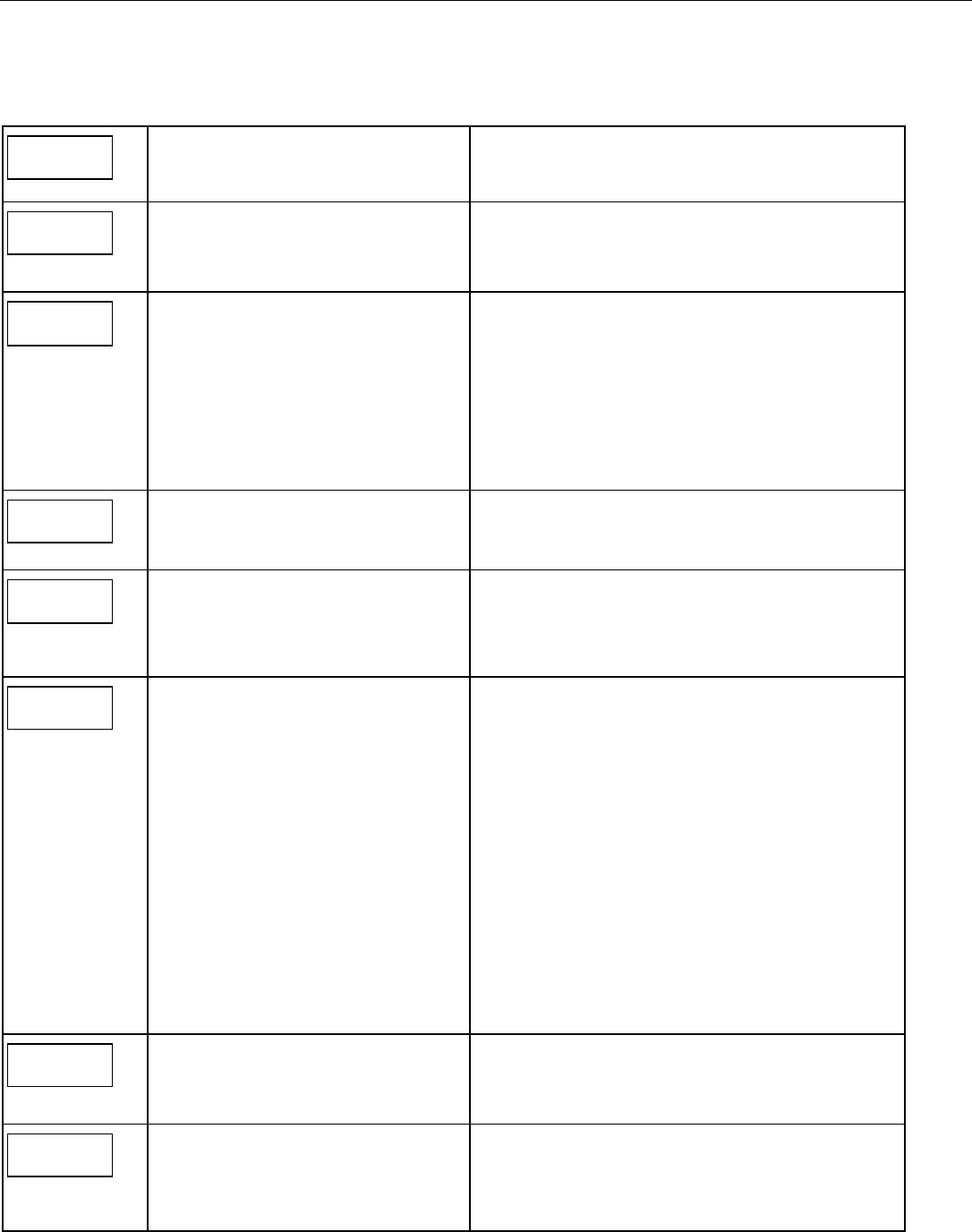
APX32EN Installation and Setup Guide
- 38 -
✻80 Device Programming Menu Mode
The following explains these prompts in detail. The left two columns identify the prompts and list the
available entries. The right-most column provides a further explanation of the entries.
Note: Entering a number other than one specified will give unpredictable results.
80
Powerline Carrier Device
programming
0 = exit mode
1 = enter mode
Entering “1” advances to the next prompt below.
Entering “0” exits mode, upon which this prompt blinks,
indicating the mode is inactive.
A 0I
Device number
01-08 = device number to be programmed
09-16 = Multi-mode (e-mail) event triggers
[✻] = continue
00 = exit Device Programming mode
Enter device numbers as 2-digit entries.
b aa
Device action
0 = No response
1 = Close for 2 seconds
2 = Close and Stay Closed
3 = Continuous Pulse on & off (1 sec ON, 1
sec OFF)
[✻] = continue
[#] = return to previous prompt
Enter the 1-digit action (0-3) for the device being programmed
(current action is displayed).
Notes:
1. If “3” is entered (pulse), only up to 3 different devices can be
pulsed if one of the devices is a siren/horn (X10 Powerhouse
Security model SH10A). In addition, the siren/horn cannot be
manually activated using the lights on/lights off keypad
commands.
2. If using an X10 Powerhouse Security SH10A siren:
• you must use device action “3.”
• you must change the device action default to “3” if using
default table 2 or 4
C et
Start event type
0 = Not used 3 = Trouble
1 = Alarm [✻] = continue
2 = Fault [#] = return to previous prompt
Enter the 1-digit event type (0-3) to activate the device being
programmed. A zone list must be used in conjunction with an
event. If a zone type/system operation is to be used instead of
an event, enter “0”.
d zl
Start zone list
1-3 = zone list number (to be programmed in
field ✻81)
0 = zone list not used for this device
[✻] = continue
[#] = return to previous prompt
If a zone list will be used to start the device action, enter the
zone list number at this prompt.
E zt
Start zone type
01-58 = zone type to start this device action
(select only those that are applicable)
00 = zone type not used for this device
[✻] = continue
[#] = return to previous prompt
If a zone type or system operation will be used to start the
device action, enter the appropriate 2-digit code for the device
being programmed (see table that follows).
Choices for zone types
00 = Not Used 07 = 24 Hr Audible
01 = Entry/Exit #1 08 = 24 Hr Aux
02 = Entry/Exit #2 09 = Fire without verification
03 = Perimeter 10 = Interior w/Delay
04 = Interior Follower 14 = Carbon Monoxide
05 = Trouble Day/Alarm Night 16 = Fire with verification
06 = 24 Hr Silent 24 = Silent Burglary
Choices for system operation
20 = Arming–Stay 38 = Chime
21 = Arming–Away 52 = Kissoff
22 = Disarm. (Code + OFF) 39 = Any Fire Alarm
31 = End of Exit Time 40 = Bypassing
32 = Start of Entry Time 42 = System Battery Low
33 = Any Alarm (except ZT 08, 09,
14 or 16)
43 = Communications Failure
36 = At Bell Timeout** 58 = Duress
** Or at Disarming (which ever occurs earlier)
SIA ZT 16 must be used in SIA fire applications.
F zl
Stop zone list
1-3 = zone list to stop this device action
0 = zone list not used
[✻] = continue
[#] = return to previous prompt
If a zone list will be used to STOP, or restore, the device
action, enter the zone list number 1, 2, or 3 (to be programmed
in ✻81 mode). If not used, enter “0”.
IA zt
Stop zone type
01-58 = zone type to start this device action
(select only those that are applicable)
00 = zone type not used for this device
[✻] = continue
[#] = return to previous prompt
If a zone type or system operation will be used to STOP the
device action, enter the appropriate 2-digit code (see the "ZT"
choices listed above). If not, enter 00.
The display then returns to the DEVICE NUMBER prompt
(A) so that you can enter the next device number to be
programmed, or enter [0][0] to end device programming.

APX32EN Installation and Setup Guide
- 39 -
✻81 Zone List Menu Mode
While in Program mode, press ✻81 to enter Zone List Menu Mode. This mode is used to program zone
lists for output devices (programmed in ✻80 menu mode) or Chime-by-Zone in Zone List 3.
NOTES:
• Any list may include any or all of the systems zone numbers.
• A zone list can be assigned to more than one Powerline Carrier Device.
The prompts for *81 are as follows:
81 Zone List Programming-------------------- Main Menu prompt
A 01 Zone List Number --------------------------- for entering the zone list number to be programmed
b Zone Entry to List --------------------------- for entering zones to the assigned zone list
C Delete Entire List? -------------------------- for deleting the entire zone list and its contents
d Delete Specific Zones From List?-------- Selects whether to delete zones or return to next zone
list number
E Delete Zones----------------------------------- for deleting specific zones from the current zone list
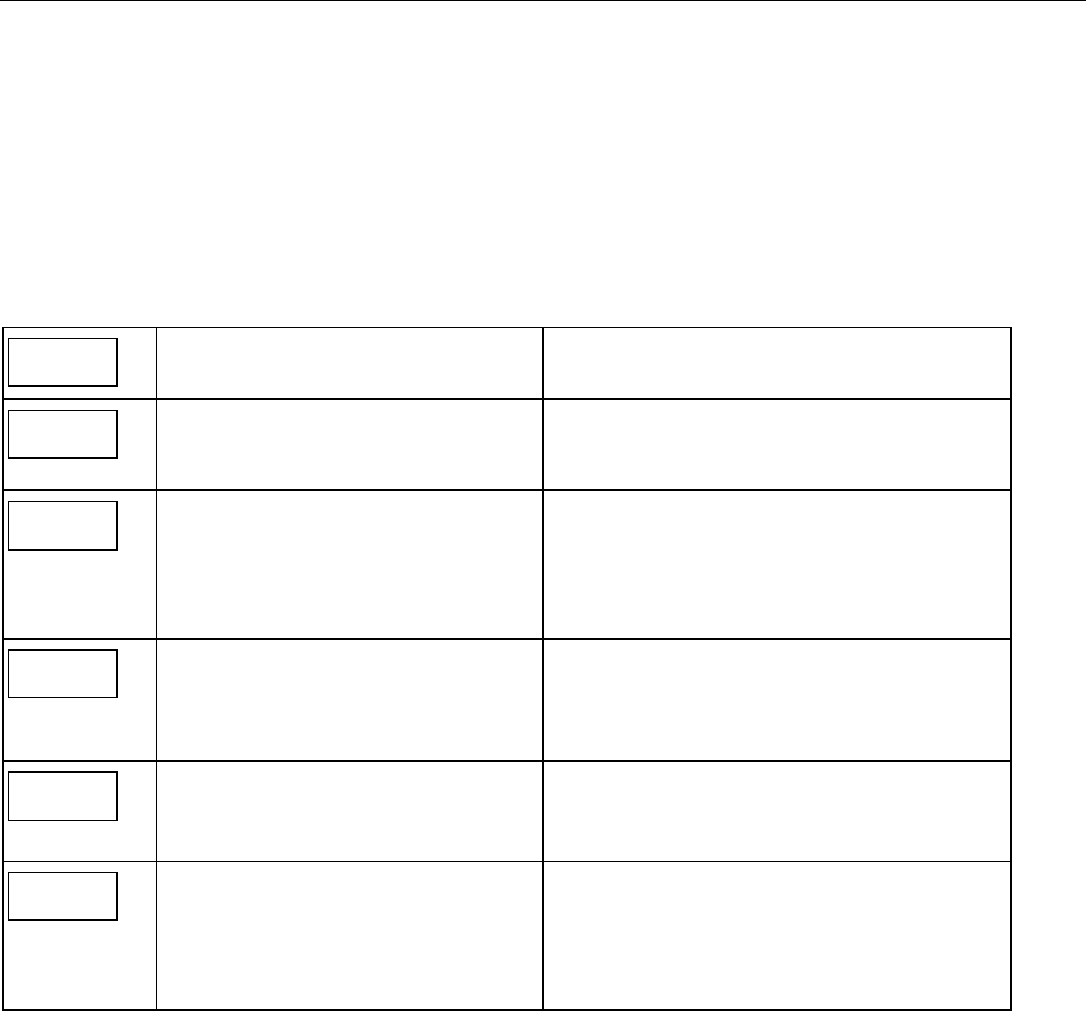
APX32EN Installation and Setup Guide
- 40 -
✻81 Zone List Menu Mode
The following explains these prompts in detail. The left two columns identify the prompts and list the
available entries. The right-most column provides a further explanation of the entries.
Notes: (1) Entering a number other than one specified will give unpredictable results.
(2) Do not assign zones with zone types 20, 21 or 22 to a zone list.
(3) Zone List 2 should be used for Cross Zoning. When creating zone list 2 for cross zoning, include only 2
zones assigned to zone types 3, 4, or 5. If interior zones (zone type 4) are cross zoned, then both
zones in zone list 2 must be interior zones. Do not cross zone more than 2 zones, or zone types that
have delays (entry/exit zones, interior w/delay), or 24-hour zones, as these choices may produce
unpredictable operation and may not function as intended. If cross zoning is used, zone list 2 should
not be used for other purposes, such as triggering powerline carrier devices. If field ✻39 has been set
to “0” (no cross zoning), then Zone List 2 can be used for other purposes.
8I
Zone list programming
0 = exit mode
1 = enter mode
Pressing 1 advances to the next prompt below.
Pressing 0 exits mode, upon which this prompt blinks,
indicating the mode is inactive.
A 0I
Zone list number
01-03 = zone list number to be programmed
00 = exit Zone List mode
[✻] = continue
Enter the Zone List Number 01, 02, or 03 to program (or 00
if no zone lists are used).
b zz
Zone entry to list
01-41, 95, 96, 99 = zone numbers to add to zone
list
[✻] = accept zone number and enter the next zone
number
00 = accept zone number(s) and continue to next
prompt
Enter each zone number to add to the zone list by first
entering the zone number, then the [✻] key (for example,
01✻ 02✻ 03✻). The system will announce the Voice
Descriptor for the selected zone, if it is programmed. After
all desired zones are enrolled, enter “00” to advance.
C
Delete entire zone list?
0 = don’t delete; continue to next prompt
1 = delete the current zone list
To delete the zone list, enter “1”. All zones in the zone list
will be deleted automatically and programming will return
to the ZONE LIST NUMBER prompt.
To save the zone list or delete specific zones from the list,
enter “0”.
d
Delete zones from list?
1 = continue to delete zones prompt
0 = don’t delete; continue to next zone list number
prompt (A….01)
[#] = return to zone list number prompt (A….01)
To save the entire zone list, enter “0” and programming will
return to the ZONE LIST NUMBER prompt.
To delete a zone or zones in a zone list enter “1”.
E
Delete zones
Enter each 2-digit zone number to be deleted from
the current zone list, followed by the [✻] key.
[✻] = delete zone and enter next zone to be
deleted
00 = delete zone and return to next zone list
number prompt (A….01) desired
When deleting a zone(s) from the zone list, if the selected
zone has a Voice Descriptor programmed, upon deletion it
will be announced as a confirmation that it has been
deleted. After all zones to be deleted are entered, enter “00”
to return to the ZONE LIST NUMBER prompt so that
another list can be programmed, if desired.

APX32EN Installation and Setup Guide
- 41 -
✻83 Enhanced Sequential Mode
By using this mode, you can add, delete, or change the serial number of a transmitter in a zone, but retain
all other existing data that has been programmed for that zone. Note that the ✻83 Enhanced Sequential
mode requires that all zone information must first be entered using the ✻56 Enhanced Zone Programming
mode for all zones below zone number 26 (4 button key area).
Note: Any zone which already has a serial number learned in will not be accessible in ✻83Enhanced Sequential mode!
Certain button-type transmitters have more than one button (e.g., 5804). Note that each button must be
assigned to a different zone. Similarly, the 5816 Transmitter has contact terminals and a reed switch for use
with a magnet. If using both, each must also be assigned to a different zone.
This means that the procedures that follow must be repeated for each button-type zone below zone number
26 or contact on the transmitter. Four zone button-type devices are held in zones 26 and above. They will be
started on boundaries of zones 26, 30, 34, and 38. These four zone button-type devices will have the option to
have all information entered in this field. One entry will set the loop number, report code, zone type, and
input device type for all 4 buttons, and a second entry will enter one serial number into four zones.
Note: Use this mode only after all other zone information has been programmed, including transmitter loop numbers except
for button-type zones over zone number 26. The panel will stop at zones 26, 30, 34 and 38 and zone data can be
entered as a default here.
Enter Serial Number Sequential mode by pressing ✻83. The prompts for ✻83 are as follows:
A 02 Zone Number----------------------- for entering the zone number to be programmed
1A Enroll Mode------------------------- Selects method of serial number or viewing
1b Enroll Serial Number------------ for entering transmitter serial numbers
F Delete Serial Number ----------- for deleting existing serial numbers
The following explains these prompts in detail. The left two columns identify the prompts and list the
available entries. The right-most column provides a further explanation of the entries.
Notes: (1) Entry of a number other than one specified will give unpredictable results.
(2) In Enhanced Sequential Mode, 4 button type keys will always be enrolled simultaneously. They will be stopped at
the 4 button boundaries of 26, 30, 34 and 38, provided the zone is free of a serial number. If the first zone of the
key has a serial number enrolled, the remaining keys cannot be programmed in sequential mode. In addition, if
the zone has not been set up (duplicate loop, missing zone type, etc.) only entries 0 (skip to the next zone) and 4
(copy the key template) will be allowed.
(3) You may find it convenient to adjust the volume setting before entering the Programming Mode. This will allow you
to clearly hear feedback announcements or system beeps.

APX32EN Installation and Setup Guide
- 42 -
✻83 Enhanced Sequential Mode
A 02
Zone number
Enter the 2-digit zone number.
[✻] = continue; system searches for zones not
yet entered (for zones 2 through 25 a zone
type must be entered), then advances to
ENROLL SERIAL NUMBER prompt “1b”
00 = exit Sequential mode
Enter the 2-digit zone number of the first transmitter to have
its serial number entered. The system will announce the Voice
Descriptor for the selected zone number, if it is programmed.
Press [✻] to continue. Starting with this zone number, the
system will search for the first transmitter that has all of the
following attributes pre-programmed in ✻56 ENHANCED
ZONE PROGRAMMING:
a) Make sure that the appropriate input type was selected
in ✻56 (RF, UR, or BR programmed)
b) Make sure that the appropriate loop number was selected
in ✻56.
c) No serial number programmed
d) Zone type
If the first zone number entered does not have one or more of
the above attributes, the system will search its database for
the first zone that does, and will display it at the enroll
SERIAL NUMBER prompt (1b).
Pressing 00 exits mode, upon which the prompt “83” blinks,
indicating the mode is inactive.
Note: Two exceptions to the requirement above exist for keys. Four
zone button type devices (zone numbers 26, 30, 34, and 38)
will be stopped only if there are no serial numbers enrolled in
all 4 zones of the key, regardless of the attributes that have
been entered. In addition, zone types are not required to be
present. In this case, 1A, Option 4 must be selected prior to
“Learn”.

APX32EN Installation and Setup Guide
- 43 -
✻83 Enhanced Sequential Mode
IA zz
IA LC
Enroll mode
0 = advance to next zone to be enrolled
1 = enter now and proceed to SERIAL NUMBER
prompt (1b).
For 4 button keys (zones 26-29, 30-33, 34-37, &
38-41) the serial number will be enrolled to all four
buttons. If enrolling a key, the panel will emit a
long beep when entering a 1 to indicate that the
present key set up is invalid.
Notes:(1) A valid template or key has 4 existing
zones, each with a zone type, unique
loop number.
(2) If the display automatically advances
to "1A" rather than "1b" the
configuration of the key is not valid.
At that point copy template, skip, or
return are the only legal entries.
2 = copy the previous serial number entry from
the buffer.
Notes:(1) Before you can copy a serial number
you must first enter a serial number.
If no serial is stored in the buffer and
a copy is attempted the panel will
emit a long beep indicating an invalid
operation.
(2) Not applicable for 4 button key zones
26-29, 30-33, 34-37, & 38-41.
3 = view existing serial number.
Note: Only if “L” is displayed. If the “L” is not
displayed the panel will emit a long beep.
4 = copy the 4 button key template that has been
set in zone numbers 26-29 (all zone
parameters except serial numbers). (Only
valid on zones 30-33, 34-37, & 38-41 that do
not have serial numbers enrolled.)
Notes:(1) Template acceptance is indicated by
two beeps after copying.
(2) A single long beep emitted when
copying a indicates the template is
not valid.
9 = delete existing serial. Go to the (1A) prompt.
For 4-button key, zones 26-29, 30-33, 34-37,
& 38-41 have serial numbers. Delete all four
at one time.
Note: Only if “L” is displayed. If the “L” is not
displayed the panel will emit a long beep.
[✻] = advance to next zone to be enrolled
[#] = return to previous prompt (A)
Note: If “L” is displayed, the serial number for this transmitter has
already been entered, however, it may still be confirmed,
viewed or deleted.
If the transmitter’s serial number has not been previously
entered, you may enter the enroll serial number mode (1A) by
entering “1”, or copy the last serial number that was entered
by entering “2”.
If the transmitter’s serial number has been previously
entered, you may, view the present serial number by entering
“3”. If view is selected each digit will be re-displayed, and the
keypad will beep once for digits 1-6, and three times for the
last digit. Once the serial number has been entered by either
selecting a “1” or a “2”, you will return to this prompt with the
“L” on the display. The serial number/loop number
combination that was entered can be confirmed by getting two
transmissions (fault and restore) from the RF or UR device or
one transmission from the BR device. If a transmission is
received that matches the serial number and loop number
entered, the system will announce the Voice Descriptor for the
loop followed by three beeps, and a “C” will be displayed
indicating that the received serial number and loop number
transmission has been confirmed to match. No further
transmissions will be received. When confirming a 4 button
key, only the serial number is confirmed, since it assumed
that all loops are used. Pressing any key will allow a
confirmation.
*Long beep indicates illegal entries, or duplicate serial
number/loop entry*
When the last zone has been entered, the display will remain
on that zone. To exit this mode and return to data field
program mode, press 00 at the ZONE NUMBER prompt.
When all zones have been programmed, test each zone using
the system’s Test mode. Do not use the Transmitter ID Sniffer
mode for this, since it will only check for transmission of one
zone on a particular transmitter, and not the zones assigned
to each additional loop.
For Zones 26-29, 30-33, 34-37, and 38-41 any loop can be used
for RF enrollment. If enrolling via RF, it will be confirmed
without additional transmissions.

APX32EN Installation and Setup Guide
- 44 -
✻83 Enhanced Sequential Mode
Ib zz
Ib
Serial number
Enter transmitter’s 7- digit serial number via RF
learning or manually.
[#] = return to (1A) prompt and reject whatever
serial number entries have been made.
[✻] = return to (1A) prompt (if a valid serial
number has been enrolled, “L” is displayed
and the serial number will be copied into
EEROM and the last serial entered buffer.
Note: For zones 26, 30, 34 and 38 only BR type
devices can be used.
This prompt can be used to enroll the transmitter serial
number via RF transmission or manually. If using the RF
Learning Mode there is no need to manually enter a serial
number. Proceed directly to RF Learning. Upon entering the
Serial Number mode, the Zone Descriptors will be
announced.
Note: BR type devices can be enrolled only by transmission from
BR devices. Likewise, UR and RF devices can only be
enrolled by transmission from a UR or RF device
RF Learning - Two (2) transmissions (2 key depressions) at
least five seconds apart, will be required for BR type or four
(4) transmissions (fault, restore and fault, restore) for UR or
RF type. If the learned serial number has a different loop
number than that entered in ✻56 the system will announce
the Voice Descriptor, if it is programmed, followed by two
beeps and will return to Prompt (1A) and “L” will be
displayed.
If the loop number captured by RF transmission and that
entered in ✻56 mode match, the system will announce the
Voice Descriptor, if it is programmed, followed by three
beeps and return to Prompt (1A) and “LC” will be displayed.
No additional transmissions are needed for confirmation.
Manual Entry - Enter the 7-digit serial number printed on
the transmitter. If you enter an incorrect digit, press the [#]
key to backup to prompt (1A) and start over. When all 7
digits are entered, press the [✻] key. If less than 7 digits are
entered, the keypad will emit a single long beep and return
to the (1A) prompt without displaying the “L”.
If more than 7 digits have been entered, the first 6 digits
will be saved along with the last digit that was entered
(entering 123456789 yields the serial number 1234569).
Note: If 52 seconds pass and no entry has been made, the
system returns to prompt (1A).
F
Delete serial number
0 = discard the delete request
1 = confirm requested delete
Note: Entering a “9” at prompt (1A) will cause
the panel to return to prompt (1A)
regardless of the confirmation answer.
This function deletes only the serial number.
Entering a “9” at prompt (1A). Confirmation of the delete
request will cause deletion of the serial number pertaining to
the zone being programmed.
Note: In Enhanced Sequential Learn Mode, 4 button type keys will always be learned simultaneously. They will be stopped at
the 4 button boundaries of 26, 30, 34 and 38, provided the zone is free of a serial number. If the first zone of the key
has a serial number learned, the remaining keys cannot be programmed in sequential learn mode. In addition, if the
zone has not been set up (duplicate loop, missing zone type, etc.) only entries 0 (skip to the next zone) and 4 (copy
the key template) will be allowed.
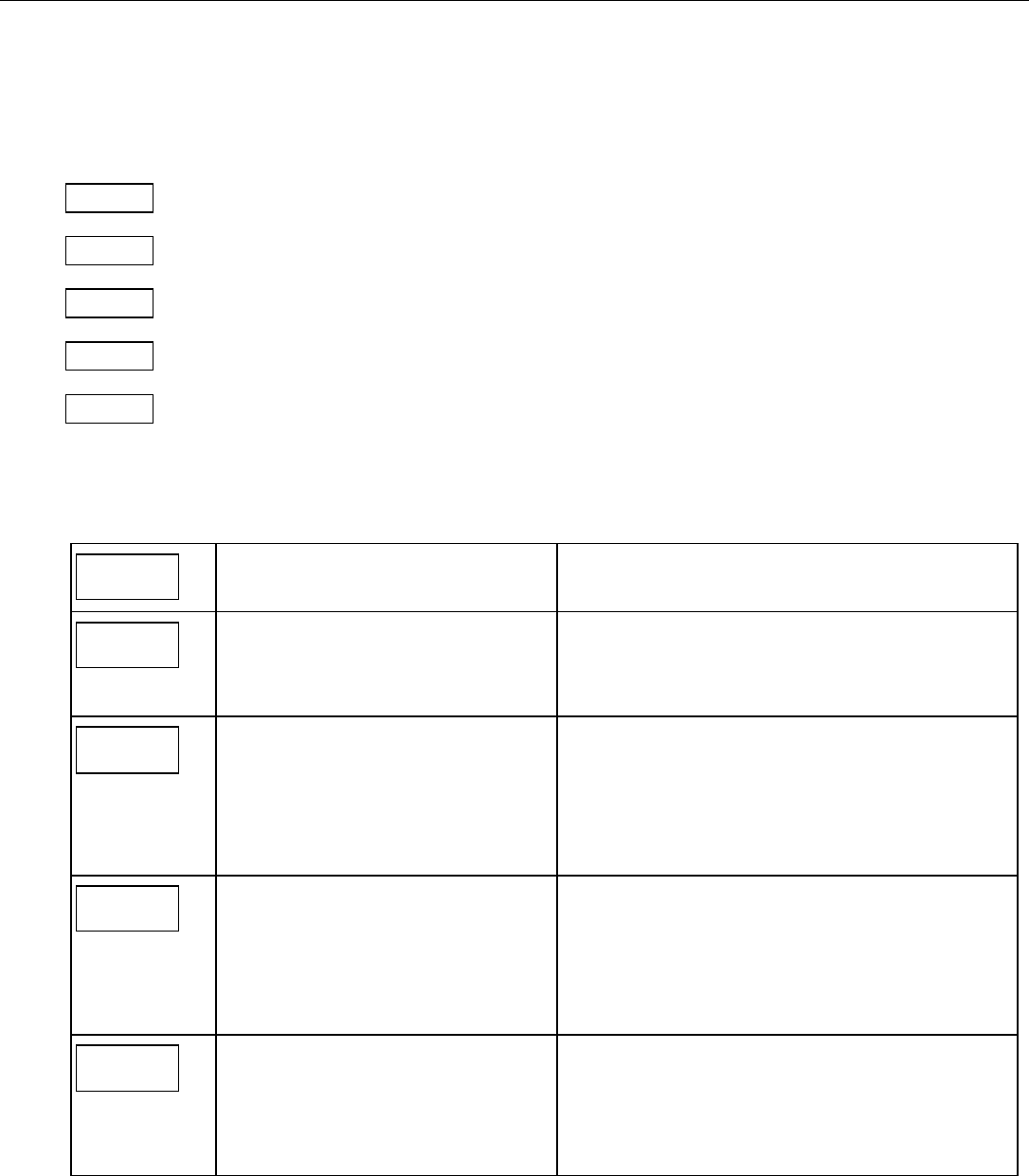
APX32EN Installation and Setup Guide
- 45 -
✻84 Assign Zone Voice Descriptors
Use this mode to assign voice descriptors for each zone. These are the descriptors that are announced
when the system announces any event involving a zone number. Each descriptor can consist of up to
3 words. Press ✻84 while in Programming mode.
The prompts for ✻84 are as follows:
84 Voice Descriptors ----------------- Main Menu prompt
A 02 Zone Number----------------------- for entering the zone number to be programmed
b Descriptor 1------------------------- for assigning the first word of this zone’s descriptor
C Descriptor 2------------------------- for assigning the second word of this zone’s descriptor
d Descriptor 3------------------------- for assigning the third word of this zone’s descriptor
The following explains these prompts in detail. The left two columns identify the prompts and list
the available entries. The right-most column provides a further explanation of the entries.
Note: Entering a number other than the one specified will give unpredictable results.
84
Assign zone voice descriptors
0 = exit mode
1 = enter mode
Pressing 1 advances to the next prompt below.
Pressing 0 exits mode, upon which this prompt blinks,
indicating the mode is inactive.
A zz
Zone number
[✻] = continue to next prompt (any existing
descriptors will be announced, then
descriptor 1 will be repeated)
00 = exit voice descriptor mode
Enter the 2-digit zone number for which this descriptor is
being assigned, then press [✻]. The Voice Descriptor for the
selected zone will be announced, if it is programmed.
b vv
Descriptor 1
Enter [#] + 2-digit vocabulary index number of
first descriptor word for this zone.
6 = accept word and advance to descriptor 2
(descriptor 2 will be announced)
8 = accept word and advance to prompt (A) for
next zone. Press any other key to repeat the
selected word.
Enter the first word of the descriptor for the selected zone.
Use the [6] or [8] key to advance as described.
To change the entered index number before pressing [6] or [8],
simply press [#] + desired 2-digit vocabulary index number.
If descriptor 1 is not desired, enter [#] + 99 (blank), then press
[8] to return to zone number prompt.
C vv
Descriptor 2
Enter [#] + 2-digit vocabulary index number of
second descriptor word for this zone.
6 = accept word and advance to descriptor 3
(descriptor 3 will be announced)
8 = accept word and advance to prompt (A) for
next zone. Press any other key to repeat the
selected word.
Enter the second word of the descriptor for the selected zone.
Use the [6] or [8] key to advance as described.
To change the entered index number before pressing [6] or [8],
simply press [#] + desired 2-digit vocabulary index number.
If descriptor 2 is not desired, enter [#] + 99 (blank), then press
[8] to return to zone number prompt.
d vv
Descriptor 3
Enter [#] + 2-digit vocabulary index number of
third descriptor word for this zone.
6 or 8 = accept word and advance to prompt
(A) for next zone. Zone descriptor will
be announced. Press any other key to
repeat the selected word.
Enter the last word of the descriptor for the selected zone.
Use the [6] or [8] key to advance as described.
To change the entered index number before pressing [6] or [8],
simply press [#] + desired 2-digit vocabulary index number.
If descriptor 3 is not desired, enter [#] + 99 (blank), then press
[8] to return to zone number prompt.

APX32EN Installation and Setup Guide
- 46 -
✻84 Assign Zone Voice Descriptor
VOICE VOCABULARY INDEX
00 ½ second pause
A
82 ALARM
32 ATTIC
B
01 BABY
33 BACK
34 BASEMENT
35 BATHROOM
36 BEDROOM
C
83 CHECK
D
37 DELAY DOOR
38 DEN
02 DETECTOR
03 DINING
39 DINING ROOM
04 DOOR
40 DOWNSTAIRS
05 DRIVEWAY
E
06 EAST
41 EIGHT
42 EMERGENCY
F
43 FAMILY ROOM
87 FIRE
44 FIRE DETECTION
07 FIRST FLOOR
45 FIVE
08 FLOOR
46 FOUR
47 FRONT
G
48 GARAGE
49 GUEST ROOM
09 GUN
H
50 HALL
I
10 INSIDE
K
51 KITCHEN
L
11 LAUNDRY
52 LAUNDRY
ROOM
12 LIBRARY
13 LIVING
53 LIVING ROOM
M
14 MAIN
15 MASTER
54 MASTER
BEDROOM
55 MEDICAL
84 MESSAGE
56 MOTION
DETECTOR
N
57 NINE
16 NORTH
58 NURSERY
O
59 OFFICE
60 ONE
17 OUTSIDE
P
61 PATIO
62 POLICE
18 POOL
R
63 REAR
19 ROOM
S
64 SECOND FLOOR
65 SEVEN
20 SHED
21 SHOP
66 SIDE
67 SILENT POLICE
68 SIX
69 SLIDING
22 SMOKE
23 SOUTH
24 STORAGE
85 SYSTEM
T
25 THIRD FLOOR
75 THREE
76 TRANSMITTER
77 TWO
U
78 UPSTAIRS
26 UTILITY
79 UTILITY ROOM
W
27 WEST
80 WINDOW
Y
28 YARD
Z
81 ZERO
86 ZONES
29 1ST
30 2ND
31 3RD
70 Custom Word #1
71 Custom Word #2
72 Custom Word #3
73 Custom Word #4
74 Custom Word #5
99 Blank (for erasing
a previously
programmed
word)
SYSTEM WORDS
AC LOSS
ARMED
AWAY
BYPASSED
CARBON MONOXIDE
CHIME
DISARMED
DISARM SYSTEM
NOW
EXIT NOW
OPEN
INSTANT
LOW BATTERY
NOT
READY TO ARM
STAY
Notes: (1) If button type device is used to Arm Away, Arm Stay, and disarm the system it is recommended to assign
“Check” and “Zones” voice descriptors to each of the three zones. This will allow the system to announce
“Check Zones” “Low Battery” if the button device has a low battery.
(2) If a Wireless Keypad is being installed along with this system, not all the voice descriptors shown on this list can
be announced by keypad. (Refer to the Wireless Keypad documentation for further information).

APX32EN Installation and Setup Guide
- 47 -
✻85 Record Custom Voice Descriptors
Use this mode to record up to 5 custom voice descriptors. Press ✻85 while in Programming mode.
Note: Entering a number other than one specified will give unpredictable results.
85
Assign custom voice descriptors
0 = exit mode
1 = enter mode
Entering “1” advances to the next prompt below.
Entering “0” exits mode, upon which this prompt blinks,
indicating the mode is inactive.
A 7d
Custom descriptor number
Enter 7 + d + [✻]
Where d = 0-4, each representing custom
word 70, 71, 72, 73, or 74, respectively. Any
existing word will be announced.
Press [#] to start recorder. Begin speaking
immediately after the third beep.
Speak the desired word clearly near the
microphone. Recording stops after 1.5
seconds.
6 = accept word and ready to record next
descriptor prompt (A….7d)
[#] = re-record descriptor
00 = exit Record mode after pressing 6 to
accept word
Press any key to repeat the recorded word.
Record up to 5 custom words.
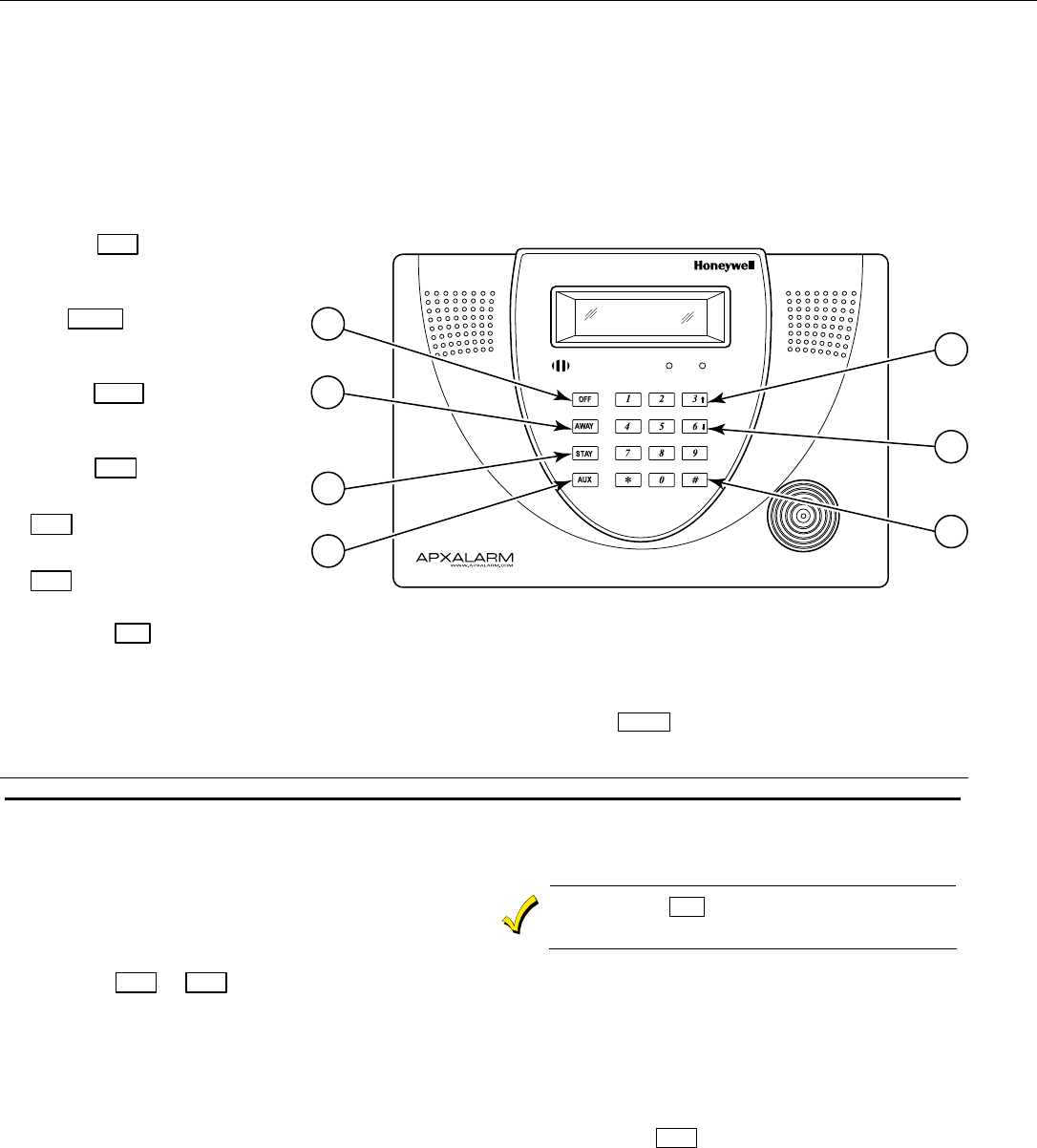
APX32EN Installation and Setup Guide
- 48 -
Voice Prompt Programming
The APX32EN features a quick programming mode that allows you to program the system by responding to
a series of voice prompts. The Voice Prompt Programming Guide provides you with the information required
to use this feature.
Voice Prompt Programming Keypad Functions:
The keys shown below are used to navigate through the Voice Prompt Programming Feature.
1. ESCAPE/ OFF key: Used at any
time to exit the current menu and
return to the previous prompt.
2. ADD/ AWAY key: Used to add
sensors, or keys or save data when
entering phone or account numbers.
3. DELETE/ STAY key: Used to delete
a sensor when in the delete Sensors
Menu.
4. SELECT/ AUX key: Used to confirm
a selection.
5. 3 ↑ key: Used to scroll forward
through menu choices.
6. 6 ↓ key: Used to scroll backward
through menu choices.
BYPASS
NO DELAY
RECORD
TEST
FUNCTION
STATUS
VOLUME PLAY
CODE
AWAY INSTANT
STAY INSTANT
ESCAPE
SELECT
ADD
DELETE CHIME
ARMED READY
09012-016-V0
5
7
4
3
1
2
6
7. FUNCTION/ # key: Used to repeat a voice prompt. (This function cannot be used while entering phone or account numbers.)
Notes: (1) Keying in any new command will terminate the active voice prompt.
(2) If an irrelevant command is entered APX32EN will generate a long rejection beep and repeat the previous voice prompt.
(3) Phone numbers and account numbers can be left blank by pressing the “ADD/ AWAY ” key without entering any data.
(4) APX32EN automatically saves phone and account number data once all available digits are entered.
ENTERING VOICE PROMPT PROGRAMMING
1. Power-up the control and enter the Installer Code
(4 1 1 2) + 8 8 8.
2. Once you have entered into the Voice Prompt Programming
Mode the system will announce, “Programming, use
ARROWS to scroll choices, press SELECT to accept, press
ESCAPE to quit.”
3. Press the 6 ↓ or 3 ↑ keys to scroll through the voice
menu and follow the instructions provided.
4. The system will announce the following options:
“Add Sensors”
“Delete Sensors”
“First Central Station Phone Number”
“First Central Station Account Number”
“Second Central Station Phone Number”
“Second Central Station Account Number”
“Templates”
“Expert Programming Mode”
5. Follow the directions provided by each voice prompt to
make your selections.
The FUNCTION/ # key can be used to repeat a voice
prompt, as required.
6. When you have completed each programming procedure
the system will return to the Main Programming Menu.
EXITING VOICE PROMPT PROGRAMMING
1. Once you have returned to the Main Programming Menu,
the system will announce, “Programming use ARROWS to
scroll choices, press SELECT to accept, press ESCAPE to
quit”.
2. Press ESCAPE/ OFF to exit Voice Prompt programming
mode once you have returned to the Main Programming
Menu.
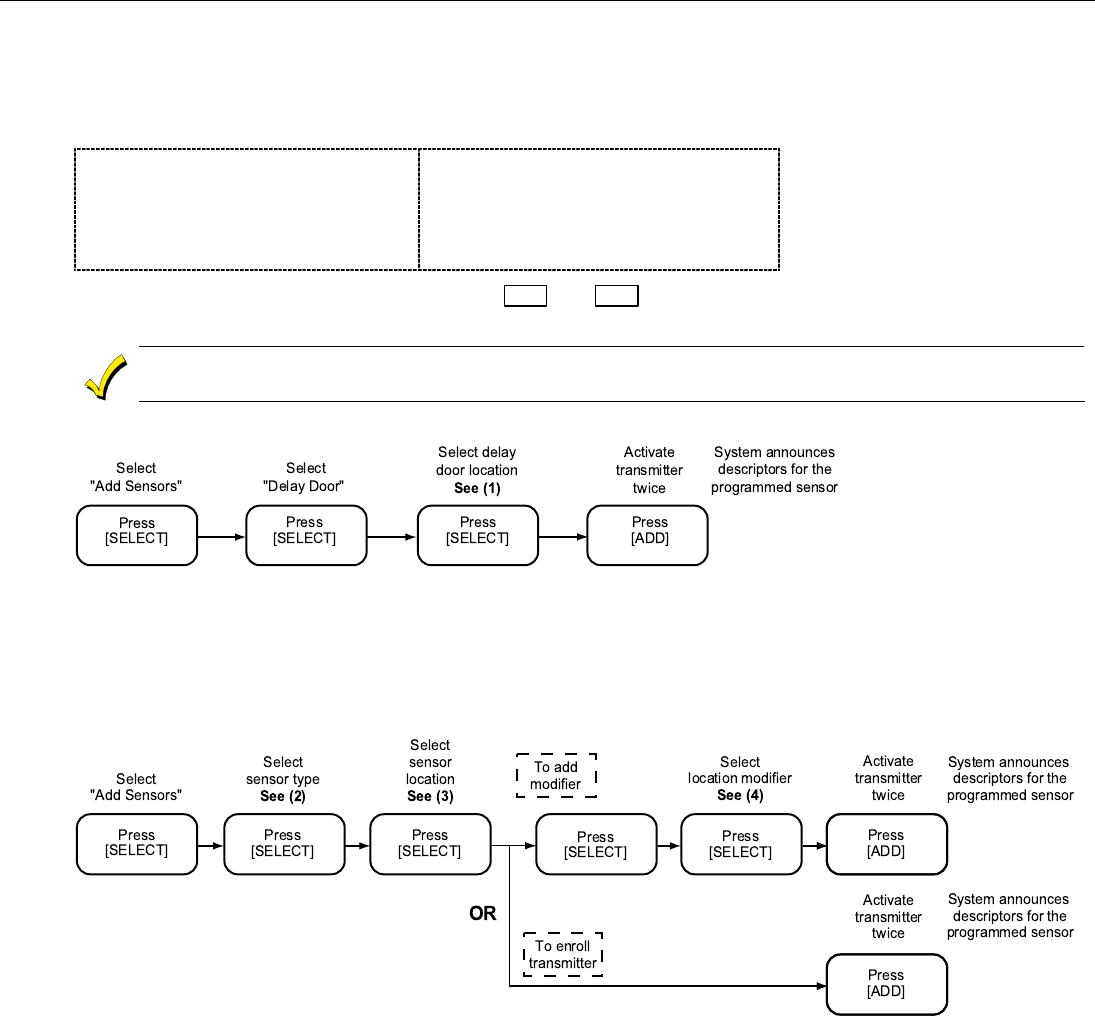
APX32EN Installation and Setup Guide
- 49 -
Voice Prompt Programming
Enter Voice Prompt Programming Mode: (Installer Code + 8 8 8). Follow the voice prompts to
advance to the selected item in the Main Programming Menu.
Add Sensors Delete Sensors
First Central Station Phone Number First Central Station Account Number
Second Central Station Phone Number Second Central Station Account Number
Templates
Expert Programming Mode
Program each option as shown below. Use the 6 ↓ and 3 ↑ keys to scroll through the voice menu and
follow the voice prompts to program the APX32EN.
The APX32EN will enroll a sensor once the transmitter has been activated two times. The system will confirm the
enrollment following each subsequent activation of the same transmitter.
To Add a Door Sensor
(1) Delay Door Location
Front Basement
Back Sliding
Side Hall
Garage Kitchen
Patio
To add a Window, Motion Detector, or Fire Detection Sensor
(2) Sensor Type (3) Sensor Location (4) Location Modifiers
Window Living room Den Upstairs
Motion Detector Dining room Family Room Downstairs
Fire Detection Bedroom Guest Room First
Bathroom Laundry Room Second
Nursery Utility Room Third
Kitchen Garage Second Floor
Hall Attic Front
Basement
Master Bedroom
Office
Upstairs
Rear
Side
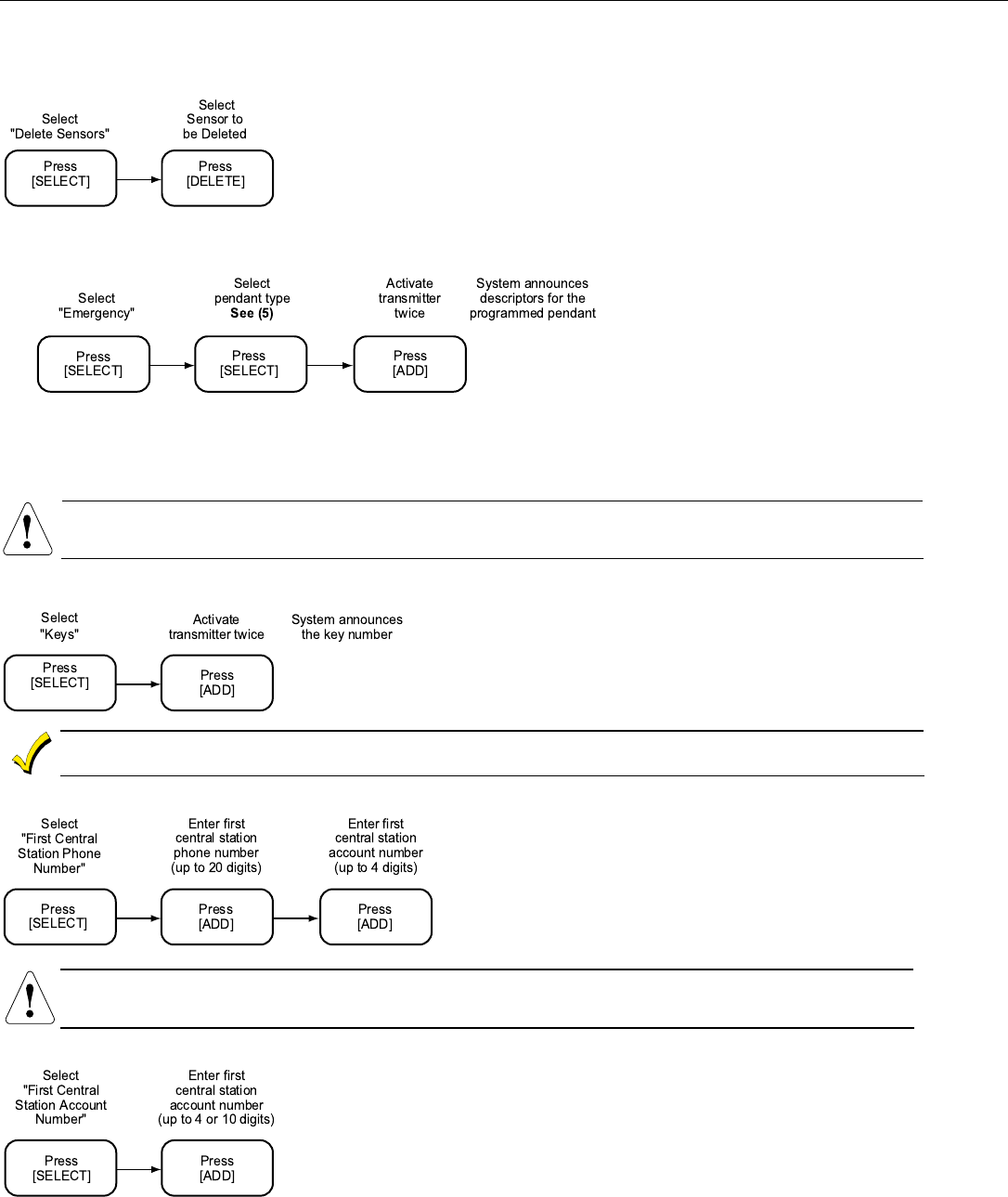
APX32EN Installation and Setup Guide
- 50 -
Voice Prompt Programming
To Delete Sensors
To Add an Emergency Pendant
(5) Pendant Type
Medical
Fire
Silent Police
Police
When adding wireless keys, wait 5 seconds between transmissions.
To Add a Wireless Key
APX32EN automatically saves phone and account number data once all available digits are entered.
To Add First Central Station Phone Number
All four digits of the Central Station Account number must be entered. If ten-digit format is selected, all
ten digits must be entered.
To Add First Central Station Account Number
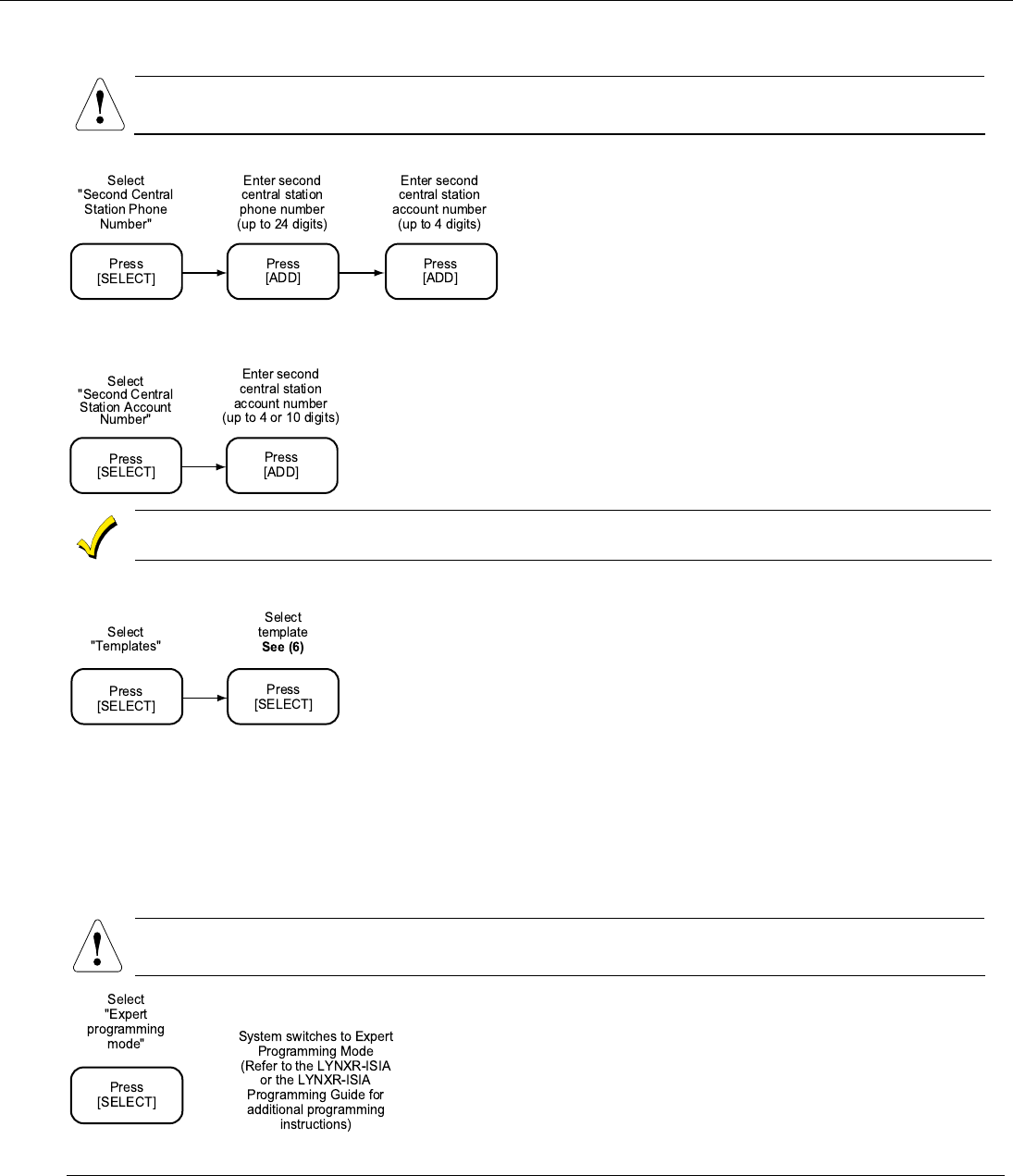
APX32EN Installation and Setup Guide
- 51 -
Voice Prompt Programming
All four digits of the Central Station Account number must be entered. If ten-digit format is selected, all
ten digits must be entered.
To Add Second Central Station Phone Number
To Add Second Central Station Account Number
Refer to the APX32EN Programming Default Tables to view the complete set of Template (default table)
selections.
To Program a Template (Default Table)
(6) Template selections
Template 1
Template 2
Template 3
Template 4
To Enter Expert Programming Mode
Once you have entered the Expert Programming Mode, the [ESCAPE] key can be used to return to the
Voice Prompt Programming mode.

APX32EN Installation and Setup Guide
- 52 -
Remote Programming/Control (Downloading)
General Information
The control panel can be remotely programmed from an IBM-compatible Personal Computer (PC) and
ADEMCO’s Compass Downloader a HAYES Modem or via capable GSM or IP communications module.
U
UU
UL
LL
L Downloading may only be performed if a technician is at the site.
Multiple security levels protect remote programming against compromise by attempts to defeat the system.
1. Security Code Handshake: An 8-digit download ID code must be matched between the Control and
downloader.
2. Site-Initiated Remote Programming: The installer or subscriber initiates the call from the subscriber
premises (by entering Installer Code + # + 1) while disarmed. All parameters can then be downloaded via
the phone lines using a personal computer.
3. Station-Initiated Remote Programming: The operator calls the site from your office to initiate the
download call. The Control hangs up and then calls back the PC via the preprogrammed telephone
number. The unit can then be uploaded, downloaded, or controlled from your office.
4. Telco Handoff: The installer or subscriber performs a download session on the call initiated from the
site or from local laptop computer (by entering Installer or Master Code + # + 1 at the control panel).
5. Data Encryption: Data passed between the PC and the Control is encrypted for security so that it is
very difficult for a foreign device tapped into the phone line to take over communication and substitute
system-compromising information.
Equipment required to download to a system at the premises
• An IBM PC compatible computer and appropriate interconnecting cables.
• Either a HAYES brand SMARTMODEM 1200 (Level 1.2 or higher external or Level 1.1 or higher [with 4
position DIP switch] internal style), a HAYES brand Optima 336 external, a HAYES brand Optima 24
Plus FAX96, or an Ademco CIA Modem or via a capable GSM or IP communications device.
• Compass Downloader for Windows (at revision level supporting APX32EN).
Initial Download: Enter Installer Code + # + 5. This sets field ✻95 to 4 rings, and system to “no call-
back” option. The download computer can then call the subscriber, make connection, and download all
programming data.
Flexible Callback: If enabled in field ✻93, the download operator can temporarily change the last 1, 2, or 3
digits (depending on selection) of the call back number. This allows the control to call back a computer other
than the one programmed, which may be helpful at times of high computer traffic. See field ✻93 for a full
description.
Remote Programming Information
If using Remote Programming, the APX32EN must be connected to the telephone line or to the Internet, as
applicable.
The downloading system can perform many functions when in communication with the Control. Besides
uploading and downloading, the status of the system can be observed and various commands can be
initiated, as follows:
• Arm the system in the away mode; disarm the system.
• Bypass a zone.
• Force the system to accept a new program download.
• Shut down communication functions (for nonpayment of monitoring fees in an owned system).
• Shut down all security system functions (for nonpayment for a leased system).
• Inhibit local keypad programming (prevents account takeover).

APX32EN Installation and Setup Guide
- 53 -
Remote Programming/Control (Downloading)
• Command the system to upload a copy of its resident program to the office.
• Set the time
• View/Modify
• X10/ Scheduling
• Read: arming status, AC power status, lists of faulted zones, bypassed zones, zones currently in alarm,
zones currently in trouble, and RF sensors with low battery conditions; read control’s time.
Notes: (1) After the control and the PC have established valid communication, the keypad will become inactive and will
display “CC.”
(2) The keypad will become active after the download communication is terminated.
(3) The detailed operation of the download functions is covered in the installation instructions for the Compass
Downloader for Windows.
Remote Programming Advisory Notes
• Keypad entries are ignored during the time interval stated above.
• A copy of the program downloaded may be printed using the IBM PC-compatible computer’s internal
report generator, when an optional printer is connected (consult your PC manual for proper printer and
connections).
• Program upload or download time is approximately one minute, fifteen seconds for a complete program.
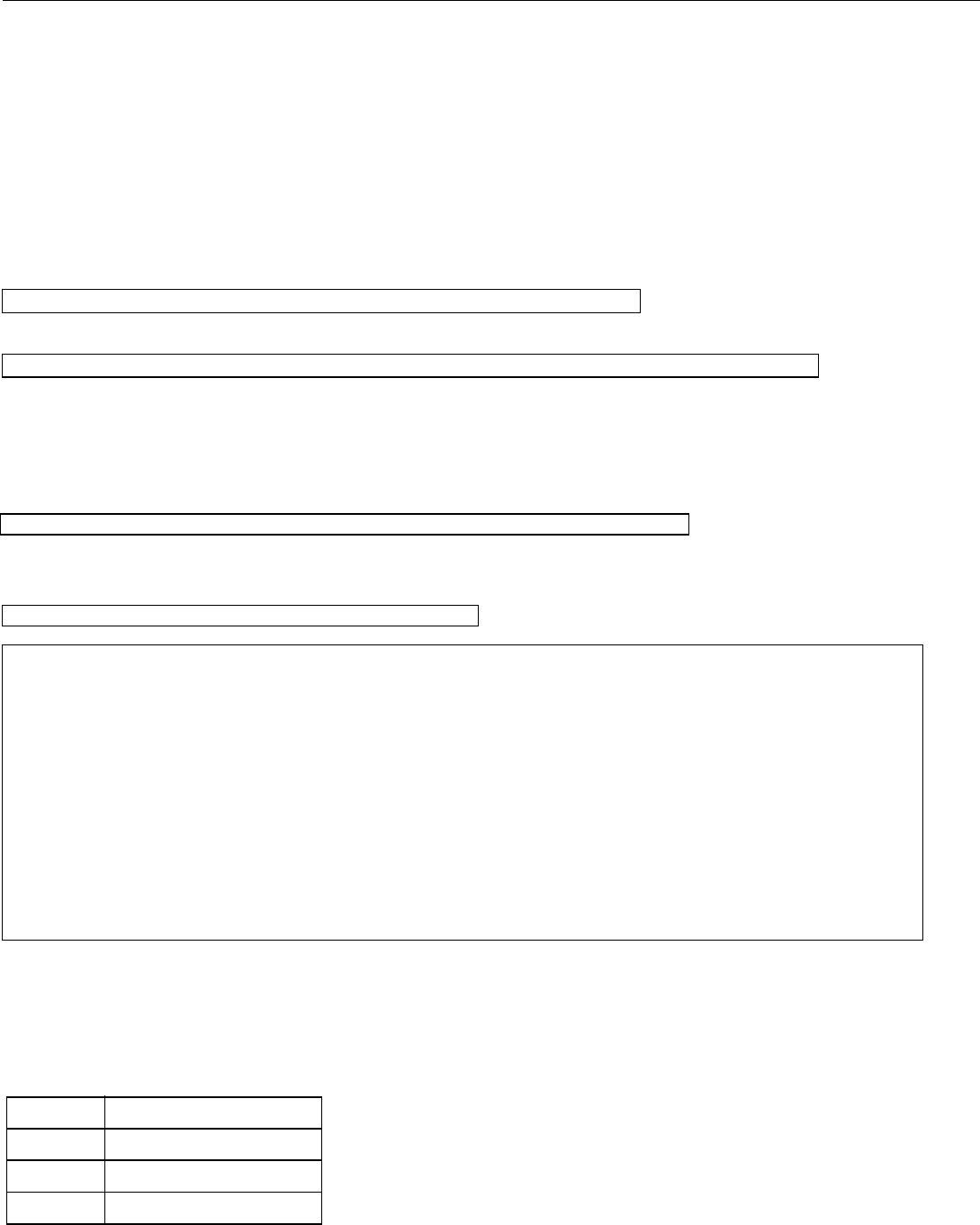
APX32EN Installation and Setup Guide
- 54 -
System Operation
Security Codes
Installer Code
The installer programs the 4-digit Installer Code initially as part of the programming procedure. The
factory default Installer Code is 4-1-1-2, but may be changed in field ✻20.
The Installer Code is the only code that can enter Programming mode and also, in normal operation
mode, is used to enter the Master Code, which allows access to the normal functions of the system.
Master Code
In normal operation mode, the Installer Code is used to enter the 4-digit Master Security Code.
To enter/change the Master code by installer, using the keypad enter:
Installer Code + [CODE key] + [02] + desired 4-digit Master Code
To change the Master code by master, using the keypad enter:
Current Master Code + [CODE key] + [02] + new Master Code + new Master Code again
Secondary User Codes
In normal operation mode, the Master Security Code can be used to assign up to 6 secondary 4-digit security
codes, including a Babysitter Code and a Duress Code. The Master Code can also be used to remove
secondary codes from the system (individually).
To assign (or change) a secondary security code, using the keypad enter:
Master Code + [CODE key] + User # (03–08) + desired Secondary Code
The system will emit a single beep when each secondary code has been successfully entered.
To delete a secondary security code, using the keypad enter:
Master Code + [CODE key] + User # (03–08)
Security Code Notes
• The Master and Secondary security codes permit access to the system for arming, disarming, etc.
• The Installer Code can disarm the system only if it was used to arm it. In addition, the Installer Code cannot
disarm the system if it was armed by pressing and holding a Quick-Arm button.
• The Babysitter Code (User Code No. 7) can disarm the system only if it was used to arm it. In addition, the
Babysitter Code cannot disarm the system if it was armed by pressing and holding a Quick-Arm button.
• Duress code (User Code No. 8) sends a special code to the monitoring station when used to perform any system
operation.. Instruct users to be careful not to use this code for normal usage. If the duress code is programmed, you
must enter a report code for Zone 92 (duress).
• If a secondary code is inadvertently repeated for different users, the lower user number will take priority.
• Opening/closing reports are sent for the Installer Code as No. 01, with the appropriate subscriber number. Master
Code and set of secondary user codes are sent as Nos. 02 and 03–08, respectively, in Contact ID® format (with the
appropriate user number); in 4+2, it is 1–8. Quick arming (and open/close executed by downloader) is reported as
user 00.
Panic Keys
There are three panic key pairs that, if programmed, can be used to manually initiate alarms and send a
report to the central station.
Each can be individually programmed for 24-hour silent, audible, personal or fire emergency responses. The
panic function is activated when both keys of the appropriate key pair are pressed at the same time.
The panic functions are identified by the system as follows:
Keys Displayed as Zone
[1] & [✻] 95
[✻] & [#] 99
[3] & [#] 96
Important: For the silent panic functions to
be of practical value, the system must be
connected to a central station.
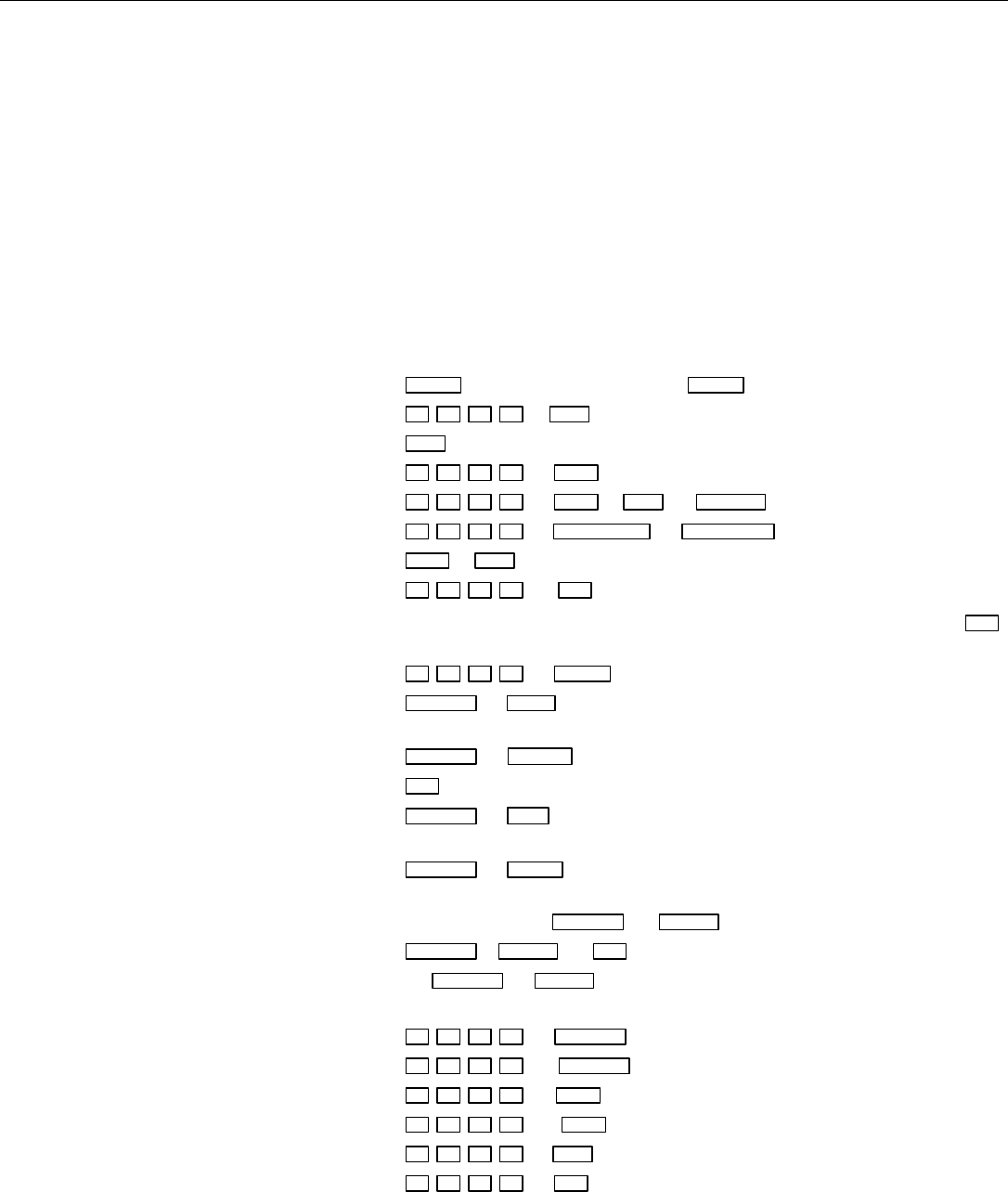
APX32EN Installation and Setup Guide
- 55 -
System Operation
Keypad Functions
The keypad allows the user to arm and disarm the system, and perform other system functions, such as
bypassing zones. Zone and system conditions (alarm, trouble, bypass) are displayed in the display window.
When an alarm occurs, keypad sounding and external sounding will occur, and the zone(s) in alarm will be
displayed on the keypad. Pressing any key will silence the keypad sounder for 10 seconds (only once).
Disarming the system will silence both keypad and external sounders. When the system is disarmed, any
zones that were in an alarm condition during the armed period will be displayed (memory of alarm). To
clear this display, simply repeat the disarm sequence (enter the security code and press the OFF key). The
keypad also features chime annunciation, and 3 panic key pairs for silent, audible, fire or personal
emergency alarms. These keys can notify the central station of an alarm condition, if that service is
connected. A summary of system functions is provided below for more detailed information refer to the
User’s Manual.
Security Functions (Empty boxes represent the user’s security code)
Checking system status: ............................. STATUS (high level messages); press STATUS again for secondary messages
To arm in STAY mode: .............................. + STAY (or installer code + [3])
To restart exit delay: ............................... STAY (applies only if system is armed in Stay mode)
To arm in AWAY mode:............................... + AWAY (or installer code + [2])
To arm with NO DELAY: ............................ + AWAY or STAY + NO DELAY OR
................................................................................................... + AWAY INSTANT OR STAY INSTANT
To arm if Quick Arm is programmed:......... AWAY or STAY (hold down for at least 2 seconds)
To disarm the system and silence alarms:. + OFF
Note: During Entry Delay or when an Alarm Condition exists the system can be disarmed by entering the User Code. Entering the OFF
key is not required.
To bypass a zone(s): .................................... + BYPASS + 2-digit zone number(s)
To turn Chime mode on or off: ................... FUNCTION + CHIME
Message Center
To record a message:.......................................... FUNCTION + RECORD
To stop recording before end of 90 seconds:OFF
To play back a message:.................................... FUNCTION + PLAY
To skip a message: ............................................. [✻]
To delete all messages:...................................... FUNCTION + DELETE (during message replay)
Volume Control
To adjust message playback/system announcement volume: FUNCTION + VOLUME + [3] or [6]
To mute system announcements: ............... FUNCTION +VOLUME + OFF
To restore/unmute announcement & volume: FUNCTION + VOLUME + [3] or [6]
Other Functions
To set the time and date: ............................ + FUNCTION + [63]
To set the scheduling: ................................. + FUNCTION + [64]
To add a user code: ..................................... *+ CODE + user number + user’s code (*master code)
To delete a user code (except Master Code): *+ CODE + user number (* master code)
To turn Test mode on: ................................. + TEST
To turn Test mode off: ................................. + OFF
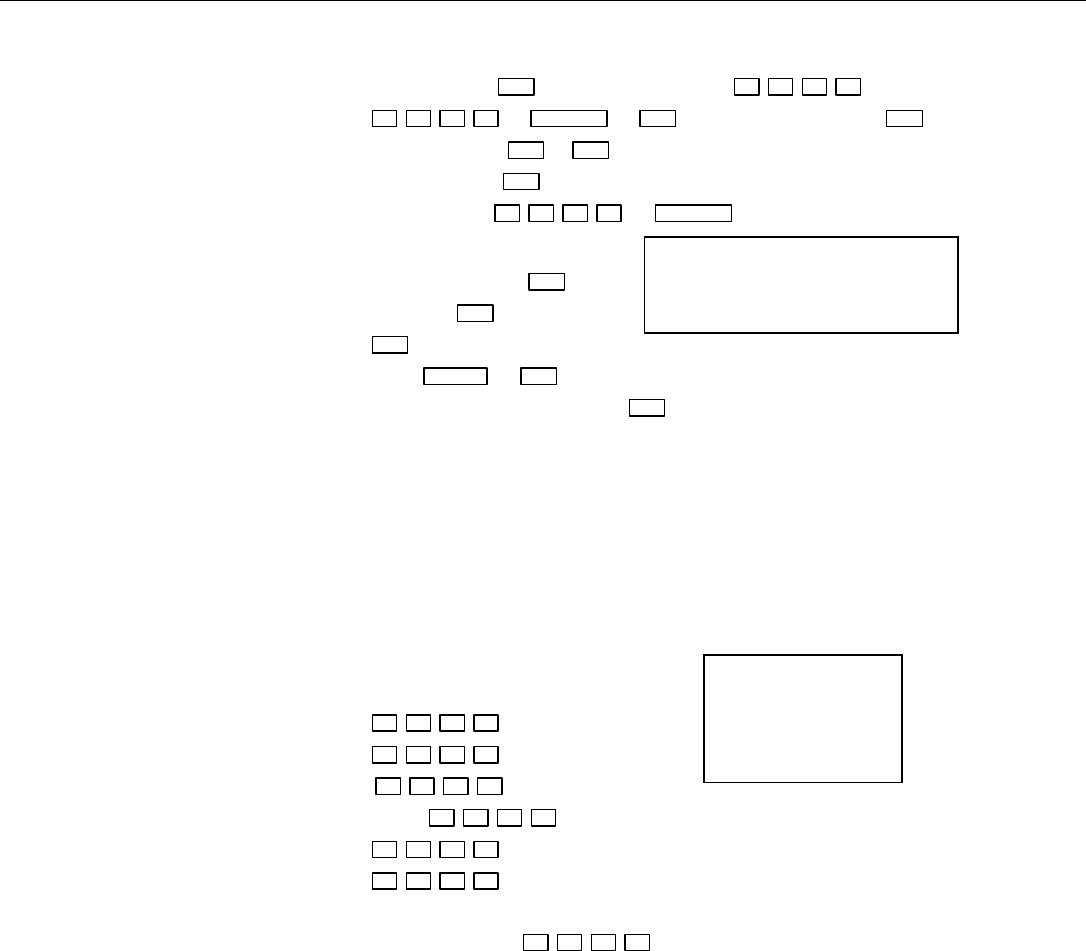
APX32EN Installation and Setup Guide
- 56 -
System Operation
To use the defined AUX function: .................. Press and hold AUX key 2 secs (4 beeps) +
To define AUX function: .............................. + FUNCTION + AUX + action separated by + AUX
terminated by + AUX + AUX
To send message to pager: .......................... Press and hold AUX key 2 seconds (4 beeps)
To program Follow Me Reminder telephone number: + FUNCTION + [65]
Speaker Phone Operation
To place a call or answer a call using the speaker phone: [#] + AUX
To flash (switch between two calls using call waiting): AUX
To hang up and exit speaker phone mode:. OFF
To enable/disable (toggle) ringer: ................ [#] + VOLUME + AUX
To return the keypad to telephone mode after disarming the system: [#] + AUX
Remote Phone Control Feature
The remote phone control feature, which must be enabled in field ✻91, allows the user to access the security
system from any off-site touch-tone telephone. The control will pick up the incoming call, based on the ring
count specified in field ✻95, and will announce “SYSTEM ENTER CODE” every three (3) seconds for the
next eight (8) seconds. During this period the panel will wait for a valid User Code to be entered. If a valid
User Code is not entered or the eight (8) second period expires a modem tone will be generated for remote
programming (Compass Downloading). If a valid User Code has been entered, the control will announce the
current system status and/or beeping sounds.
Keypad Functions
Remote Phone Control Feature
To remotely disarm system:............................. + [1]
To remotely arm in AWAY mode: .................. + [2]
To remotely arm in STAY mode:........................ + [3]
To remotely arm in AWAY or STAY with no delay: + [2] or [3] + [0]
To remotely Bypass zones: ............................... + [6] + zone no.
To remotely activate Forced Bypass: ............ + [6] + [#]
To remotely check system status:................... [✻]
To end remote phone control session: ........... Hang Up or enter + [9]
Quick Arm Note
The installer code and
babysitter code cannot
disarm the system if
armed by Quick Arm
method.
NOTE
The ARMED and READY LEDs blink
alternately when the Speaker Phone is
active.
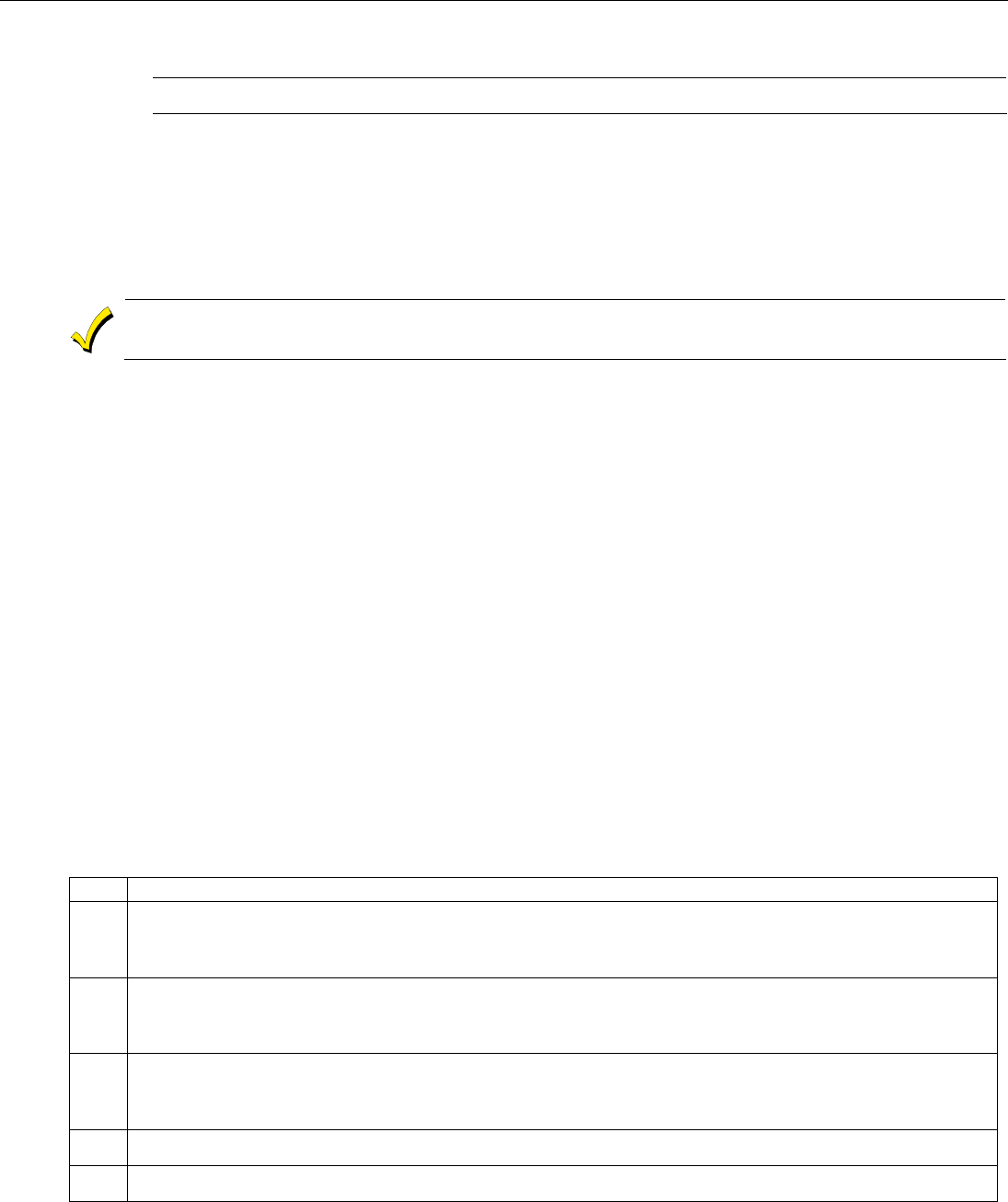
APX32EN Installation and Setup Guide
- 57 -
System Operation
U
UU
UL
LL
L
Audio alarm verification has not been evaluated by UL.
Audio Alarm Verification (Two-Way Voice Feature)
This feature allows the central station operator to listen, talk to or conduct a two-way conversation with an
individual(s) at the premises. It also assists the operator in gathering information about the nature and
location of the alarm that may be helpful in responding to police and fire departments. All APX32EN control
panels are capable of supporting the Two-Way Voice feature. The APX32EN does not make system
announcements when the Two-Way voice feature is active.
Activation
Fire and CO alarms will not trigger an AAV session. A new Fire or CO alarm will end an AAV session that is
in progress.
The APX32EN sends the “alarm message” followed by a “Listen-in-to-Follow message” (Contact ID® code
606) to the Central Station. The Listen-in-to-Follow message causes the Central Station’s digital receiver to
temporarily hold the phone line for approximately 1-minute. When the APX32EN receives the “kissoff” from
the central station, indicating that the alarm message has been received, the Two-Way Voice (AAV) feature
is activated in the (default) “Listen Mode” and sirens and keypad sounds are discontinued. The APX32EN
transmits a beep acknowledgment to the Central Station, once per second. The beep alternates between two
tones and indicates that the APX32EN is waiting for a session command from the Central Station operator.
Once a command is issued the beep acknowledgement is discontinued, however, if a command is not issued
within two minutes the system will “time out” and the call will be terminated.
Operator Commands
The Central Station operator begins the session, which last 5 minutes, by entering one of the valid AAV
commands shown in the table below. The session may be extended 5 minutes, without changing the
operating mode, by pressing the [7] key on the touch-tone phone. Selecting another operating mode also
resets the session an additional 5 minutes. During the last minute of the 5 minute, session, the APX32EN
generates two beeps every 30 seconds to alert the Central Station operator that the session is about to time
out. The Central Station operator may then extend the session by pressing the [7] key on the touch-tone
phone. If the session is not extended the phone line is disconnected, and the session is ended. Sessions may
be ended at any time by pressing the [9] key on the touch-tone phone. The AAV modes are described as
follows:
Note: When entering AAV commands make sure the Central Station receiver has been disconnected from the
phone line, otherwise AAV commands may not go through.
Key Function
1 Talk Mode: Pressing the [1] key on the touch tone phone, enables one-way voice communication from the
central station to the violated premises, and allows the operator to talk communicate through the
APX32EN speaker. In this mode the ARMED (red) and READY (green) LEDs blink alternately.
2 VOX (Voice) Mode: Pressing the [2] key on the touch-tone phone, enables two-way voice communications
between the central station and the violated premises. In this mode the ARMED (red) and READY (green)
LEDs blink alternately.
3 Listen Mode: Pressing the [3] key on the touch-tone phone, enables one-way audio from the violated premises
to the central station. The Listen Mode is the start up default mode of the voice feature and allows the
operator to listen through the APX32EN microphone. This mode does not affect the existing LED pattern.
7 Extends the session 5 minutes without changing its operating mode.
9 Ends the session and disconnects the phone line.
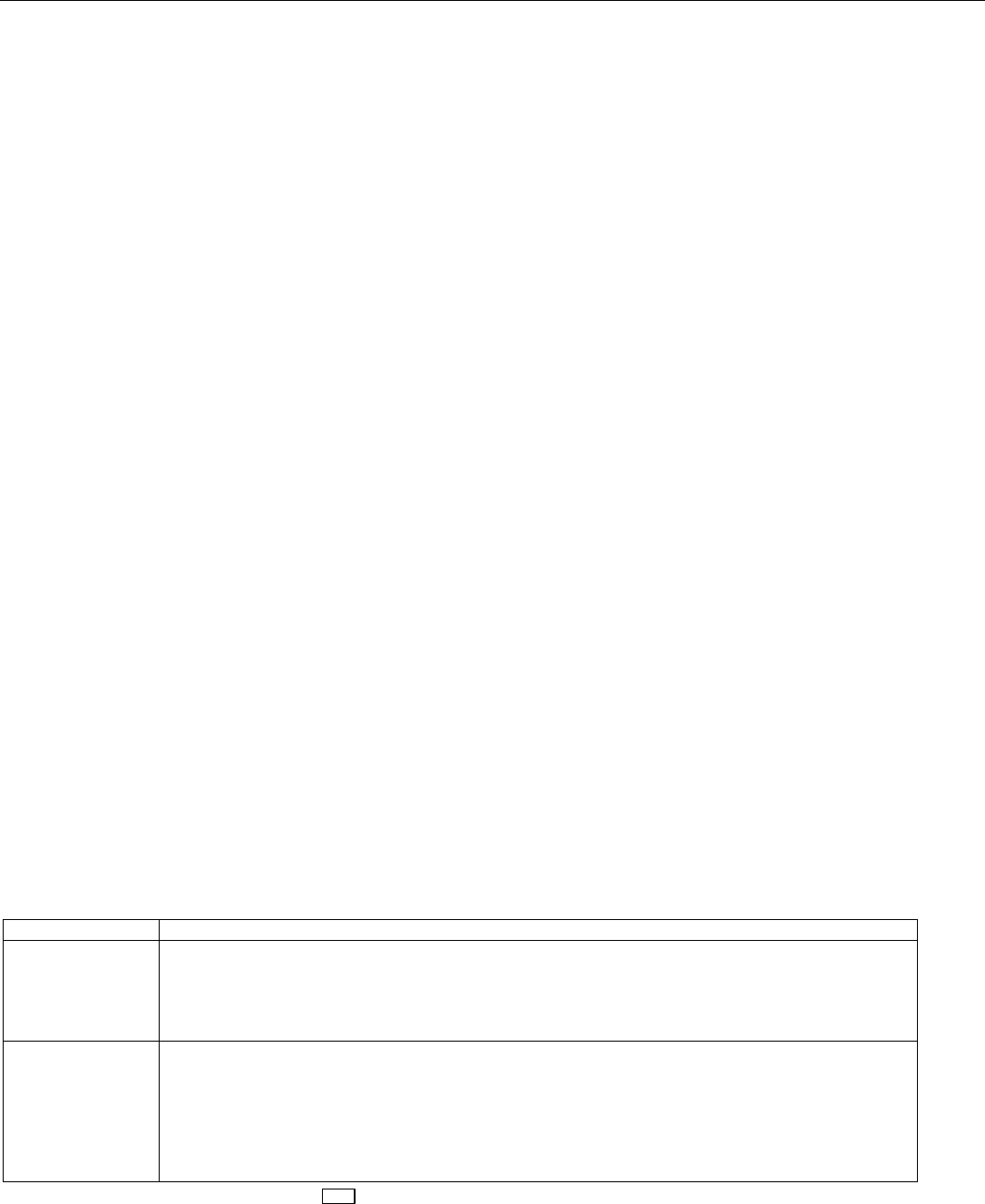
APX32EN Installation and Setup Guide
- 58 -
System Operation
“Follow Me” Reminder Feature
This feature allows the user to schedule a time driven message. When activated the system will dial a phone
number, that the installer programs in Field ✻46, and deliver a voice message (custom words 72, 73, and 74).
The APX32EN will immediately begin transmitting the voice message and will repeat the message for 45
seconds. Pressing any touch-tone key on the answering phone will acknowledge the message ending the
session and preventing the system from redialing the programmed number. Delivery of a reminder message
on the local APX32EN keypad will continue. If the message has timed out the system will redial the
programmed number a maximum of seven additional times or until it is acknowledged. Pressing any key on
the APX32EN keypad will terminate (acknowledge) both the follow me reminder and the local reminder
announcements.
Notes: (1) This feature is only supported if programmed in field ✻49.
(2) The follow me reminder will be terminated if any other event requires the system to dial out, or if an audible
alarm has occurred, however, delivery of the local schedule reminder message will continue.
“Follow Me” System Announcement Feature
This feature allows the APX32EN to deliver a voice system message to the secondary phone number
programmed by the installer. The APX32EN will first transmit reports to the Central Station and after
receiving its kiss-off the system will dial the secondary phone number and begin transmitting the voice
message. This message is a repeatable system status announcement. Like the Follow Me reminder, pressing
any key on the answering telephone or the local APX32EN keypad will terminate (acknowledge) the
message. The system will dial the secondary phone number a maximum of eight times. The Follow Me alarm
functions may be triggered by a variety of events depending upon the selections made during programming
in field ✻49.
Note: The follow me system announcement will be terminated if any other event requires the system to dial out or if an
audible alarm has occurred.
Powerline Carrier Devices (e.g. X10 devices)
If Powerline Carrier Devices are used, two keypad entries available to the user are included. They
can manually activate or deactivate the device(s) for starting or stopping some action, such as
turning lights on or off, etc.
These keypad entries are:
Security Code* + [#] + [4] + Device # activates (starts) that device.
Security Code* + [#] + [7] + Device # de-activates (stops) that device.
*Code is required for devices 7 and 8. Code is not required for devices 1-6.
Exit Error Alarm Displays
The system will display the following if programmed in Field *59.
Display Meaning
CA will appear along with a zone indication if an exit or interior zone contained a fault
during closing at the time the exit delay ended (e.g., exit door left open), but the system
was disarmed during the entry delay time. The alarm sounder and keypad sound
continuously, but stop when the system is disarmed. No message will be transmitted to
the central station.
EA will appear along with a zone indication if an exit or interior zone contained a fault
during closing at the time the exit delay ended, but the system was NOT disarmed
during the entry delay time. The alarm sounder and keypad sound continuously until
the system is disarmed (or timeout occurs). An Exit Alarm message is sent to the central
station. OR
if an alarm from an exit or interior zone occurs within two minutes after the end of an
exit delay
Entering a second OFF sequence (Code + OFF ) will clear the display.
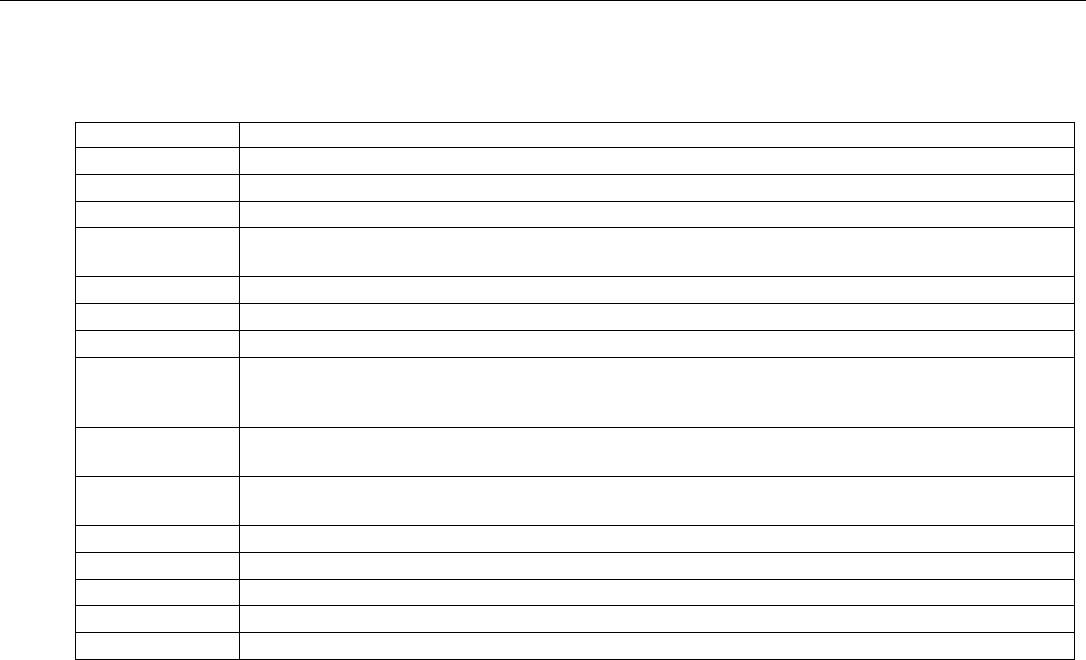
APX32EN Installation and Setup Guide
- 59 -
System Operation
System Displays
Display Meaning
PC Remote Phone Control feature is active (Appears in place of the clock).
PH System Speaker Phone mode is active (Appears in place of the clock).
AC AC power is present. If not displayed, the system is operating on backup battery power.
ALARM System is armed and an intrusion has been detected (also appears during a fire alarm
or audible emergency alarm). Accompanied by the protection zone that is in alarm.
AWAY All burglary zones, interior and perimeter, are armed.
BYPASS One or more burglary protection zones have been bypassed.
CHIME Chime feature is activate
OPEN A malfunction is discovered in the system; or an open is detected in a fire zone; or a fault in a
day/night burglary zone is discovered during a disarmed period. Accompanied by a display of
the zone number in trouble.
FIRE A fire alarm or fire fault is present. Accompanied by a display of the zone that is in
alarm
LOW BAT Low battery condition in a wireless sensor (if zone number is displayed) or low system battery (if
no zone number is displayed). If 00 is displayed, a wireless keypad has a low battery condition.
INSTANT Entry delay is turned off.
MESSAGE A message has been recorded and has not yet been played back.
REC The system is in Recording mode.
STAY Perimeter Burglary zones, such as protected windows and doors, are armed
TEST System is in Test mode.

APX32EN Installation and Setup Guide
- 60 -
Testing the System
Test Mode
After installation is completed, the security system should be carefully tested, as follows.
1. With the system in the disarmed state, check that all zones are intact. If the READY LED is not lit,
press the [ ✻] key to display the faulted zone(s). Restore faulted zone(s), if necessary, so that the
READY LED lights. Fault and restore every sensor individually to assure that it is being monitored by
the system.
2. Enter the security code and press the TEST key. The outside sounder will sound for 1 second and all
the LED segments on the keypad display light for 3 seconds. APX32EN announces the zone’s voice
descriptor (if programmed) followed by 3 beeps, each time a contact is faulted. A test report should be
transmitted (if programmed) to the central station immediately. If the backup battery is discharged or
missing, the sounder may not turn on and a LOW BATTERY report will be transmitted with a TEST
report. The keypad will beep once every 45 seconds as a reminder that the system is in the Test mode.
3. To turn off the Test mode enter security code and press the OFF key.
Notes: (1) Triggering a zone set to Arm AWAY, Arm STAY, or Disarm will take the system out of Test and cause that
action.
(2) BR type transmitters do not display during Test mode (keypad beeps only)
(3) Macros cannot be run from the Test mode.
(4) Test mode automatically ends after 4 hours. During the final 5 minutes (after 3 hours 55 minutes of Test mode),
“TEST” flashes on the keypad indicating that the end of Test mode is nearing.
(5) Upon termination of a test mode all faulted 24-hour zones are treated as a trouble zones.
(6) Fire verification is disabled when the system is in Test mode.
Armed System Test
Alarm messages will be sent to the central station during the following tests 1 and 2. Notify
them in advance that tests will be in progress.
1. Arm the system and fault one or more zones. After 15 seconds (if optional burglary abort is selected),
silence alarm sounder(s) by entering the code and pressing OFF. Check entry/exit delay zones.
2. Check the keypad-initiated alarms that are in the system by pressing the Panic key pairs. If the system
has been programmed for audible emergency, the keypad will emit a steady alarm sound, and
“ALARM” and zone number will be displayed. Silence the alarm by entering the security code.
If the system has been programmed for silent emergency, there will be no audible alarms or displays,
but a report will be sent to the central station.
3. If Powerline Carrier Devices have been installed, test their programmed action.
4. Notify the central station when all tests are finished, and verify results with them.
5. To test the wireless part of the system and the RF receiver, perform the two additional tests described
in the Installing Wireless Zones section: Sniffer mode and Go/No Go Test.
Note: System Test mode (installer/master code + test) and Go/No Go Test (installer code + # + 8) will be automatically
terminated after 3-1/2 to 4 hours if the installer or user does not manually terminate it. This ensures that fire and
panic zones will not remain disabled. However, Sniffer mode (installer code + # + 3) does not automatically expire.
You must manually exit (Installer/User Code + OFF) Sniffer mode to return to normal operation.
TO THE INSTALLER
Regular maintenance and inspection (at least annually) by the installer and frequent testing by the user
are vital to continuous satisfactory operation of any alarm system.
The installer should assume the responsibility of developing and offering a regular maintenance program
to the user as well as acquainting the user with the proper operation and limitations of the alarm system
and its component parts. Recommendations must be included for a specific program of frequent testing (at
least weekly) to ensure the system’s proper operation at all times.

APX32EN Installation and Setup Guide
- 61 -
System Communication
This section provides an explanation of formats this system accommodates for reporting alarms and other
system conditions to the central station. The process of a successful transmission consists of both the
method of communication between the control panel and the central station receiver, and the actual way the
information is sent and displayed at the central station.
Communication Overview
When the panel calls the central station receiver, it waits to hear a “handshake” frequency from the receiver
to confirm that the receiver is on-line and ready to receive its message. Once the panel hears the handshake
it is programmed to listen for, it sends its message. The panel then waits for a “kissoff” frequency from the
receiver acknowledging that the message was received and understood.
3
If the handshake frequency is not given or is not understood by the panel, the panel will not send its
message. Once the handshake frequency is received and understood by the panel, the panel will send its
message. If there is an error in the transmission (the receiver does not receive a “valid” message), the kissoff
frequency will not be given by the central station receiver.
The panel will make eight attempts to the primary telephone number and eight attempts to the secondary
telephone number (if programmed) to get a valid message through. If the panel is not successful after its
numerous attempts, the keypad will display “FC.” If the secondary number is a pager, “FC” displays after
the first 8 attempts to the primary number.
The following chart defines the three sets of (handshake/kissoff) frequencies that the panel supports, and the
different formats that can be sent for each.
FORMAT HANDSHAKE TRANSMITS DATA KISSOFF TRANSMIT TIME
Low Speed 1400Hz 1900Hz (10PPS) 1400Hz Under 15 seconds
3+1 (Standard report)
4+1
4+2
Sescoa/Radionics 2300Hz 1900Hz (20PPS) 2300Hz Under 10 seconds
3+1 (Standard report)
4+1
4+2
Express 1400–2300Hz DTMF (10 cps) 1400Hz Under 3 seconds
4+2
Contact ID® 1400–2300Hz DTMF (10 cps) 1400Hz Under 3 seconds
Report Code Formats
3+1 and 4+1 Standard Formats Comprise a 3- (or 4-) digit subscriber number and a single digit report
code (e.g. alarm, trouble, restore, open, close, etc).
3+1 and 4+1 Expanded Formats Comprise a 3- (or 4-) digit subscriber number, and a 2-digit report code.
The first digit is displayed on the first line, followed by a second line
where the first digit is repeated 3 (or 4) times and followed by the
second digit. This is the “expanded” digit.
4+2 Format Comprises a 4-digit subscriber number and 2-digit report code.
ADEMCO Contact ID® Comprises a 4-digit subscriber number, 1-digit event qualifier
Reporting Format (“new” or “restore”), 3-digit event code, and 3-digit zone number, user
number, or system status number (see the following page).
The following table shows the message formats for 3+1, 4+1 and 4+2 reports, where:
SSS or SSSS = Subscriber ID C = Close Code (1st Digit)
A = Alarm Code (1st digit) U = User Number (in hex)
Z = Typically Zone Number* (2nd digit) G g = Test Code (1st & 2nd digits)
T t = Trouble Code (1st & 2nd digits) R = Alarm Restore Code
Bb = Bypass Code (1st & 2nd digits) R Tt = Trouble Restore Code (1st & 2nd digits)
EAC = AC Loss Code (1st & 2nd digits) R Bb = Bypass Restore Code (1st & 2nd digits)
LLB = Low Battery Code (1st & 2nd digits) R AAC
= AC Restore Code (1st & 2nd digits)
O = Open Code (1st Digit) RLLB = Battery Restore Code (1st & 2nd digits)
*Zone numbers for: [*] & [#] = 99; [1] + [*] = 95; [3] + [#] = 96; Duress = 92

APX32EN Installation and Setup Guide
- 62 -
System Communication
Report 3+1/4+1 Standard 3+1/4+1 Expanded 4+2
Alarm SSS(S) A SSS(S) A
AAA(A) Z
SSSS AZ
Trouble SSS(S) T SSS(S) T
TTT(T) t
SSSS Tt
Bypass SSS(S) B SSS(S) B
BBB(B) b
SSSS Bb
AC Loss SSS(S) E SSS(S) E
EEE(E) AC
SSSS EAC
Low Battery SSS(S) L SSS(S) L
LLL(L) LB
SSSS LLB
Open SSS(S) O SSS(S) O
OOO(O) U
SSSS OU
Close SSS(S) C SSS(S) C
CCC® U
SSSS CU
Test SSS(S) G SSS(S) G
GGG(G)g
SSSS Gg
Restore Alarm SSS(S) R SSS(S) R
RRR® Z
SSSS RZ
AC Restore SSS(S) RA SSS(S) RA
RARARA(RA)Ac
SSSSRA Ac
Low Battery Restore SSS(S) RL SSS(S) RL
RLRLRL(RL)LB
SSSS RLLB
Trouble Restore SSS(S) RT SSS(S) RT
RTRTRT (RT)t
SSSS RTt
Bypass Restore SSS(S) RB SSS(S) RB
RBRBRB (RB)b
SSSS RBb
ADEMCO Contact ID® Reporting takes the following format: CCCC Q EEE GG ZZZ where:
CCCC = Customer (subscriber) ID
Q = Event qualifier, where: E = new event, and R = restore
EEE = Event code (3 hex digits) (for a complete list of event codes, refer to the central office receiver manual)
GG = Always “00”
ZZZ = Zone/Contact ID® number reporting the alarm, or user number for open/close reports. System status
messages (AC Loss, Walk Test, etc.) contain zeroes in the ZZZ location.
CONTACT ID® EVENT CODES
Code Definition
110 Fire Alarm
121 Duress
122 Alarm, 24-hour Silent
123 Alarm, 24-hour Audible
131 Alarm, Perimeter
132 Alarm, Interior
134 Alarm, Entry/Exit
135 Alarm, Day/Night
146 Silent Burglary
150 Alarm, 24-Hour Auxiliary
162 Alarm, Carbon Monoxide Detector
301 AC Power
302 Low System Battery/Battery Test Fail
344 RF Jam Detected
353 ECP Communication/Supervision failure, case
tamper or low battery
373 Fire Loop Trouble
374 Exit Error Alarm
380 Global Trouble, Trouble Day/Night
Code Definition
381 RF Supervision Trouble
383 RF Sensor Tamper (Trouble)
384 RF Sensor Low Battery
401 Disarmed, Armed AWAY (NO DELAY),
Armed AWAY
403 Scheduled Auto Arm
406 Cancel by User
407 Remote Arm/Disarm (Downloading)
408 Quick Arm AWAY/NO DELAY
441 Disarmed/Armed STAY/NO DELAY, Quick Arm
STAY/NO DELAY
459 Recent Close
570 Bypass
602 Periodic Test
606 AAV to follow
607 System Test
623 Event Log 80% Full
654 System Inactivity
Notes: (1) The following codes are logged in the event log upon occurrence, but are not reported:
305 = System Reset
627 = Keypad Program Mode Entry
(2) LRR/IP Communications Module Low Battery and Low Battery restore reports are sent real time. LRR/IP Communications
Module trouble restore report is sent after two code + off (only if physically restored)

APX32EN Installation and Setup Guide
- 63 -
Troubleshooting Guide
Trouble Conditions
The word “OPEN” on the keypad’s display, accompanied by a rapid “beeping” at the keypad, indicates that
there is a trouble condition in the system. Pressing any key can silence the audible warning sound. Instruct
users to call for service immediately upon seeing any of the following messages.
System Trouble Displays
Display Meaning
OPEN and one or more zone numbers indicates that a problem exists with the displayed
zone(s) and requires attention. After correcting the problem, the display can be cleared by
entering the security code plus the OFF key twice.
The fault condition may also be caused by some change in the environment that prevents
the built-in receiver from receiving signals from a particular wireless sensor.
OPEN 103 Indicates one of the following:
• control panel lost communication with the communications module
• communications module tamper detected (cover removed)
• primary communications path failure
• radio is not registered; account not activated
• primary power loss
• secondary communications path failure
• battery charger failure
• low battery
LOW BAT with no zone number indicates that the system’s backup battery is weak.
LOW BAT with a zone number and a once-per-45 seconds “beeping” at the keypad indicates that a
low battery condition exists in the wireless sensor displayed (zone “00” indicates a wireless
button/keypad). If the battery is not replaced within 30 days, a “OPEN” display may occur.
bF Backup LRR/GSM/IP module communication failure (displayed on RF Keypad only)
CA appears if an exit or interior zone contained a fault during closing at the time the Exit
Delay ended (e.g., exit door left open), but the system was disarmed during the Entry Delay
time. The alarm sounder and keypad sound continuously, but stop when the system is
disarmed. No message will be transmitted to the central station.
CC Modem Comm.:
system is communicating with the central station for change of function or status
verification.
dI Busy-Standby
displayed upon power-up. After approximately 1 minute* the green “READY” LED should
light. If the “dI” remains displayed for more than 1 minute, the system is disabled.
*To bypass the 1-minute delay, press [#] + [0].
Important: Do not try to bypass 1minute delay before “dI” is displayed!
EA appears when Exit Delay ends if an exit or interior zone contained a fault during closing.
The alarm sounder and keypad sound continuously until the system is disarmed (or
timeout occurs). An “Exit Alarm” message is sent to the central station. Also results if an
alarm from an exit or interior zone occurs within 2 minutes after the end of an Exit Delay.
FC communication failure has occurred. This message clears only when the system is
subsequently armed.
90 system has detected an RF jamming condition or excessive interference.
No display Power Failure
If there is no keypad display at all, and the LED indicators are not lit, operating power for
the system has stopped and the system is inoperative.
If the display is lit and the AC display is off, the system is operating on battery power only.
During an AC power loss, the backlighting will turn off and the indicators will flicker
slightly to minimize deep discharge of the battery.

APX32EN Installation and Setup Guide
- 64 -
Troubleshooting Guide
System (including Wireless)
SYMPTOM POSSIBLE CAUSE REMEDY
1. Transmitter signal
not received at
control.
1a. Transmitter not properly powered.
1b. Transmitter is located too far from RF
receiver.
1c. There is metal shielding between
transmitter and RF receiver.
1d. Transmitter is malfunctioning.
1e. Transmitter No. (zone) is not
programmed.
1a Check or change transmitter's battery.
1b. Move transmitter or RF receiver.
1c. Check for large metal obstructions, then relocate
transmitter if necessary.
1d. Verify by activating control with another,
similar transmitter. If O.K. now, return
defective transmitter.
1e. Verify programming.
2. Transmitter zone
number appears
during Transmitter
Sniffer mode, but
does not clear.
2a. Transmitter zone type (ZT) is set to 00
(Not Used).
2b. Transmitter battery not installed.
2c. 5800 System transmitter not "entered" in
system.
2a. Set ZT to a valid active zone type in field ✻56.
2b. Install proper battery.
2c. "Enter" unit in field ✻56 or ✻83.
3. Low battery message
on keypad.
3a. "Low Bat" (no zone Nos.)
3b. "Low Bat" + "00".
3c. "Low Bat" + "nn".
3a. System battery is low or missing.
3b. Remote RF keypad/button battery is low.
3c. Transmitter for zone “nn” has a low
battery.
3d. Standard- or High-Capacity battery
connected to wrong receptacle.
3a. Replace system battery.
3b. Replace battery in the RF keypad.
3c. Replace the battery in the displayed
transmitter.
3d. Ensure that battery is properly connected.
4. Periodic beep(s) from
keypad.
4a. System is in Test mode.
4b. A transmitter low battery has occurred
and is displayed.
4c. A supervision fault has occurred.
4d. System low battery
4a. Enter Code + OFF to exit Test mode.
4b. Enter Code + OFF and replace the battery.
4c. Check the transmitter indicated. Restore
communication to the receiver to cancel the
condition.
4d. Replace system battery
5. There is no response
to a transmitter in
normal operation,
although zone
number clears during
Transmitter Sniffer
mode.
Put control in Test mode. If zone does not
respond, try operating the tamper switch or
another input to the transmitter.
5a. If another input causes the zone to be
displayed, the wrong input was "entered"
when programming.
5b. If no response at all from this
transmitter, this physical transmitter
has not been entered by the system.
Transmitter Sniffer display is being
cleared by another unit programmed for
this zone.
5a. Delete input's serial number (not the zone), and
enter the proper input (see field ✻56).
5b. Determine which transmitter is programmed for
this zone and reprogram as necessary.
6. Nuisance or phantom
alarm.
6a. Sensors not properly installed, wired, or
monitored.
6b. Universal transmitter (5817)
programmed wrong.
6a. Check installation to see if in accordance with
established procedure.
6b. Check programming switches on transmitter.
7. Intrusion alarm for
no apparent reason.
7a. Protected door or window opened while
system armed.
7b. Improper user operation of exit/entry
delays.
7c. Magnets located too far from switches,
and/or doors and windows not properly
aligned.
7a. Check with all occupants of protected home.
7b. Check setting of entry and exit delays.
7c. Check all openings for proper switch and
magnet orientation.

APX32EN Installation and Setup Guide
- 65 -
Troubleshooting Guide
Control
SYMPTOM POSSIBLE CAUSE REMEDY
1. The word “AC” is not
displayed.
1a. Interrupted AC power supply. 1a. Check transformer connection and
powerline circuit breaker.
2. Digital communicator
message not being
received.
2a. System in Test mode.
2b. Telephone connection not secure.
2c. Digital communicator
malfunctioning.
2d. Telephone number in program needs
prefix or access code.
2e. Telephone call to central monitoring
station requires operator assistance.
2a. Remove from Test mode.
2b. Check all connections.
2c. Check with a different CONTROL
PANEL.
2d. Program prefix or access code into the
CONTROL PANEL.
2e. System cannot work in this situation.
3. Does not arm properly.
READY light not on.
Open or faulted zone(s)
Check for faulted zones and make intact,
or use Bypass arming, if desired.
4. System doesn't respond to
keystrokes on keypad.
4a. "CC" displayed.
4b. "d1" displayed.
4a. System is in communication with
downloader at central station.
4b. System has just been powered and is
in its one minute initialization.
4a. Wait until download session is
finished.
4b. Wait for initialization to finish, or
bypass this time by pressing '#' + '0.'
Smoke Detectors
SYMPTOM POSSIBLE CAUSE REMEDY
1. Detector alarms, no
apparent reason.
1a. Dust, dirt in sensing chamber.
1b. Improper location.
1c. Unit malfunctioning.
1a. Clean unit's sensing
chamber with vacuum
cleaner per unit's
instructions.
1b. See unit's instructions
for locations to avoid.
Relocate as necessary.
1c. Replace detector.
2. Detector's siren sounds. 2a. Unit not receiving required power.
2b. Unit malfunctioning.
2a. Check for proper
installation of battery.
Try new battery.
2b. Replace detector.

APX32EN Installation and Setup Guide
- 66 -
Programming Default Tables
Function Table 1
*20 Installer code 4112
*21 Quick arm enable 1
*22 Keypad backlight timeout 0
*23 Forced bypass 0
*24 RF house ID code 0,0
*25 Powerline carrier device house code 0
*26 Chime-by-zone 0
*27 Real-time clock display 1
*29 Daylight saving time start/end month 3,11
*30 Daylight saving time start/end weekend 2,1
*31 Single alarm sounding per zone 0
*32 Fire sounder timeout 0
*33 Alarm bell timeout 1
*34 Exit delay 7,0
*35 Entry delay 1 (zone type 01) 3,0
*36 Entry delay 2 (zone type 02) 6,0
*38 Confirmation of arming ding 0
*39 Power up in previous state 1
*40 PABX access code/Call waiting disable ---
*41 Primary phone number ---
*42 Secondary phone number ---
*43 Primary subscriber account number 15,15,15,15
*44 Secondary subscriber account number ---
*46 “Follow Me Reminder” Phone Number ---
*47 Phone system select 5
*48 Report format for primary/secondary 7,7
*49 Split/dual reporting 0
*50 15 second dialer delay (burglary) 0
*51 Periodic test report 0
*52 First test report offset 2
*53 Sescoa/radionics select 0
*54 Lack of usage notification 0
*55 Reporting Channels 0
*56 Enhanced zone programming See *56 table
*58 RF jam detection 0
*59 Exit error report code 1
*60 Trouble report code 1,0
*61 Bypass report code 0,0
*62 AC loss report code 0,0
*63 Low battery report code 1,0
*64 Test report code 1,0
*65 Open report code 0
*66 Arm away/stay report code 0,0
*67 RF transmitter low battery report code 1,0
*68 Cancel report code 1,0
*70 Alarm restore codes 1
*71 Trouble restore report code 1,0
*72 Bypass restore report code 0,0
*73 AC restore report code 0,0
*74 Low battery restore report code 1,0
*75 RF transmitter low battery restore report code 1,0
*76 Test restore report code 0,0
*77 Dynamic Signaling Delay/ Dynamic Signaling Priority 0,0
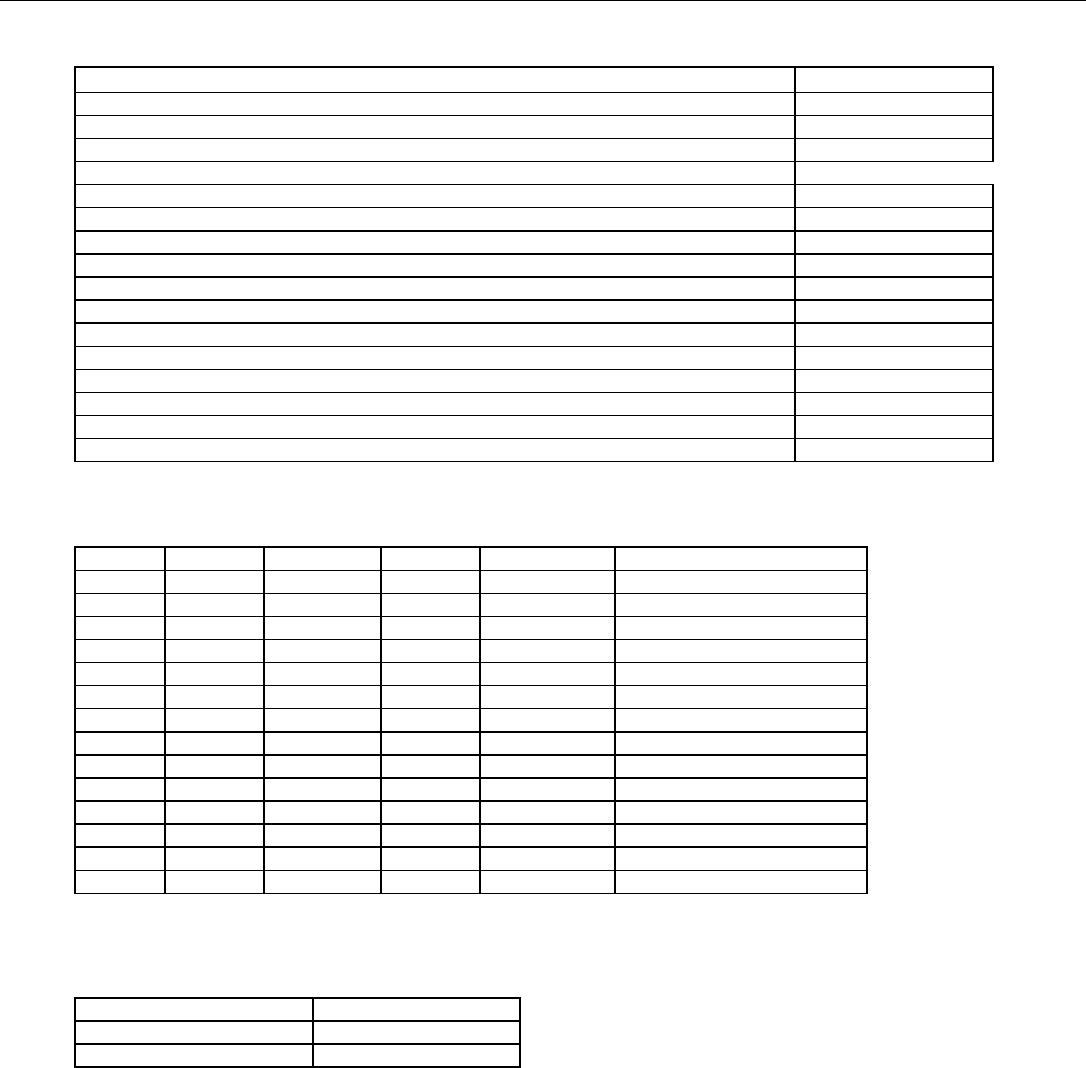
APX32EN Installation and Setup Guide
- 67 -
Programming Default Tables
Function Table 1
*78 Programmable Tone Generation Time 0
*80 Powerline Carrier Devices See *80 table
*81 Zone lists for devices See *81 table
*84 Assign zone voice descriptors
*86 Multi-mode (E-mail notification) 0
*87 Auxiliary Function/ 1-button paging 0
*88 Pager characters ---
*89 Event log 80% full report code 0,0
*90 Event logging 3
*91 Alarm audio verification/remote phone control 2
*92 Swinger shutdown 1
*93 Flexible call back 0
*94 Download phone number ---
*95 Ring detect count for downloading/remote phone control 15
Default Master Code 1,2,3,4
Default Duress Code ---
By activating *96, Field 43, and 44 will be changed to 15, 15, 15, 15.
✻56 ZONE ASSIGNMENT/ALARM REPORT CODES FOR TABLE 1
Zone No. Zone Type Alarm Code Input Type Loop Number Zone Descriptor
2 1 1,0 3 (RF) 2 47, 04 (FRONT DOOR)
3 1 1,0 3 (RF) 2 33, 04 (BACK DOOR)
4 3 1,0 3 (RF) 2 80 (WINDOW)
5 10 1,0 3 (RF) 1 56 (MOTION DETECTOR)
26 21 1,0 5 (BR) 3
27 22 1,0 5 (BR) 2
28 20 1,0 5 (BR) 4
29 23 0,0 5 (BR) 1
30 21 1,0 5 (BR) 3
31 22 1,0 5 (BR) 2
32 20 1,0 5 (BR) 4
33 23 0,0 5 (BR) 1
92 --- --- --- ---
99 6 1,0 --- ---
NOTE: Zone 2 to 41 are RF zones; Zone 92 is Duress; Zone 99 is keypad panic
✻81 ZONE LIST FOR OUTPUT DEVICES
DEFAULT TABLE: Applies To Default Table 1.
Zone List 1 28, 32
Zone List 2 29, 33
Zone List 3 2, 3
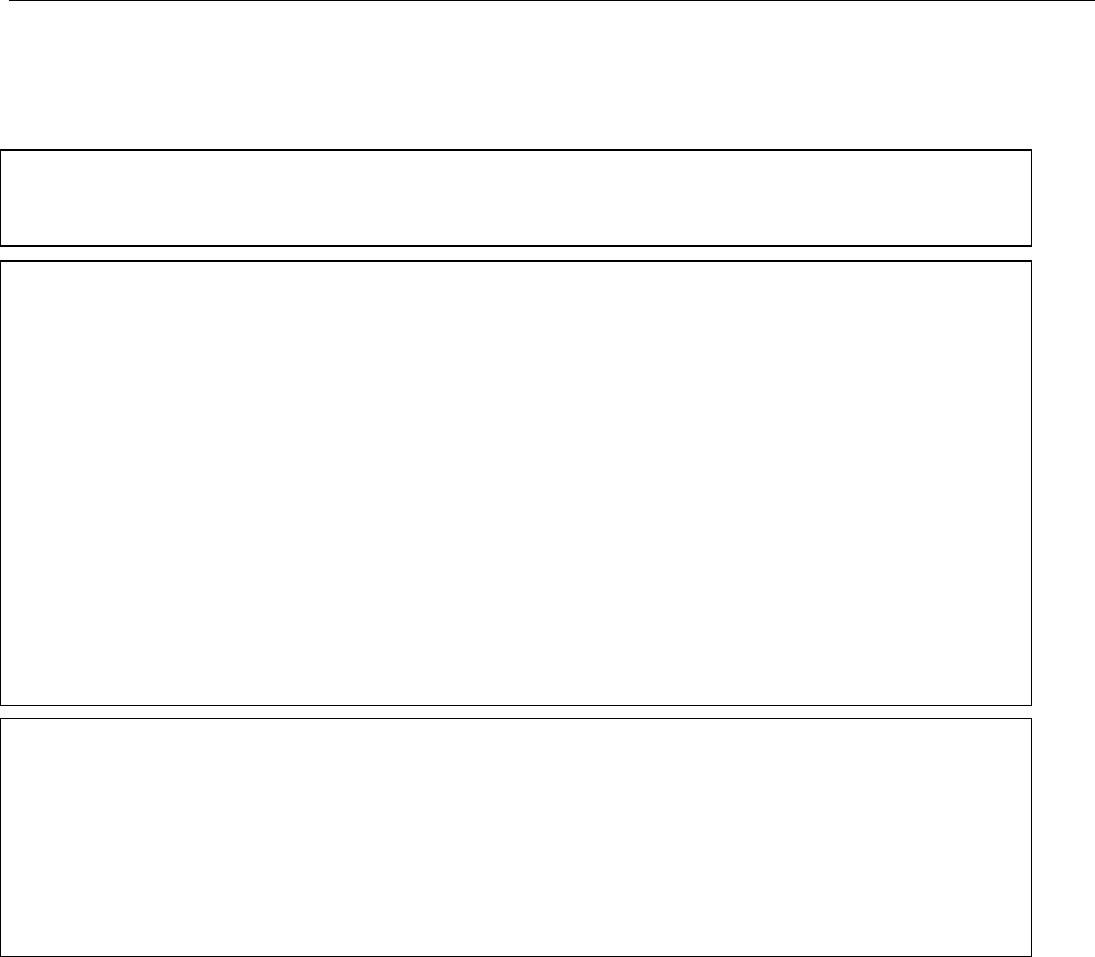
APX32EN Installation and Setup Guide
- 68 -
Regulatory Agency Statements
UL NOTICE: This is a "Grade A" residential system
FCC STATEMENT
THIS DEVICE COMPLIES WITH PART 15 OF FCC RULES. OPERATION IS SUBJECT TO THE FOLLOWING TWO CONDITIONS: (1) THIS
DEVICE MAY NOT CAUSE HARMFUL INTERFERENCE, AND (2) THIS DEVICE MUST ACCEPT ANY INTERFERENCE RECEIVED,
INCLUDING INTERFERENCE THAT MAY CAUSE UNDESIRED OPERATION.
Federal Communications Commission (FCC) Part 15 Statement
This equipment has been tested to FCC requirements and has been found acceptable for use. The FCC requires the following statement for
your information:
This equipment generates and uses radio frequency energy and if not installed and used properly, that is, in strict accordance with the
manufacturer's instructions, may cause interference to radio and television reception. It has been type tested and found to comply with the
limits for a Class B computing device in accordance with the specifications in Part 15 of FCC Rules, which are designed to provide
reasonable protection against such interference in a residential installation. However, there is no guarantee that interference will not occur in
a particular installation. If this equipment does cause interference to radio or television reception, which can be determined by turning the
equipment off and on, the user is encouraged to try to correct the interference by one or more of the following measures:
• If using an indoor antenna, have a quality outdoor antenna installed.
• Reorient the receiving antenna until interference is reduced or eliminated.
• Move the radio or television receiver away from the receiver/control.
• Move the antenna leads away from any wire runs to the receiver/control.
• Plug the receiver/control into a different outlet so that it and the radio or television receiver are on different
branch circuits.
If necessary, the user should consult the dealer or an experienced radio/television technician for additional suggestions. The user or installer
may find the following booklet prepared by the Federal Communications Commission helpful: "Interference Handbook." This booklet is
available from the U.S. Government Printing Office, Washington, DC 20402.
The user shall not make any changes or modifications to the equipment unless authorized by the Installation Instructions or User's Manual.
Unauthorized changes or modifications could void the user's authority to operate the equipment.
Federal Communications Commission (FCC) Part 68
This equipment complies with Part 68 of the FCC rules. On the front cover of this equipment is a label that contains the FCC registration
number and Ringer Equivalence Number (REN). You must provide this information to the telephone company when requested.
This equipment uses the following USOC jack: RJ31X
This equipment may not be used on telephone-company-provided coin service. Connection to party lines is subject to state tariffs.
This equipment is hearing-aid compatible.
Ringer Equivalence Number Notice:
The Ringer Equivalence Number (REN) assigned to each terminal device provides an indication of the maximum number of terminals
allowed to be connected to a telephone interface. The termination on an interface may consist of any combination of devices subject only to
the requirement that the sum of the Ringer Equivalence Numbers of all the devices does not exceed 5.

APX32EN Installation and Setup Guide
- 69 -
Specifications
APX32EN
Security
Controls
1. Physical: 10-3/8” W x 7-1/8” H x 1-3/4” D
2. Electrical:
VOLTAGE INPUT: 9VAC from plug-in 25VA transformer.
RECHARGEABLE BACKUP BATTERY: Nickel-metal hydride battery pack
rated at 7.7Vdc.
ALARM SOUNDER: Piezo = 6-14VDC, 30mA max/ Bell = 6-14VDC, 120mA max
(e.g., ADEMCO’s WAVE2EX).
3. Communication:
FORMATS SUPPORTED:
ADEMCO Express, 10 characters/sec, DTMF (TouchTone) Data Tones,
1400/2300Hz ACK, 1400Hz KISSOFF.
ADEMCO Contact ID® Reporting, 10 characters/sec., DTMF (TouchTone)
Data Tones, 1400/2300Hz ACK, 1400Hz KISSOFF.
ADEMCO Low Speed, 10 pulses/sec, 1900Hz Data Tone,
1400Hz ACK/KISSOFF.
Radionics/SESCOA, 20 pulses/sec, 1800Hz Data Tone, 2300Hz
ACK/KISSOFF. Can report 0–9, B–F.
Line Seize: Double Pole
Ringer Equivalence: 0.6B
FCC Registration No.: 5GBUSA-25623-AL-E

APX32EN Installation and Setup Guide
- 70 -
Contacting Technical Support
PLEASE, before you call Technical Support, be sure you:
• READ THE INSTRUCTIONS!
• Check all wiring connections.
• Determine that the power supply and/or backup battery are supplying proper
voltages.
• Verify your programming information where applicable.
• Note the proper model number of this product, and the version level (if known) along
with any documentation that came with the product.
• Note your ADEMCO customer number and/or company name.
Having this information handy will make it easier for us to serve you quickly and
effectively.
You may contact Technical Support via Toll Free Fax. Please include your return fax number. You
will receive a reply within 24 hours.
Technical Support: .......................................................... 1-800-645-7492 (8 a.m.-8 p.m. E.S.T.)
FAX FAXBACK Automated Fax Retrieval System: .............. 1-800-573-0153 or 1-516-921-6704 / ext. 1667
World Wide Web Address: ................................................ http://www.honeywell.com/security

APX32EN Installation and Setup Guide
- 71 -
– Notes –

APX32EN Installation and Setup Guide
- 72 -
– Notes –

APX32EN Installation and Setup Guide
- 73 -
– Index –
*56 Enhanced Zone Programming Mode .........14, 25, 30, 31
*80 Device Programming...................................................30
*80 Device Programming Menu Mode ...................36, 37, 38
*81 Zone List Menu Mode.............................................39, 40
*81 Zone Lists For Menu Mode ..........................................30
*83 Enhanced Sequential Mode ........... 30, 31, 34, 41, 43, 44
*84 Assign Zone Voice Descriptors................... 30, 35, 45, 46
*85 Record Custom Voice Descriptors..........................30, 47
*96 Initialize Download Id And Subscriber Acct. No. For
Downloading ...................................................................30
*97 Set All Program Fields To 1 Of 4 Sets Of Default
Values..............................................................................30
*98 Exits Programming Mode ............................................30
*99 Exits Programming Mode ............................................30
15 Second Dialer Delay.......................................................24
24-Hour Audible Alarm ......................................................19
24-Hour Silent Alarm ...................................................19, 54
5800 Series Transmitters ...................................................14
5800RF ..........................................................................14, 16
5801 .....................................................................................14
5802MN.........................................................................14, 15
5802MN2.............................................................................15
5804 .........................................................................14, 15, 41
5804BD..........................................................................14, 21
5804BDV ................................................................. 14, 15, 21
5804E ............................................................................14, 15
5816 ...............................................................................14, 41
5817 .....................................................................................14
5827 .........................................................................14, 16, 21
A
AC Loss Report Code ....................................................26, 67
AC Power.............................................................................12
AC Power and Rechargeable Backup Battery ...................13
AC Power Loss ....................................................................12
AC Restore Report Code .....................................................67
Ademco 1332/1332x10.........................................................12
Ademco Express............................................................23, 70
Ademco Low Speed .......................................................23, 70
Alarm Bell Timeout ......................................................22, 67
Alarm Output........................................................................5
Alarm Restore Codes ..........................................................67
Alarm Restore Report Code................................................26
Alarm Sounder....................................................................70
Alarmnet Radio And Internet Communication Devices......9
Arm Away/Stay Report Code........................................26, 67
Arm–Away ..........................................................................20
Armed System Test.............................................................60
Arm–Stay ............................................................................20
Assign (or Change) A Secondary Security Code ................54
Assign Custom Voice Descriptors.......................................47
Assign Zone Voice Descriptors .....................................45, 68
Audible Exit Warning/Quick Exit ......................................22
Audio Alarm Verification (AAV)/Remote Phone Control...29
Audio Alarm Verification (Two-Way Voice Feature) .........57
Aux Function.......................................................................56
Aux Function/1-Button Paging.....................................28, 68
Aux Key...............................................................................28
Away Mode..........................................................................55
B
Babysitter Code .................................................................. 54
Back Plate............................................................................. 6
Backlighting ....................................................................... 21
Backup Battery................................................................... 12
Backup Reporting............................................................... 22
Battery Life ........................................................................ 14
Bell...................................................................................... 70
BR ................................................................................. 14, 32
Burglary Zones ................................................................... 21
Busy-Standby ..................................................................... 63
Button Transmitters .................................................... 14, 15
Button Type........................................................................ 32
Button Zones....................................................................... 32
Bypass................................................................................. 59
Bypass Report Code ..................................................... 26, 67
Bypass Restore Report Code ........................................ 26, 67
C
Callback Number................................................................ 29
Cancel Report Code ............................................................ 67
Canceled Alarm .................................................................. 26
Change The Master Code................................................... 54
Chime by Zone .............................................................. 21, 67
Chime Mode.................................................................. 21, 55
Closing Report .................................................................... 22
Communication .................................................................... 5
Communication Overview.................................................. 61
Compass Downloader ......................................................... 52
Confirmation of Arming Ding ...................................... 22, 67
Connecting AC Power And Backup Battery...................... 12
Contact ID .......................................................................... 61
Contact ID Event Codes..................................................... 62
Contact ID Format ....................................................... 26, 54
Contact ID Reporting ................................................... 62, 70
Contacting Technical Support ........................................... 71
Custom Descriptor Number ............................................... 47
Custom Voice Descriptors ............................................ 30, 47
D
Data Encryption ................................................................. 52
Data Field ........................................................................... 17
Daylight Savings Time Start/End................................ 21, 67
Default Master Code .......................................................... 68
Delete a Secondary Security Code ..................................... 54
Delete Entire Zone List...................................................... 40
Delete Zone Parameters Confirmation ........................ 33, 44
Delete Zones ....................................................................... 40
Delete Zones From List ...................................................... 40
Descriptor ..................................................................... 35, 45
Desktop Mounting ................................................................ 6
Device Action ...................................................................... 38
Device Number ................................................................... 38
Dip Switches....................................................................... 14
Disable Local Sounder.......................................................... 8
Disarm .......................................................................... 20, 55
Download Call Back Phone Number ................................. 29
Download Phone Number .................................................. 68
Download, Initial................................................................ 52
Downloader............................................................. 28, 52, 53
Duress Code.................................................................. 54, 68
Dynamic Signaling ............................................................. 27

APX32EN Installation and Setup Guide
- 74 -
E
Encrypted (High-Security) Devices ........................ 15, 16, 33
Enroll Mode...................................................................34, 43
Enter/Change The Master Code.........................................54
Entry Delay ............................................................ 22, 63, 67
Entry/Exit Burglary............................................................19
Error Code 374....................................................................26
Event Log 80% Full Report Code .................................28, 68
Event Logging ...............................................................28, 68
Event Logging, Options ......................................................29
Exit Alarm...........................................................................26
Exit Delay ...............................................................22, 63, 67
Exit Delay Restart ........................................................22, 55
Exit Door .............................................................................22
Exit Error Alarm.................................................................63
Exit Error Report Code.................................................26, 67
Exit Warning.......................................................................22
Exiting Program Mode........................................................18
Expert Programming ..........................................................17
Express................................................................................61
External Sounder................................................................22
F
Factory Defaults .................................................................18
Fault ..............................................................................59, 63
FC ........................................................................................61
FCC Statement ...................................................................69
Features ................................................................................5
Fire Sounder Timeout...................................................21, 67
First Test Report Offset................................................24, 67
Flexible Callback ....................................................29, 52, 68
Follow Me Alarm Announcement.......................................58
Follow Me\ Reminder Feature...........................................58
Follow Me Reminder” Phone Number................................23
Forced Bypass ......................................................... 21, 56, 67
G
General Information ...........................................................14
General Programming Information....................................17
Go/No Go Test Mode ...........................................................15
GSMVL Communications Device .......................................11
H
Handshake Frequency ........................................................61
Hayes...................................................................................52
House ID .................................................................16, 21, 37
House Identification ...........................................................14
I
Input Type...............................................................14, 32, 68
Installer Code..........................................................21, 54, 67
Interactive Mode .................................................................18
Interior w/Delay..................................................................20
Interior, Follower ................................................................19
K
Keypad Backlight Timeout...........................................21, 67
Keypad Functions .........................................................55, 56
Keys.....................................................................................14
Kissoff Frequency ...............................................................61
L
Lack of Usage Notification................................................. 24
Long Range Radio .............................................................. 28
Loop and Serial Number .................................................... 33
Loop Number ................................................................ 33, 68
Low Battery Report Code............................................. 26, 67
Low Battery Restore Report Code ............................... 27, 67
Low Speed........................................................................... 61
LYNX-DM............................................................................. 6
LYNXRCHKIT-HC............................................................. 13
LYNXRCHKIT -SC............................................................. 13
M
Macro Function................................................................... 28
Master Code........................................................................ 54
Master Security Code......................................................... 21
Memory of Alarm................................................................ 55
Message .............................................................................. 59
Message Center .................................................................. 55
Modem Comm..................................................................... 63
Mounting Base...................................................................... 6
Mute System Announcements ........................................... 55
N
No Alarm Response ............................................................ 20
No Delay ............................................................................. 55
Number Of Reports In Armed Period................................ 29
O
Open Report Code......................................................... 26, 67
Operator Commands .......................................................... 57
Optima 24 Plus Fax96 Modem........................................... 52
Other Features ..................................................................... 5
Other Functions ................................................................. 55
P
PABX Access Code........................................................ 22, 67
Pager................................................................................... 24
Pager Characters.......................................................... 28, 68
Pager Function ................................................................... 56
Pager Message.................................................................... 28
Pager Report Format.......................................................... 24
Paging Feature ................................................................... 28
Panic Keys .......................................................................... 54
Perimeter Burglary ............................................................ 19
Periodic Test Report..................................................... 24, 67
Phone System Select .................................................... 23, 67
Piezo.................................................................................... 70
Play Back A Message ......................................................... 55
Plug-In Transformer .......................................................... 12
Power Up In Previous State......................................... 22, 67
Powerline Carrier Device ............................21, 36, 37, 58, 68
Powerline Carrier Device House Code............................... 67
Powerline Carrier Device Programming ........................... 38
Primary Phone Number ............................................... 22, 67
Primary Subscriber Account Number.......................... 23, 67
Program Mode, Entering.................................................... 17
Programming Default Tables....................................... 67, 68
Q
Quick Arm .......................................................................... 55
Quick Arm Enable........................................................ 21, 67
Quick Exit........................................................................... 22

APX32EN Installation and Setup Guide
- 75 -
R
Radionics .............................................................................23
Radionics/Sescoa.................................................................70
Range...................................................................................14
Real Time Clock Display...............................................21, 67
Rec .......................................................................................59
Record A Message...............................................................55
Redundant Reporting/Dynamic Signaling Delay.........28, 67
Remote Phone Access..........................................................29
Remote Phone Control ........................................................56
Remote Programming.........................................................52
Remote Programming/Control......................................52, 53
Replacing The Rechargeable Battery.................................13
Report Code...................................................................25, 32
Report Code Formats..........................................................61
Report Format...............................................................23, 67
Restart Exit Delay ........................................................22, 55
RF ........................................................................................32
RF (Supervised Rf)..............................................................14
RF House ID Code ........................................................21, 67
RF Transmitter Low Battery Report Code ..................26, 67
RF Transmitter Low Battery Restore ................................67
RF Transmitter Low Battery Restore Code .......................27
RF Jam ................................................................................25
Ring Detect Count For Downloading ...........................29, 68
S
Scheduling.....................................................................53, 55
Secondary Phone Number ............................................23, 67
Secondary Subscriber Account Number.......................23, 67
Secondary User Codes ........................................................54
Security Code Handshake ..................................................52
Security Codes ..............................................................21, 54
Security Functions..............................................................55
Serial Number....................................... 30, 31, 33, 34, 41, 44
Sescoa/Rad ..........................................................................61
Sescoa/Radionics Select .......................................... 24, 25, 67
Setting Dip Switches ..........................................................16
SH10a..................................................................................38
Signal Strength...................................................................15
Silent Burglary ...................................................................20
Single Alarm Sounding Per Zone .................................21, 67
Siren/Horn...........................................................................38
Site-Initiated Remote Programming..................................52
Smartmodem 1200 ..............................................................52
Smoke Detectors .................................................................65
Sniffer Mode............................................................ 15, 60, 64
Special Features....................................................................5
Specifications ......................................................................70
Split/Dual Reporting.....................................................24, 67
Start By Event ....................................................................36
Start By Zone Type .............................................................36
Start Event Type.................................................................38
Start Zone List ....................................................................38
Start Zone Type ..................................................................38
Station-Initiated Remote Programming ............................52
Stay Mode............................................................................55
Stop Recording....................................................................55
Stop Zone List .....................................................................38
Stop Zone Type....................................................................38
Supervised Fire...................................................................20
Supervised Rf................................................................14, 32
System Battery ...................................................................64
System Communication......................................................61
System Features ...................................................................5
System Operation ............................................. 36, 37, 54, 68
System Power ....................................................................... 5
System Words..................................................................... 46
T
Technical Support .............................................................. 71
Telco Handoff...................................................................... 52
Temporal Pulse................................................................... 21
Test Mode ..........................................................55, 60, 64, 65
Test Report Code .......................................................... 26, 67
Test Restore Report Code................................................... 67
Testing the System............................................................. 60
Time and Date .................................................................... 55
Transmitter Loop Numbers ............................................... 16
Transmitter Supervision.................................................... 14
Transmitters....................................................................... 14
Trouble By Day/.................................................................. 19
Trouble Conditions............................................................. 63
Trouble Report Code..................................................... 26, 67
Trouble Restore Report Code ....................................... 26, 67
Troubleshooting Guide ....................................................... 63
U
Unsupervised Button RF ................................................... 14
Unsupervised RF................................................................ 14
UR (Unsupervised RF) ................................................. 14, 32
User Codes...................................................................... 5, 55
V
Voice Descriptor ..................................................... 32, 34, 45
Voice Prompt Programming Mode..................................... 17
Voice Vocabulary Index...................................................... 46
Voltage Input...................................................................... 70
Volume Control................................................................... 55
W
Wall Mounting...................................................................... 6
WAVE2EX .......................................................................... 70
Wireless Buttons ................................................................ 14
Wireless Transmitter ......................................................... 26
Wiring Connections .............................................................. 8
World Wide Web Address................................................... 71
X
X10 ................................................................................ 53, 58
Z
Zone Bypass........................................................................ 55
Zone Descriptor .................................................................. 68
Zone Entry To List ............................................................. 40
Zone List Number............................................................... 40
Zone List Programming ..................................................... 40
Zone Lists ..................................................................... 30, 68
Zone Number .......................................................... 32, 42, 45
Zone Programming............................................................. 67
Zone Response Type ..................................................... 19, 20
Zone Type............................................................................ 32
Zones and Devices ................................................................ 5

APX32EN Installation and Setup Guide
- 76 -

APX32EN Installation and Setup Guide
- 77 -
WARNING
THE LIMITATIONS OF THIS ALARM SYSTEM
While this System is an advanced design security system, it does not offer guaranteed protection against burglary, fire or
other emergency. Any alarm system, whether commercial or residential, is subject to compromise or failure to warn for a
variety of reasons. For example:
• Intruders may gain access through unprotected openings or have the technical sophistication to bypass an alarm sensor or
disconnect an alarm warning device.
• Intrusion detectors (e.g., passive infrared detectors), smoke detectors, and many other sensing devices will not work
without power. Battery-operated devices will not work without batteries, with dead batteries, or if the batteries are not put
in properly. Devices powered solely by AC will not work if their AC power supply is cut off for any reason, however briefly.
• Signals sent by wireless transmitters may be blocked or reflected by metal before they reach the alarm receiver. Even if the
signal path has been recently checked during a weekly test, blockage can occur if a metal object is moved into the path.
• A user may not be able to reach a panic or emergency button quickly enough.
• While smoke detectors have played a key role in reducing residential fire deaths in the United States, they may not
activate or provide early warning for a variety of reasons in as many as 35% of all fires, according to data published by the
Federal Emergency Management Agency. Some of the reasons smoke detectors used in conjunction with this System may
not work are as follows. Smoke detectors may have been improperly installed and positioned. Smoke detectors may not
sense fires that start where smoke cannot reach the detectors, such as in chimneys, in walls, or roofs, or on the other side of
closed doors. Smoke detectors also may not sense a fire on another level of a residence or building. A second floor detector,
for example, may not sense a first floor or basement fire. Finally, smoke detectors have sensing limitations. No smoke
detector can sense every kind of fire every time. In general, detectors may not always warn about fires caused by
carelessness and safety hazards like smoking in bed, violent explosions, escaping gas, improper storage of flammable
materials, overloaded electrical circuits, children playing with matches, or arson. Depending on the nature of the fire
and/or location of the smoke detectors, the detector, even if it operates as anticipated, may not provide sufficient warning to
allow all occupants to escape in time to prevent injury or death.
• Passive Infrared Motion Detectors can only detect intrusion within the designed ranges as diagrammed in their
installation manual. Passive Infrared Detectors do not provide volumetric area protection. They do create multiple beams
of protection, and intrusion can only be detected in unobstructed areas covered by those beams. They cannot detect motion
or intrusion that takes place behind walls, ceilings, floors, closed doors, glass partitions, glass doors, or windows.
Mechanical tampering, masking, painting or spraying of any material on the mirrors, windows or any part of the optical
system can reduce their detection ability. Passive Infrared Detectors sense changes in temperature; however, as the
ambient temperature of the protected area approaches the temperature range of 90° to 105°F (32° to 40°C), the detection
performance can decrease.
• Alarm warning devices such as sirens, bells or horns may not alert people or wake up sleepers if they are located on the
other side of closed or partly open doors. If warning devices are located on a different level of the residence from the
bedrooms, then they are less likely to waken or alert people inside the bedrooms. Even persons who are awake may not
hear the warning if the alarm is muffled by noise from a stereo, radio, air conditioner or other appliance, or by passing
traffic. Finally, alarm warning devices, however loud, may not warn hearing-impaired people.
• Telephone lines needed to transmit alarm signals from a premises to a central monitoring station may be out of service or
temporarily out of service. Telephone lines are also subject to compromise by sophisticated intruders.
• Even if the system responds to the emergency as intended, however, occupants may have insufficient time to protect
themselves from the emergency situation. In the case of a monitored alarm system, authorities may not respond
appropriately.
• This equipment, like other electrical devices, is subject to component failure. Even though this equipment is designed to
last as long as 10 years, the electronic components could fail at any time.
The most common cause of an alarm system not functioning when an intrusion or fire occurs is inadequate maintenance. This
alarm system should be tested weekly to make sure all sensors and transmitters are working properly. The security keypad
(and remote keypad) should be tested as well.
Wireless transmitters (used in some systems) are designed to provide long battery life under normal operating conditions.
Longevity of batteries may be as much as 4 to 7 years, depending on the environment, usage, and the specific wireless device
being used. External factors such as humidity, high or low temperatures, as well as large swings in temperature, may all reduce
the actual battery life in a given installation. This wireless system, however, can identify a true low battery situation, thus
allowing time to arrange a change of battery to maintain protection for that given point within the system.
Installing an alarm system may make the owner eligible for a lower insurance rate, but an alarm system is not a substitute for
insurance. Homeowners, property owners and renters should continue to act prudently in protecting themselves and continue to
insure their lives and property.
We continue to develop new and improved protection devices. Users of alarm systems owe it to themselves and their loved ones
to learn about these developments.

APX32EN Installation and Setup Guide
- 78 -
UL NOTICES
1. For UL Residential Burglar Alarm installations with line security, total exit delay time must not
exceed 60 seconds. For UL Burglar Alarm installations without line security (Grade A), total exit
delay time must not exceed 120 seconds.
2. Periodic testing (see scheduling mode) must be at least every 24 hours.
3. Alarm Sounder plus Auxiliary Power currents must not exceed 600mA total for UL installations
(Aux power 500mA max.).
4. Remote downloading without an alarm company technician on-site (unattended downloading) is
not permissible for UL installations.
5. Auto-disarming is not a UL Listed feature.
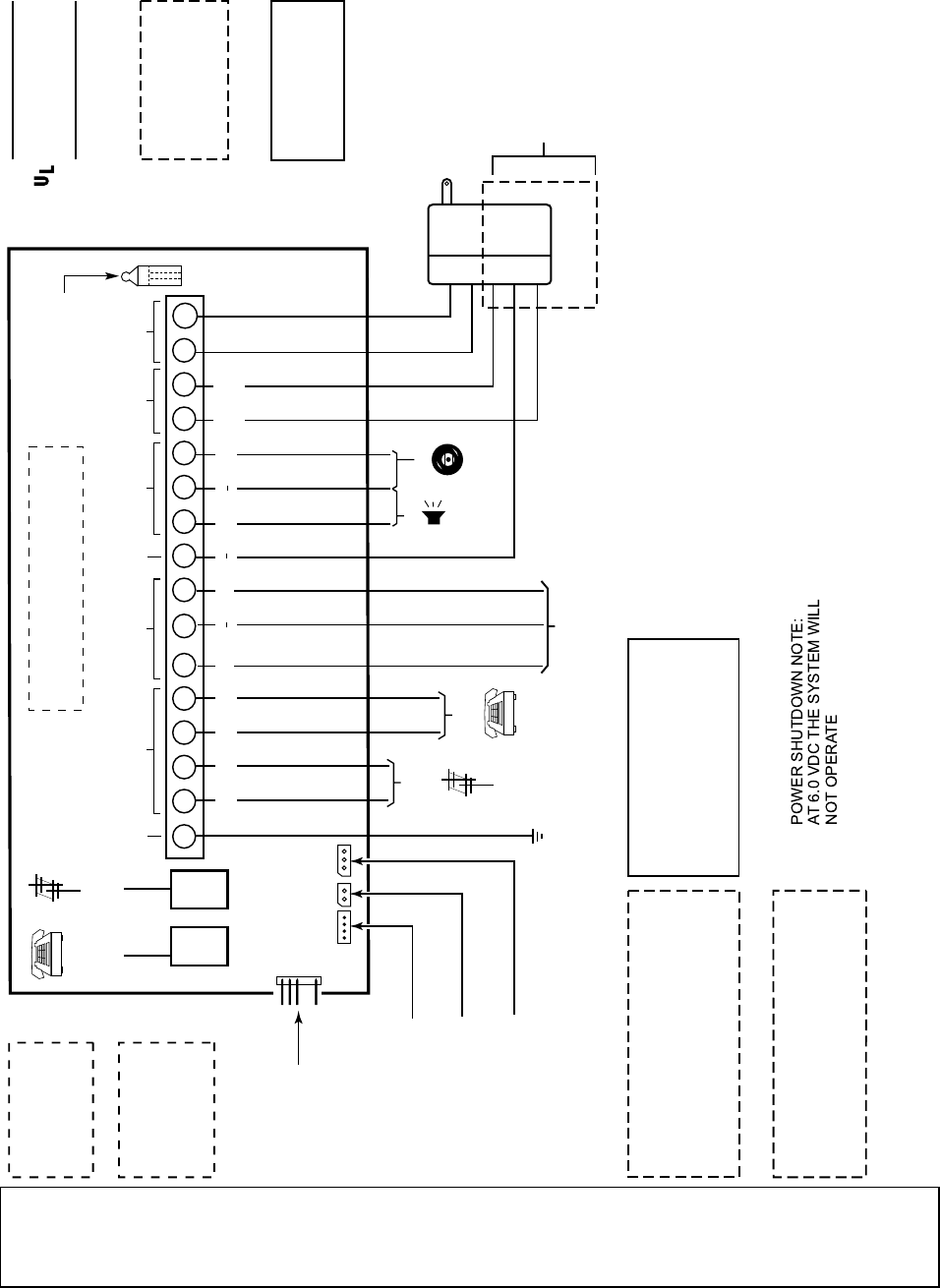
- 79 -
WEEKLY TESTING IS
REQUIRED TO ENSURE
PROPER OPERATION
OF THIS SYSTEM
PREMISES
TELEPHONE
K10145X10 PLUG-IN
TRANSFORMER
9VAC, 25VA
EARTH
GROUND
INCOMING
TELEPHONE
LINE
RING
TIP
RING
TIP ( ) ( ) (+)
(+)
( )
TO 24HR 110VAC
UNSWITCHED
OUTLET
PIEZO
6-14VDC
120mA max.
(e.g. WAVE2EX)
6-14VDC
30mA max.
DATA
OUT
SYNC
IN
POWERLINE
CARRIER DEVICES
GND
AC
AC
SYNC
COM
DATA
BELL
THIS DEVICE COMPLIES WITH PART 15 OF FCC RULES.
OPERATION IS SUBJECT TO THE FOLLOWING TWO
CONDITIONS: (1) THIS DEVICE MAY NOT CAUSE
HARMFUL INTERFERENCE, AND (2) THIS DEVICE MUST
ACCEPT ANY INTERFERENCE RECEIVED, INCLUDING
INTERFERENCE THAT MAY CAUSE UNDESIRED
OPERATION.
THIS EQUIPMENT SHOULD BE INSTALLED IN
ACCORDANCE WITH THE NATIONAL FIRE PROTECTION
ASSOCIATION STANDARDS ANSI/NFPA 70 NATONAL
ELECTRIC CODE AND NFPA 72 NATIONAL FIRE ALARM
CODE, CHAPTER 2 (NATIONAL FIRE PROTECTION ASSOC.,
BATTERYMARCH PARK, QUINCY, MA 02269). PRINTED
INFORMATION DESCRIBING PROPER INSTALLATION,
EVACUATION PLANNING AND REPAIR SERVICE IS TO BE
PROVIDED WITH THIS EQUIPMENT.
X10 ONLY
CONNECTIONS
FCC ID: CFS8DLLYNXREN-3
(LYNXR-I) COMPLIES WITH
FCC RULES, PART 68 FCC
REGISTRATION
No. 5GBUSA-25623-AL-E
RINGER EQUIVALENCE: 0.6B
NOTE
USE ONLY THE K10145X10
CLASS 2
TRANSFORMERS
PROVIDED
APX32EN SUMMARY OF CONNECTIONS
THE APX32EN CONTROL IS COMPATIBLE WITH
THE FOLLOWING INTEGRAL RECHARGEABLE
BATTERY PACKS:
EXTERNAL SOUNDERS AND
POWERLINE CARRIER
DEVICES HAVE NOT BEEN
EVALUATED BY UL.
FUTURE USE
REPLACE EVERY FOUR YEARS
P/N LYNXRCHKIT-SC
P/N LYNXRCHKIT-HC
P/N LYNXRCHKIT-SHA
DATA I N
DATA OUT
*WHEN AVAILABLE
INCOMING
PHONE
LINE
TO
HANDSET
PHONE
LINE
WARNING:
TO PREVENT RISK OF
SHOCK DISCONNECT
TELEPHONE LINE
AT TELECOM JACK
BEFORE SERVICING
THIS UNIT.
ALL OUTPUT CIRCUITS ARE POWER LIMITED.
123486
511
710 12 15 16
13 14
PHONE
FUTURE
USE SOUNDERS PLCD AC
EARTH
GROUND
RING
TIP
RING
TIP ( ) ( ) (+)
(+)( ) DATA
OUT
SYNC
IN
RJ11
8
POS
JACK
9
09012-012-V1
GND
LOCAL SOUNDER
DISABLE SHUNT
REMOVE TO DISABLE
UL NOTE
THE MINIMUM WIRE SIZE USED FOR TELEPHONE
INSTALLATIONS MUST BE #26 GAUGE
SUPER HIGH-CAPACITY
BATTERY CONNECTOR
7845i-L
CONNECTIONS
PORT
GSMVL
COMMUNICATIONS
PORT
STANDARD
HIGH-CAPACITY
BATTERY CONNECTOR
UL INSTALLATIONS
THE MINIMUM WIRE
SIZE USED FOR
TELEPHONE
INSTALLATIONS
MUST BE #26 GAUGE
Notes: Connection of the fire alarm signal to a fire alarm headquarters or a central station shall be permitted with the
approval of the local authority having jurisdiction. The burglar alarm signal shall not be connected to a police
emergency number.
The System must be checked by a qualified technician once every three years.

LIMITED WARRANTY
Honeywell International Inc. acting through its Security & Custom Electronics business ("Seller"), 2
Corporate Center Drive, Melville, New York 11747, warrants its products to be in conformance with its own
plans and specifications and to be free from defects in materials and workmanship under normal use and
service for 24 months from the date stamp control on the product or, for products not having an Ademco date
stamp, for 12 months from date of original purchase unless the installation instructions or catalog sets forth
a shorter period, in which case the shorter period shall apply. Seller's obligation shall be limited to repairing
or replacing, at its option, free of charge for materials or labor, any product, which is proved not in
compliance with Seller's specifications or proves defective in materials or workmanship under normal use
and service. Seller shall have no obligation under this Limited Warranty or otherwise if the product is
altered or improperly repaired or serviced by anyone other than Honeywell factory service. Connection of
any device(s) to a communicating bus of a Honeywell security system (e.g., keypad bus, polling loop) other
than those manufactured or approved by Honeywell shall void this warranty. For warranty service, return
product(s) transportation prepaid, to your local authorized Honeywell representative.
THERE ARE NO WARRANTIES, EXPRESS OR IMPLIED, OF MERCHANTABILITY, OR FITNESS FOR
A PARTICULAR PURPOSE OR OTHERWISE, WHICH EXTEND BEYOND THE DESCRIPTION ON THE
FACE HEREOF. IN NO CASE SHALL SELLER BE LIABLE TO ANYONE FOR ANY CONSEQUENTIAL
OR INCIDENTAL DAMAGES FOR BREACH OF THIS OR ANY OTHER WARRANTY, EXPRESS OR
IMPLIED, OR UPON ANY OTHER BASIS OF LIABILITY WHATSOEVER, EVEN IF THE LOSS OR
DAMAGE IS CAUSED BY THE SELLER'S OWN NEGLIGENCE OR FAULT.
Seller does not represent that the products it sells may not be compromised or circumvented; that the
products will prevent any personal injury or property loss by burglary, robbery, fire or otherwise; or that the
products will in all cases provide adequate warning or protection. Customer understands that a properly
installed and maintained alarm may only reduce the risk of a burglary, robbery, fire or other events
occurring without providing an alarm, but it is not insurance or a guarantee that such will not occur or that
there will be no personal injury or property loss as a result. CONSEQUENTLY, SELLER SHALL HAVE NO
LIABILITY FOR ANY PERSONAL INJURY, PROPERTY DAMAGE OR OTHER LOSS BASED ON A
CLAIM THE PRODUCT FAILED TO GIVE WARNING. HOWEVER, IF SELLER IS HELD LIABLE,
WHETHER DIRECTLY OR INDIRECTLY, FOR ANY LOSS OR DAMAGE ARISING UNDER THIS
LIMITED WARRANTY OR OTHERWISE, REGARDLESS OF CAUSE OR ORIGIN, SELLER'S MAXIMUM
LIABILITY SHALL NOT IN ANY CASE EXCEED THE PURCHASE PRICE OF THE PRODUCT, WHICH
SHALL BE THE COMPLETE AND EXCLUSIVE REMEDY AGAINST SELLER. This warranty replaces
any previous warranties and is the only warranty made by Seller on this product. No increase or alteration,
written or verbal, of the obligations of this Limited Warranty is authorized.
5132 North 300 West
Provo, Utah 84604
(800) 216-5232
www.apxalarm.com
‡PREK14117-8RŠ
PREK14114-8 11/07 Rev. A